19.1: Measuring Output Using GDP
19.1.1: Defining GDP
Gross domestic product is the market value of all final goods and services produced within the national borders of a country for a given period of time.
Learning Objective
Distinguish between the income and expenditure approaches of assessing GDP
Key Points
- GDP can be measured using the expenditure approach: Y = C + I + G + (X – M).
- GDP can be determined by summing up national income and adjusting for depreciation, taxes, and subsidies.
- GDP can be determined in two ways, both of which, in principle, give the same result.
Key Term
- GDP
-
Gross domestic product (GDP) is the market value of all officially recognized final goods and services produced within a country in a given period of time.
Gross domestic product (GDP) is the market value of all final goods and services produced within the national borders of a country for a given period of time. GDP can be determined in multiple ways. The income approach and the expenditure approach highlighted below should yield the same final GDP number .
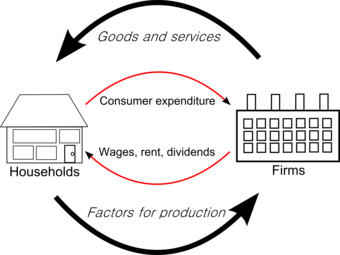
Simple view of expenditures
In an economy, households receive wages that they then use to purchase final goods and services. Since wages eventually are used in consumption (C), the expenditure approach to calculating GDP focuses on the end consumption expenditure to avoid double counting. The income approach, alternatively, would focus on the income made by households as one of its components to derive GDP.
Expenditure Approach
The expenditure approach attempts to calculate GDP by evaluating the sum of all final good and services purchased in an economy. The components of U.S. GDP identified as “Y” in equation form, include Consumption (C), Investment (I), Government Spending (G) and Net Exports (X – M).
Y = C + I + G + (X − M) is the standard equational (expenditure) representation of GDP.
- “C” (consumption) is normally the largest GDP component in the economy, consisting of private expenditures (household final consumption expenditure) in the economy. Personal expenditures fall under one of the following categories: durable goods, non-durable goods, and services.
- “I” (investment) includes, for instance, business investment in equipment, but does not include exchanges of existing assets. Spending by households (not government) on new houses is also included in Investment. “Investment” in GDP does not mean purchases of financial products. It is important to note that buying financial products is classed as ‘saving,’ as opposed to investment.
- “G” (government spending) is the sum of government expenditures on final goods and services. It includes salaries of public servants, purchase of weapons for the military, and any investment expenditure by a government. However, since GDP is a measure of productivity, transfer payments made by the government are not counted because these payment do not reflect a purchase by the government, rather a movement of income. They are captured in “C” when the payments are spent.
- “X” (exports) represents gross exports. GDP captures the amount a country produces, including goods and services produced for other nations’ consumption, therefore exports are added.
- “M” (imports) represents gross imports. Imports are subtracted since imported goods will be included in the terms “G”, “I”, or “C”, and must be deducted to avoid counting foreign supply as domestic.
Income Approach
The income approach looks at the final income in the country, these include the following categories taken from the U.S. “National Income and Expenditure Accounts”: wages, salaries, and supplementary labor income; corporate profits interest and miscellaneous investment income; farmers’ income; and income from non-farm unincorporated businesses. Two non-income adjustments are made to the sum of these categories to arrive at GDP:
- Indirect taxes minus subsidies are added to get from factor cost to market prices.
- Depreciation (or Capital Consumption Allowance) is added to get from net domestic product to gross domestic product.
19.1.2: Learning from GDP
GDP is a measure of national income and output that can be used as a comparison tool.
Learning Objective
Explain how GDP is calculated.
Key Points
- The output approach focuses on finding the total output of a nation by directly finding the total value of all goods and services a nation produces.
- The income approach equates the total output of a nation to the total factor income received by residents or citizens of the nation.
- The expenditure approach is basically an output accounting method. It focuses on finding the total output of a nation by finding the total amount of money spent.
Key Terms
- gross national product
-
The total market value of all the goods and services produced by a nation (citizens of a country, whether living at home or abroad) during a specified period.
- gross domestic product
-
A measure of the economic production of a particular territory in financial capital terms over a specific time period.
There are two commonly used measures of national income and output in economics, these include gross domestic product (GDP) and gross national product (GNP). These measures are focused on counting the total amount of goods and services produced within some “boundary” where the boundary is defined by either geography or citizenship.
Since GDP measures income and output, it can be used to compare two countries. The country with higher GDP is often regarded as wealthier, but, when using GDP to compare countries, it is important to remember to adjust for population.
GDP
GDP limits its focus to the value of goods or services in an actual geographic boundary of a country, where GNP is focused on the value of goods or services specifically attributable to citizens or nationality, regardless of where the production takes place. Over time GDP has become the standard metric used in national income reporting and most national income reporting and country comparisons are conducted using GDP.
GDP can be evaluated by using an output approach, income approach, or expenditure approach.
Output Approach
The output approach focuses on finding the total output of a nation by directly finding the total value of all goods and services a nation produces. Because of the complication of the multiple stages in the production of a good or service, only the final value of a good or service is included in the total output. This avoids an issue referred to as double counting, where the total value of a good is included several times in national output, by counting it repeatedly in several stages of production.
For example, in meat production, the value of the good from the farm may be $10, then $30 from the butchers, and then $60 from the supermarket. The value that should be included in final national output should be $60, not the sum of all those numbers, $90.
Formula: GDP (gross domestic product) at market price = value of output in an economy in the particular year – intermediate consumption at factor cost = GDP at market price – depreciation + NFIA (net factor income from abroad) – net indirect taxes.
Income Approach
The income approach equates the total output of a nation to the total factor income received by residents or citizens of the nation. The main types of factor income are:
- Employee compensation (cost of fringe benefits, including unemployment, health, and retirement benefits);
- Interest received net of interest paid;
- Rental income (mainly for the use of real estate) net of expenses of landlords;
- Royalties paid for the use of intellectual property and extractable natural resources.
All remaining value added generated by firms is called the residual or profit or business cash flow.
Formula: GDI (gross domestic income, which should equate to gross domestic product) = Compensation of employees + Net interest + Rental & royalty income + Business cash flow
Expenditure Approach
The expenditure approach is basically an output accounting method. It focuses on finding the total output of a nation by finding the total amount of money spent. This is acceptable, because like income, the total value of all goods is equal to the total amount of money spent on goods. The basic formula for domestic output takes all the different areas in which money is spent within the region, and then combines them to find the total output .
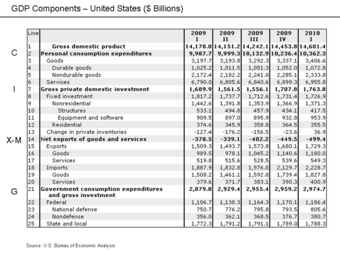
U.S. GDP Components
The components of GDP include consumption, investment, government spending, and net exports (exports minus imports).
Formula: Y = C + I + G + (X – M) ; where: C = household consumption expenditures / personal consumption expenditures, I = gross private domestic investment, G = government consumption and gross investment expenditures, X = gross exports of goods and services, and M = gross imports of goods and services.
19.1.3: The Circular Flow and GDP
In economics, the “circular flow” diagram is a simple explanatory tool of how the major elements in an economy interact with one another.
Learning Objective
Evaluate the effect of the circular flow on GDP
Key Points
- In the circular flow model, the household sector, provides various factors of production such as labor and capital, to producers who in turn produce goods and services.
- Firms provide consumers with goods and services in exchange for consumer expenditure and “factors of production” from households.
- Investment is equal to savings and is the income not spent but available to both consumers and firms for the purchase of capital investments, such as buildings, factories and homes.
- A portion of income is also allocated to taxes (income is taxed and the remaining is either consumed and or saved); government spending, G, is based on the tax revenue, T.
- The continuous flow of production, income and expenditure is known as circular flow of income; it is circular because it has neither any beginning nor an end.
Key Terms
- Factors of production
-
In economics, factors of production are inputs. They may also refer specifically to the primary factors, which are stocks including land, labor, and capital goods applied to production.
- circular flow
-
A model of market economy that shows the flow of dollars between households and firms.
In economics, the “circular flow” diagram is a simple explanatory tool of how the major elements as defined by the equation Y = Consumption + Investment + Government Spending + (Exports – Imports). interact with one another. Circular flow is basically a continuous loop that for any point and time yields the value “Y” otherwise defined as the sum of final good and services in an economy, or gross domestic product (GDP) .
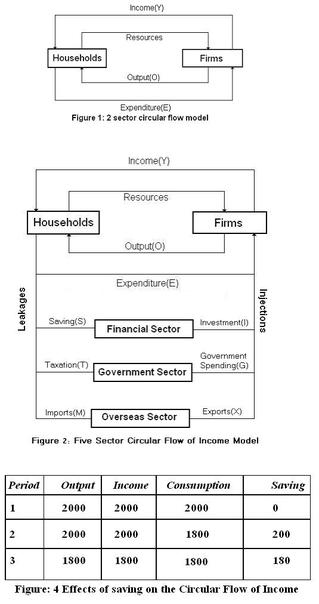
Circular flow
The circular flow is a simplified view of the economy that provides an ability to assess GDP at a specific point in time.
In the circular flow model, the household sector, provides various factors of production such as labor and capital, to producers who in turn produce goods and services. Firms compensate households for resource utilized and households pay for goods and services purchased from firms. This portion of the circular flow contributes to expenditures on consumption, C and generates income, which is the basis for savings (equal to investment) and government spending (tax revenue generated from income).
Investment, I, is equal to savings and is the income not spent but available to both consumers and firms for the purchase of capital investments, such as buildings, factories and homes. I represents an expenditure on investment capital.
Income generated in the relationship between firms and households is taxed and the remaining is either consumed and or saved. Government spending, G, is based on the tax revenue, T. G can be equal to taxes, less than or more than the tax revenue and represents government expenditure in the economy.
Finally, exports minus imports, X – M, references whether an economy is a net importer or exporter (or potentially trade neutral (X – M = 0)) and the impact of this component on overall GDP. Note that if the country is a net importer the value of X – M will be negative and will have a downward impact to overall GDP; if the country is a net exporter, the opposite will be true.
Circular flow
The continuous flow of production, income and expenditure is known as circular flow of income. It is circular because it has neither any beginning nor an end. The circular flow involves two basic assumptions:
1. In any exchange process, the seller or producer receives what the buyer or consumer spends.
2. Goods and services flow in one direction and money payment flow in the opposite or return direction, causing a circular flow.
19.1.4: GDP Equation in Depth (C+I+G+X)
GDP is the sum of Consumption (C), Investment (I), Government Spending (G) and Net Exports (X – M): Y = C + I + G + (X – M).
Learning Objective
Identify the variables that make up GDP
Key Points
- C (consumption) is normally the largest GDP component in the economy, consisting of private (household final consumption expenditure) in the economy.
- I (investment) includes, for instance, business investment in equipment, but does not include exchanges of existing assets.
- G (government spending) is the sum of government expenditures on final goods and services. It includes salaries of public servants, purchase of weapons for the military, and any investment expenditure by a government.
- X (exports) represents gross exports. GDP captures the amount a country produces, including goods and services produced for other nations’ consumption, therefore exports are added.
- M (imports) represents gross imports.
Key Terms
- government spending
-
Includes all government consumption, investment but excludes transfer payments made by a state.
- consumption
-
In the expenditure approach, the amount of goods and services purchased for consumption by individuals.
- export
-
Any good or commodity, transported from one country to another country in a legitimate fashion, typically for use in trade.
- import
-
To bring (something) in from a foreign country, especially for sale or trade.
- investment
-
A placement of capital in expectation of deriving income or profit from its use.
Gross domestic product (GDP) is defined as the sum of all goods and services that are produced within a nation’s borders over a specific time interval, typically one calendar year.
Components of GDP
GDP (Y) is a sum of Consumption (C), Investment (I), Government Spending (G) and Net Exports (X – M):
()
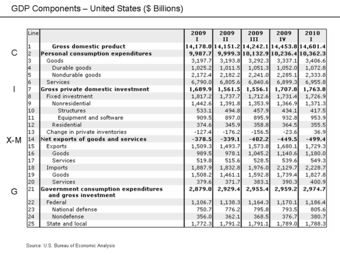
Expenditure accounts
Components of the expenditure approach to calculating GDP as presented in the National Income Accounts (U.S. Bureau of Economic Analysis).
Defining the components
Consumption
Consumption (C) is normally the largest GDP component in the economy, consisting of private (household final consumption expenditure) in the economy. These personal expenditures fall under one of the following categories: durable goods, non-durable goods, and services. Examples include food, rent, jewelry, gasoline, and medical expenses but does not include the purchase of new housing. Also, it is important to note that goods such as hand-knit sweaters are not counted as part of GDP if they are gifted and not sold. Only expenditure based consumption is counted.
Investment
Investment (I) includes, for instance, business investment in equipment, but does not include exchanges of existing assets. Examples include construction of a new mine, purchase of software, or purchase of machinery and equipment for a factory. Spending by households (not government) on new houses is also included in Investment. In contrast to common usage, ‘Investment’ in GDP does not mean purchases of financial products. Buying financial products is classified as ‘saving’, as opposed to investment. This avoids double-counting: if one buys shares in a company, and the company uses the money received to buy plant, equipment, etc., the amount will be counted toward GDP when the company spends the money on those things. To count it when one gives it to the company would be to count two times an amount that only corresponds to one group of products. Note that buying bonds or stocks is a swapping of deeds, a transfer of claims on future production, not directly an expenditure on products.
Government Spending
Government spending (G) is the sum of government expenditures on final goods and services. It includes salaries of public servants, purchase of weapons for the military, and any investment expenditure by a government. It does not include any transfer payments, such as social security or unemployment benefits.
Net Exports
Exports (X) represents gross exports. GDP captures the amount a country produces, including goods and services produced for other nations’ consumption, therefore exports are added.
Imports (M) represents gross imports. Imports are subtracted since imported goods will be included in the terms G, I, or C, and must be deducted to avoid counting foreign supply as domestic.
Sometimes, net exports is simply written as NX, but is the same thing as X-M.
Note that C, G, and I are expenditures on final goods and services; expenditures on intermediate goods and services do not count.
19.1.5: Calculating GDP
GDP can be calculated through the expenditures, income, or output approach.
Learning Objective
Identify the output approach to calculating GDP
Key Points
- The expenditures approach says GDP= consumption + investment + government expenditure + exports – imports.
- The income approach sums the factor incomes to the factors of production.
- The output approach is also called the “net product” or “value added” approach.
Key Terms
- expenditure approach
-
The total spending on all final goods and services (Consumption goods and services (C) + Gross Investments (I) + Government Purchases (G) + (Exports (X) – Imports (M)) GDP = C + I + G + (X-M).
- income approach
-
GDP based on the income approach is calculated by adding up the factor incomes to the factors of production in the society.
- output approach
-
GDP is calculated using the output approach by summing the value of sales of goods and adjusting (subtracting) for the purchase of intermediate goods to produce the goods sold.
Gross Domestic Product
Gross domestic product is one method of understanding a country’s income and allows for comparison to other countries .
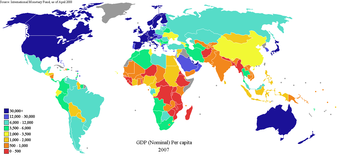
Global GDP
GDP is a common measure for both inter-country comparisons and intra-country comparisons. The metric is one method of understanding economic growth within a country’s borders.
By calculating the value of goods and services produced in a country, GDP provides a useful metric for understanding the economic momentum between the major factors of an economy: consumers, firms, and the government. There are a few methods used for calculating GDP, the most commonly presented are the expenditure and the income approach. Both of these methods calculate GDP by evaluating the final stage of sales (expenditure) or income (income). However, another approach referred to as the “output approach” calculates GDP by evaluating the value of all sales and adjusting for the purchase of intermediate goods (to remove double counting).
Expenditures Approach
The most well known approach to calculating GDP, the expenditures approach is characterized by the following formula:
GDP = C + I + G + (X-M)
where C is the level of consumption of goods and services, I is gross investment, G is government purchases, X is exports, and M is imports.
Income Approach
The income approach adds up the factor incomes to the factors of production in the society. It can be expressed as:
GDP = National Income (NY) + Indirect Business Taxes (IBT) + Capital Consumption Allowance and Depreciation (CCA) + Net Factor Payments to the rest of the world (NFP)
Output Approach
The output approach is also called “net product” or “value added” method. This method consists of three stages:
- Estimating the gross value of domestic output;
- Determining the intermediate consumption, i.e., the cost of material, supplies, and services used to produce final goods or services;
- Deducting intermediate consumption from gross value to obtain the net value of domestic output.
Net value added = Gross value of output – Value of intermediate consumption.
Gross value of output = Value of the total sales of goods and services + Value of changes in the inventories.
The sum of net value added in various economic activities is known as GDP at factor cost. GDP at factor cost plus indirect taxes less subsidies on products is GDP at producer price. GDP at producer price theoretically should be equal to GDP calculated based on the expenditure approach. However, discrepancies do arise because there are instances where the price that a consumer may pay for a good or service is not completely reflected in the amount received by the producer and the tax and subsidy adjustments mentioned above may not adequately adjust for the variation in payment and receipt.
19.1.6: Other Approaches to Calculating GDP
The income approach evaluates GDP from the perspective of the final income to economic participants.
Learning Objective
Explain the income approach to calculating GDP.
Key Points
- The sum of COE, GOS, and GMI is called total factor income; it is the income of all of the factors of production in society. It measures the value of GDP at factor (basic) prices.
- Adding taxes less subsidies on production and imports converts GDP at factor cost (as noted, a net domestic product) to GDP.
- By definition, the income approach to calculating GDP should be equatable to the expenditure approach; however, measurement errors will make the two figures slightly off when reported by national statistical agencies.
Key Terms
- expenditure approach
-
The total spending on all final goods and services (Consumption goods and services (C) + Gross Investments (I) + Government Purchases (G) + (Exports (X) – Imports (M)) GDP = C + I + G + (X-M).
- income approach
-
GDP based on the income approach is calculated by adding up the factor incomes to the factors of production in the society.
- depreciation
-
The measurement of the decline in value of assets. Not to be confused with impairment, which is the measurement of the unplanned, extraordinary decline in value of assets.
Gross domestic product provides a measure of the productivity of an economy specific to the national borders of a country . It can be measured a few different ways and the most commonly used metric is the expenditure approach; however, the second most commonly used measure is the income approach. The income approach unlike the expenditure approach, which sums the spending on final goods and services across economic agents (consumers, businesses and the government), evaluates GDP from the perspective of the final income to economic participants. GDP calculated in this manner is sometimes referenced as “Gross Domestic Income” (GDI).
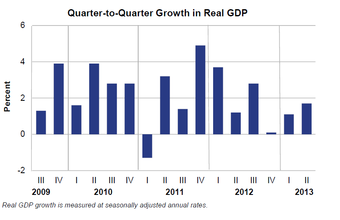
GDP over time
GDP is measured over consecutive periods to enable policymakers and economic agents to evaluate the state of the economy to set expectations and make decisions.
This method measures GDP by adding incomes that firms pay households for factors of production they hire- wages for labor, interest for capital, rent for land, and profits for entrepreneurship. The U.S. “National Income and Expenditure Accounts” divide incomes into five categories:
- Wages, salaries, and supplementary labor income
- Corporate profits
- Interest and miscellaneous investment income
- Farmers’ income
- Income from non-farm unincorporated businesses
Two adjustments must be made to get the GDP: Indirect taxes minus subsidies are added to get from factor cost to market prices. Depreciation (or Capital Consumption Allowance) is added to get from net domestic product to gross domestic product.
Income Approach Formula
GDP = compensation of employees + gross operating surplus + gross mixed income + taxes less subsidies on production and imports. Alternatively, this can be expressed as:
GDP = COE + GOS + GMI + TP & M – SP & M
- Compensation of employees (COE) measures the total remuneration to employees for work done.
- Gross operating surplus (GOS) is the surplus due to owners of incorporated businesses.
- Gross mixed income (GMI) is the same measure as GOS, but for unincorporated businesses. This often includes most small businesses.
- TP & M is taxes on production and imports.
- SP&M is subsidies on production and imports.
The sum of COE, GOS, and GMI is called total factor income; it is the income of all of the factors of production in society. It measures the value of GDP at factor (basic) prices. The difference between basic prices and final prices (those used in the expenditure calculation) is the total taxes and subsidies that the government has levied or paid on that production. So, adding taxes less subsidies on production and imports converts GDP at factor cost (as noted, a net domestic product) to GDP.
By definition, the income approach to calculating GDP should be equatable to the expenditure approach (Y = C + I+ G + (X – M)). In practice, however, measurement errors will make the two figures slightly off when reported by national statistical agencies.
19.1.7: Evaluating GDP as a Measure of the Economy
The value of GDP as a measure of the quality of life for a given country may be limited.
Learning Objective
Assess the uses and limitations of GDP as a measure of the economy
Key Points
- The sensitivities related to social welfare has continued the argument specific to the use of GDP as a economic growth or progress metric.
- A country with wide disparities in income could appear to be economically stronger, strictly using GDP, than a country where the income disparities were significantly lower (standard of living).
- Therefore, GDP has a tremendous big-picture value but policymakers would be better served using other metrics in combination with the aggregate measure if and when social welfare is being addressed.
Key Terms
- qualitative
-
Based on descriptions or distinctions rather than on some quantity.
- welfare
-
Health, safety, happiness and prosperity; well-being in any respect.
- quantitative
-
Of a measurement based on some number rather than on some quality.
Gross domestic product (GDP) due to its relative ease of calculation and definition, has become a standard metric in the discussion of economic welfare, growth and prosperity. However, the value of GDP as a measure of the quality of life for a given country may be quite poor given that the metric only provides the total value of production for a specific time interval and provides no insight with respect to the source of growth or the beneficiaries of growth. Therefore, growth could be misinterpreted by looking at GDP values in isolation.
Limitations of GDP
Simon Kuznets, the economist who developed the first comprehensive set of measures of national income, stated in his first report to the US Congress in 1934, in a section titled “Uses and Abuses of National Income Measurements”:
“Economic welfare cannot be adequately measured unless the personal distribution of income is known. And no income measurement undertakes to estimate the reverse side of income, that is, the intensity and unpleasantness of effort going into the earning of income. The welfare of a nation can, therefore, scarcely be inferred from a measurement of national income. “
Following on his caution with respect to economic extrapolations from GDP, in 1962, Kuznets stated: “Distinctions must be kept in mind between quantity and quality of growth, between costs and returns, and between the short and long run. Goals for more growth should specify more growth of what and for what. “
The sensitivities related to social welfare has continued the argument specific to the use of GDP as a economic growth or progress metric.
Austrian School economist Frank Shostak has noted: “The GDP framework cannot tell us whether final goods and services that were produced during a particular period of time are a reflection of real wealth expansion, or a reflection of capital consumption. For instance, if a government embarks on the building of a pyramid, which adds absolutely nothing to the well-being of individuals, the GDP framework will regard this as economic growth. In reality, however, the building of the pyramid will divert real funding from wealth-generating activities, thereby stifling the production of wealth. “
GDP as an Evaluation Metric
Although GDP provides a single quantitative metric by which comparisons can be made across countries, the aggregation of elements that create the single value of GDP provide limitations in evaluating a country and its economic agents. Given the calculation of the metric, a country with wide disparities in income could appear to be economically stronger than a country where the income disparities were significantly lower (standard of living). However, a qualitative assessment would likely value the latter country compared to the former on a welfare or quality of life basis .
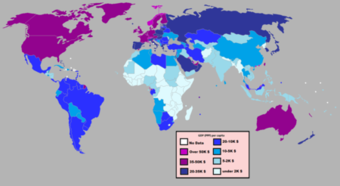
GDP across the globe
GDP can be adjusted to compare the purchasing power across countries but cannot be adjusted to provide a view of the economic disparities within a country.
Therefore, GDP has a tremendous big-picture value but policymakers would be better served using other metrics in combination with the aggregate measure if and when social welfare is being addressed.
19.2: Other Measures of Output
19.2.1: National Income
A variety of measures of national income and output are used in economics to estimate total economic activity in a country or region.
Learning Objective
Explain the importance of calculating national income.
Key Points
- Arriving at a figure for the total production of goods and services in a large region like a country entails a large amount of data-collection and calculation.
- In order to count a good or service, it is necessary to assign value to it.
- Three strategies have been used to obtain the market values of all the goods and services produced: the product (or output) method, the expenditure method, and the income method.
Key Term
- national income
-
The total amount of goods and services produced within some “boundary. ” The boundary is usually defined by geography or citizenship, and may also restrict the goods and services that are counted.
A variety of measures of national income and output are used in economics to estimate total economic activity in a country or region, including gross domestic product (GDP), gross national product (GNP), net national income (NNI), and adjusted national income (NNI* adjusted for natural resource depletion). All of the measures are especially concerned with counting the total amount of goods and services produced within some boundary. The boundary is usually defined by geography or citizenship, and may also restrict the goods and services that are counted. For instance, some measures count only goods and services that are exchanged for money, excluding bartered goods, while other measures may attempt to include bartered goods by imputing monetary values to them.
Arriving at a figure for the total production of goods and services in a large region like a country entails a large amount of data-collection and calculation. Although some attempts were made to estimate national incomes as long ago as the 17th century, the systematic keeping of national accounts, of which these figures are a part, only began in the 1930s, in the United States and some European countries. The impetus for that major statistical effort was the Great Depression and the rise of Keynesian economics, which prescribed a greater role for the government in managing an economy, and made it necessary for governments to obtain accurate information so that their interventions into the economy could proceed as well-informed as possible .

Expenditure approach
The expenditure approach is a common method for evaluating the value of an economy at a given point in time.
Measuring National Income
In order to count a good or service, it is necessary to assign value to it. The value that the measures of national income and output assign to a good or service is its market value – the price when bought or sold. The actual usefulness of a product (its use-value) is not measured – assuming the use-value to be any different from its market value. Three strategies have been used to obtain the market values of all the goods and services produced: the product or output method, the expenditure method, and the income method.
Product or Output Method
The output approach focuses on finding the total output of a nation by directly finding the total value of all goods and services a nation produces:
At factor cost = GDP at market price – depreciation + NFIA (net factor income from abroad) – net indirect taxes
Income Method
The income approach equates the total output of a nation to the total factor income received by residents or citizens of the nation:
NDP at factor cost = compensation of employees + net interest + rental and royalty income + profit of incorporated and unincorporated NDP at factor cost
Expenditure Method
The expenditure approach focuses on finding the total output of a nation by finding the total amount of money spent and is the most commonly used equational form:
GDP = C + I + G + ( X – M ); where C = household consumption expenditures / personal consumption expenditures, I = gross private domestic investment, G = government consumption and gross investment expenditures, X = gross exports of goods and services, and M = gross imports of goods and services.
19.2.2: Personal Income
Personal income is an individual’s total earnings from wages, investment interest, and other sources.
Learning Objective
Explain personal income
Key Points
- In the United States the most widely cited personal income statistics are the Bureau of Economic Analysis’s (BEA) personal income and the Census Bureau’s per capita money income.
- BEA’s personal income measures the income received by persons from participation in production, from government and business transfers, and from holding interest-bearing securities and corporate stocks.
- The Census Bureau also produces alternative estimates of income and poverty based on broadened definitions of income that include many of these income components that are not included in money income.
Key Term
- personal income
-
An individual’s total earnings from wages, investment enterprises, and other ventures.
Personal income is an individual’s total earnings from wages, investment interest, and other sources.
In the United States the most widely cited personal income statistics are the Bureau of Economic Analysis’s (BEA) personal income and the Census Bureau’s per capita money income. The two statistics spring from different traditions of measurement: personal income from national economic accounts and money income from household surveys.
BEA’s personal income measures the income received by persons from participation in production, from government and business transfers, and from holding interest-bearing securities and corporate stocks. Personal income also includes income received by nonprofit institutions serving households, by private non-insured welfare funds, and by private trust funds. BEA publishes disposable personal income, which measures the income available to households after paying federal and state and local government income taxes. Income from production is generated both by the labor of individuals (for example, in the form of wages and salaries and of proprietors’ income) and by the capital that they own (in the form of rental income of persons). Income that is not earned from production in the current period—such as capital gains, which relate to changes in the price of assets over time—is excluded. BEA’s monthly personal income estimates are one of several key macroeconomic indicators that the National Bureau of Economic Research considers when dating the business cycle. Personal income and disposable personal income are provided both as aggregate and as per capita statistics. BEA produces monthly estimates of personal income for the nation, quarterly estimates of state personal income, and annual estimates of local-area personal income .
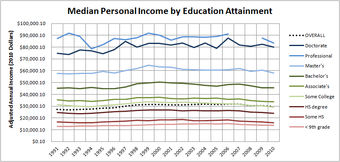
Historical personal income by educational attainment
Personal income data can provide governments with useful information in the formulation of public policy to combat income inequality.
The Census Bureau also produces alternative estimates of income and poverty based on broadened definitions of income that include many of these income components that are not included in money income. The Census Bureau releases estimates of household money income as medians, percent distributions by income categories, and on a per capita basis. Estimates are available by demographic characteristics of householders and by the composition of households.
19.2.3: Disposable Income
Disposable income is the income left after paying taxes.
Learning Objective
Define disposable income
Key Points
- Disposable income is total personal income minus personal current taxes.
- Discretionary income is disposable income minus all payments that are necessary to meet current bills.
- Disposable income is often incorrectly used to denote discretionary income.
Key Terms
- disposable income
-
Income left after taxes.
- Discretionary Income
-
Disposable income (after-tax income) minus all payments that are necessary to meet current bills.
Income left after paying taxes is referred to as disposable income. Disposable income is thus total personal income minus personal current taxes . In national accounts definitions:

Disposable income
Disposable income can be spent on essential or nonessential items. Alternatively, it can also be saved. It is whatever income is left after taxes.
Personal income – personal current taxes = disposable personal income
This can be restated as: consumption expenditure + savings = disposable income
For the purposes of calculating the amount of income subject to garnishment, United States federal law defines disposable income as an individual’s compensation (including salary, overtime, bonuses, commission, and paid leave) after the deduction of health insurance premiums and any amounts required to be deducted by law. Amounts required to be deducted by law include federal, state, and local taxes, state unemployment and disability taxes, social security taxes, and other garnishments or levies, but does not include such deductions as voluntary retirement contributions and transportation deductions.
Discretionary income is disposable income minus all payments that are necessary to meet current bills. It is total personal income after subtracting taxes and typical expenses (such as rent or mortgage, utilities, insurance, medical fees, transportation, property maintenance, child support, food and sundries, etc.) needed to maintain a certain standard of living. In other words, it is the amount of an individual’s income available for spending after the essentials (such as food, clothing, and shelter) have been taken care of.
Discretionary income = Gross income – taxes – all compelled payments (bills)
Disposable income is often incorrectly used to denote discretionary income. The meaning should therefore be interpreted from context. Commonly, disposable income is the amount of “play money” left to spend or save.
19.2.4: GDP per capita
Gross domestic product (GDP) per capita is the mean income of people in an economic unit.
Learning Objective
Define GDP per capita and assess its usefulness as a metric.
Key Points
- GDP per capita is often used as average income, a measure of the wealth of the population of a nation, particularly when making comparisons among nations.
- Per capita income is often used to measure a country’s standard of living.
- It is usually expressed in terms of a commonly used international currency such as the Euro or United States dollar, and can be easily calculated from readily-available GDP and population estimates.
Key Term
- per capita
-
per person
Gross domestic product (GDP) per capita is also known as income per person. It is the mean income of the people in an economic unit such as a country or city. GDP per capita is calculated by dividing GDP by the total population of the country.
GDP per capita income as a measure of prosperity
GDP per capita is often used as average income, a measure of the wealth of the population of a nation, particularly when making comparisons to other nations . It is useful because GDP is expected to increase with population, so it may be misleading to simply compare the GDPs of two countries. GDP per capita accounts for population size.
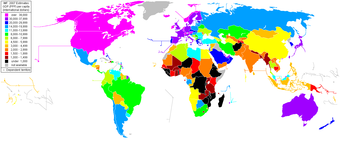
Comparisons of GDP per capita
GDP per capita varies across countries and is highest among developed countries. However, GDP per capita is not an indicator of income distribution in a given country. For this reason GDP per capita may not necessarily be a barometer for the quality of life in a given country.
Per capita income is often used to measure a country’s standard of living. It is usually expressed in terms of a commonly used international currency such as the Euro or United States dollar. It is easily calculated from readily-available GDP and population estimates, and produces a useful statistic for comparison of wealth between sovereign territories. This helps countries know their development status.
However, critics contend that per capita income has several weaknesses as a measure of prosperity, including:
- Comparisons of GDP per capita over time need to take into account changes in prices. Without using measures of income adjusted for inflation, they will tend to overstate the effects of economic growth.
- International comparisons can be distorted by differences in the cost of living between countries that are not reflected in exchange rates. When looking at differences in living standards between countries, using a measure of GDP per capita adjusted for differences in purchasing power parity more accurately reflects the differences in what people are actually able to buy with their money.
- As it is a mean value, it does not reflect income distribution. If the distribution of income within a country is skewed, a small wealthy class can increase GDP per capita far above that of the majority of the population. Median income is a more useful measure of prosperity than GDP per capita because it is less influenced by outliers.
19.3: Comparing Real and Nominal GDP
19.3.1: Calculating Real GDP
Real GDP growth is the value of all goods produced in a given year; nominal GDP is value of all the goods taking price changes into account.
Learning Objective
Calculate real and nominal GDP growth
Key Points
- The following equation is used to calculate the GDP: GDP = C + I + G + (X – M) or GDP = private consumption + gross investment + government investment + government spending + (exports – imports).
- Nominal value changes due to shifts in quantity and price.
- In economics, real value is not influenced by changes in price, it is only impacted by changes in quantity. Real values measure the purchasing power net of any price changes over time.
- Real GDP accounts for inflation and deflation. It transforms the money-value measure, nominal GDP, into an index for quantity of total output.
Key Terms
- nominal
-
Without adjustment to remove the effects of inflation (in contrast to real).
- gross domestic product
-
Known also as GDP, this is a measure of the economic production of a particular territory in financial capital terms over a specific time period.
Example
- Imagine a country with a GDP of $100 in a given year. In the next year the GDP rises to $105 and the inflation rate is %3. Roughly, we can say that real GDP rises to only $102 as the inflation rate accounted for.
Gross Domestic Product
The Gross domestic Product (GDP) is the market value of all final goods and services produced within a country in a given period of time. The GDP is the officially recognized totals. The following equation is used to calculate the GDP:
Written out, the equation for calculating GDP is:
GDP = private consumption + gross investment + government investment + government spending + (exports – imports).
For the gross domestic product, “gross” means that the GDP measures production regardless of the various uses to which the product can be put. Production can be used for immediate consumption, for investment into fixed assets or inventories, or for replacing fixed assets that have depreciated. “Domestic” means that the measurement of GDP contains only products from within its borders.
Nominal GDP
The nominal GDP is the value of all the final goods and services that an economy produced during a given year. It is calculated by using the prices that are current in the year in which the output is produced . In economics, a nominal value is expressed in monetary terms. For example, a nominal value can change due to shifts in quantity and price. The nominal GDP takes into account all of the changes that occurred for all goods and services produced during a given year. If prices change from one period to the next and the output does not change, the nominal GDP would change even though the output remained constant.
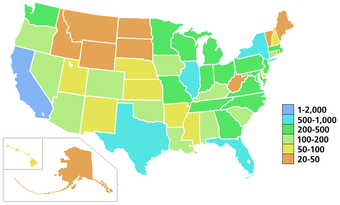
Nominal GDP
This image shows the nominal GDP for a given year in the United States.
Real GDP
The real GDP is the total value of all of the final goods and services that an economy produces during a given year, accounting for inflation . It is calculated using the prices of a selected base year. To calculate Real GDP, you must determine how much GDP has been changed by inflation since the base year, and divide out the inflation each year. Real GDP, therefore, accounts for the fact that if prices change but output doesn’t, nominal GDP would change.
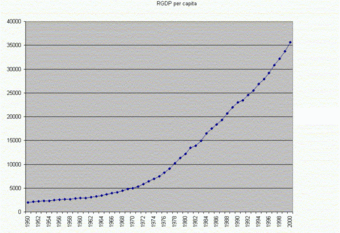
Real GDP Growth
This graph shows the real GDP growth over a specific period of time.
In economics, real value is not influenced by changes in price, it is only impacted by changes in quantity. Real values measure the purchasing power net of any price changes over time. The real GDP determines the purchasing power net of price changes for a given year. Real GDP accounts for inflation and deflation. It transforms the money-value measure, nominal GDP, into an index for quantity of total output.
19.3.2: The GDP Deflator
The GDP deflator is a price index that measures inflation or deflation in an economy by calculating a ratio of nominal GDP to real GDP.
Learning Objective
Explain how the calculation of the GDP deflator can measure inflation
Key Points
- The GDP deflator is a measure of price inflation. It is calculated by dividing Nominal GDP by Real GDP and then multiplying by 100. (Based on the formula).
- Nominal GDP is the market value of goods and services produced in an economy, unadjusted for inflation. Real GDP is nominal GDP, adjusted for inflation to reflect changes in real output.
- Trends in the GDP deflator are similar to changes in the Consumer Price Index, which is a different way of measuring inflation.
Key Terms
- GDP deflator
-
A measure of the level of prices of all new, domestically produced, final goods and services in an economy. It is calculated by computing the ratio of nominal GDP to the real measure of GDP.
- real GDP
-
A macroeconomic measure of the value of the economy’s output adjusted for price changes (inflation or deflation).
- nominal gdp
-
A macroeconomic measure of the value of the economy’s output that is not adjusted for inflation.
The GDP deflator (implicit price deflator for GDP) is a measure of the level of prices of all new, domestically produced, final goods and services in an economy. It is a price index that measures price inflation or deflation, and is calculated using nominal GDP and real GDP.
Nominal GDP versus Real GDP
Nominal GDP, or unadjusted GDP, is the market value of all final goods produced in a geographical region, usually a country. That market value depends on the quantities of goods and services produced and their respective prices. Therefore, if prices change from one period to the next but actual output does not, nominal GDP would also change even though output remained constant.
In contrast, real gross domestic product accounts for price changes that may have occurred due to inflation. In other words, real GDP is nominal GDP adjusted for inflation. If prices change from one period to the next but actual output does not, real GDP would be remain the same. Real GDP reflects changes in real production. If there is no inflation or deflation, nominal GDP will be the same as real GDP.
Calculating the GDP Deflator
The GDP deflator is calculated by dividing nominal GDP by real GDP and multiplying by 100 .

GDP Deflator Equation
The GDP deflator measures price inflation in an economy. It is calculated by dividing nominal GDP by real GDP and multiplying by 100.
Consider a numeric example: if nominal GDP is $100,000, and real GDP is $45,000, then the GDP deflator will be 222 (GDP deflator = $100,000/$45,000 * 100 = 222.22).
In the U.S., GDP and GDP deflator are calculated by the U.S. Bureau of Economic Analysis.
Relationship between GDP Deflator and CPI
Like the Consumer Price Index (CPI), the GDP deflator is a measure of price inflation/deflation with respect to a specific base year. Similar to the CPI, the GDP deflator of the base year itself is equal to 100. Unlike the CPI, the GDP deflator is not based on a fixed basket of goods and services; the “basket” for the GDP deflator is allowed to change from year to year with people’s consumption and investment patterns. However, trends in the GDP deflator will be similar to trends in the CPI.
19.4: Cost of Living
19.4.1: Introduction to Inflation
Inflation is a persistent increase in the general price level, and has three varieties: demand-pull, cost-push, and built-in.
Learning Objective
Distinguish between demand-pull and cost-push inflation
Key Points
- Inflation is an increase in price levels, which decreases the real value, or purchasing power, of money.
- Demand-pull inflation is an increase in price levels due to an increase in aggregate demand when the employment level is full or close to full.
- Cost-push inflation is an increase in price levels due to a decrease in aggregate supply. Generally, this occurs due to supply shocks, or an increase in the price of production inputs.
Key Terms
- inflation
-
An increase in the general level of prices or in the cost of living.
- demand-pull inflation
-
A rise in the price level for goods and services in an economy due to greater demand than the economy’s ability to produce those goods and services.
- cost-push inflation
-
A rise in the price level for goods and services in an economy due to increases in the costs of production.
In economics, inflation is a persistent increase in the general price level of goods and services in an economy over a period of time. When the general price level rises, each unit of currency buys fewer goods and services. Consequently, inflation reflects a reduction in the purchasing power per unit of money; it is a loss of real value, as a single dollar is able to purchase fewer goods than it previously could.
Types of Inflation
The reasons for inflation depend on supply and demand. Depending on the type of inflation, changes in either supply or demand can create an increase in the price level of goods and services. In Keynesian economics, there are three types of inflation.
Demand-Pull Inflation
Demand-pull inflation is inflation that occurs when total demand for goods and services exceeds the economy’s capacity to produce those goods. Put another way, there is “too much money chasing too few goods. ” Typically, demand-pull inflation occurs when unemployment is low or falling. The increases in employment raise aggregate demand, which leads to increased hiring to expand the level of production. Eventually, production cannot keep pace with aggregate demand because of capacity constraints, so prices rise .
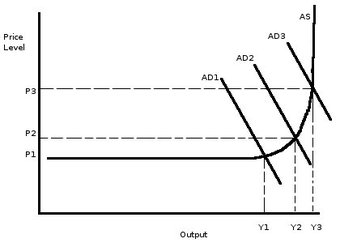
Demand-Pull Inflation
Demand-pull inflation is caused by an increase in aggregate demand. As demand increases, so does the price level.
Cost-Push Inflation
Cost-push inflation occurs when there is an increase in the costs of production. Unlike demand-pull inflation, cost-push inflation is not “too much money chasing too few goods,” but rather, a decrease in the supply of goods, which raises prices .

Cost-Push Inflation
As the costs of production inputs rises, aggregate supply can decrease, which increases price levels.
The reason for decreases in supply are usually related to increases in the prices of inputs. One major reason for cost-push inflation are supply shocks. A supply shock is an event that suddenly changes the price of a commodity or service. (sudden supply decrease) will raise prices and shift the aggregate supply curve to the left. One historical example of this is the oil crisis of the 1970’s, when the price of oil in the U.S. surged. Because oil is integral to many industries, the price increase led to large increases in the costs of production, which translated to higher price levels.
Built-In Inflation
Built-in inflation is the result of adaptive expectations. If workers expect there to be inflation, they will negotiate for wages increasing at or above the rate of inflation (so as to avoid losing purchasing power). Their employers then pass the higher labor costs on to customers through higher prices, which actually reflects inflation. Thus, there is a cycle of expectations and inflation driving one another.
19.4.2: Defining and Calculating CPI
The consumer price index (CPI) is a statistical estimate of the change in prices of goods and services bought for consumption.
Learning Objective
Assess the uses and limitations of the Consumer Price Index
Key Points
- The CPI is calculated by collecting the prices of a sample of representative items over a specific period of time.
- The CPI can be used to index the real value of wages, salaries, pensions, and price regulation. It is one of the most closely watched national economic statistics.
- The equation to calculate a price index using a single item is:
. - The equation for calculating the CPI for multiple items is:
.
Key Terms
- market basket
-
A list of items used specifically to track the progress of inflation in an economy or specific market.
- consumer price index
-
A statistical estimate of the level of prices of goods and services bought for consumption purposes by households.
Consumer Price Index
The consumer price index (CPI) is a statistical estimate of the level of prices of goods and services bought for consumption by households. It measures changes in the price level of a market basket of goods and services used by households. The CPI is calculated by collecting the prices of a sample of representative items over a specific period of time. Goods and services are divided into categories, sub categories, and sub indexes. All of the information is combined to produce the overall index of consumer expenditures. The annual percentage change in a CPI is used to measure inflation. The CPI can be used to index the real value of wages, salaries, pensions, and price regulation. It is one of the most closely watched national economic statistics.
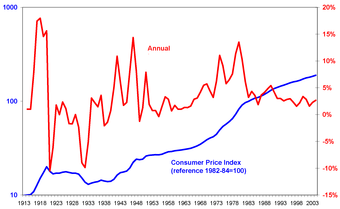
Consumer Price Index
The graph shows the consumer price index in the United States from 1913 – 2004. The x-axis indicates year, the left y-axis indicates the Consumer Price Index, and the right y-axis indicates annual percentage change in Consumer Price Index, which can be used to measure inflation.
Calculating CPI using a Single Item
In order to calculate the CPI using a single item the following equation is used:
Calculating the CPI for Multiple Items
When calculating the CPI for multiple items, it must be noted that many but not all price indices are weighted averages using weights that sum to 1 or 100. When calculating the average for a large number of products, the price is given a weighted average between 1 and 100 to simplify calculation. The weighting determines the importance of the quantity of the product on average. The equation for calculating the CPI for multiple items is:
For example, imagine you buy five sandwiches, two magazines, and two pairs of jeans. In the first period, sandwiches are $6 each, magazines are $4 each, and jeans are $35 each. This will be our base period. In the second period, sandwiches are $7, magazines are $6, and jeans are $45.
Market basket at base period prices = 5(6.00) + 2(4.00) + 2(35.00) = 108.00.
Market basket at current period prices = 5(7.00) + 2(6.00) + 2(45.00) = 137.00.
The CPI based on consumption is 127.
CPI Limitations
The CPI is a convenient way to calculate the cost of living and price level for a certain period of time. However, the CPI does not provide a completely accurate estimate for the cost of living. Issues that impede the accuracy of the CPI include substitution bias (consumers substituting goods for others), introducing new products, and changes in quality. The CPI can also overstate inflation because it does not always account for quality improvements or new goods and services.
GDP Deflator vs. CPI
The GDP deflator is a measure of the level of prices of all new, domestically produced, final goods and services in an economy. Unlike the CPI, the GDP deflator is a measure of price inflation or deflation for a specific base year. The GDP deflator differs from the CPI because it is not based on a fixed basket of goods and services. The GDP deflator “basket” changes from year to year depending on people’s consumption and investment patterns. Unlike the CPI, the GDP deflator is not impacted by substitution biases. Despite the GDP being more flexible, the CPI is a more accurate reflection of the changes in the cost of living.
Chapter 18: Introduction to Macroeconomics
18.1: Key Topics in Macroeconomics
18.1.1: Defining Macroeconomics
Macroeconomics is a branch of economics that focuses on the behavior and decision-making of an economy as a whole.
Learning Objective
Define Macroeconomics.
Key Points
- Macroeconomists study aggregated indicators such as GDP, unemployment rates, and price indices to understand how the whole economy functions.
- Macroeconomists develop models that explain the relationship between such factors as national income, output, consumption, unemployment, inflation, savings, investment, government spending and international trade.
- Though macroeconomics encompasses a variety of concepts and variables, but there are three central topics for macroeconomic research on the national level: output, unemployment, and inflation.
Key Terms
- microeconomics
-
That field that deals with the small-scale activities such as that of the individual or company.
- Macroeconomics
-
The study of the entire economy in terms of the total amount of goods and services produced, total income earned, the level of employment of productive resources, and the general behavior of prices.
Economics is comprised of many specializations; however, the two broad sub-groupings for economics are microeconomics and macroeconomics.
Macroeconomics
Macroeconomics is a branch of economics that focuses on the behavior and decision-making of an economy as a whole . In this manner it differs from the field of microeconomics, which evaluates the motivations of and relationships between individual economic agents.

Macroeconomics: Circular Flow of the Economy
Macroeconomics simplifies the complexities of the trading activities in an economy by distilling actions to primary participants and tracing the circular flow of activity between them.
Indicators
Macroeconomists study aggregated indicators such as GDP, unemployment rates, and price indices to understand how the whole economy functions and develop models that explain the relationship between such factors as national income, output, consumption, unemployment, inflation, savings, investment, government spending, and international trade. These variables taken as a whole comprise a grouping of variables that are referred to as economic indicators. These indicators, which are classified as leading, lagging and coincident relative to their predictive capability, in combination with one another provide economists with a directional attribution for the economy.
Macroeconomic Study
While macroeconomics is a broad field of study, there are two areas of research that are especially well publicized in the media: the evaluation of the business cycle and the growth rate of the economy. As a result, macroeconomics tends to be widely cited in discussions related to government intervention in economic expansion and contraction, as well as, with respect to the evaluation of economic policy.
Though macroeconomics encompasses a variety of concepts and variables, but there are three central topics for macroeconomic research on a national level: output, unemployment, and inflation. Outside of macroeconomic theory, these topics are also extremely important to all economic agents including workers, consumers, and producers.
18.1.2: The Importance of Aggregate Decisions about Consumption versus Saving and Investment
Money can either be consumed, invested, or saved (deferred consumption or investment).
Learning Objective
Explain the relationship between consumption, savings, and investment.
Key Points
- Aggregate demand is downward sloping as a result of three consumption sensitivities: wealth effect, interest rate effect and foreign exchange effect.
- Spending is related to income: Income – Spending = Net Savings.
- For the economy as a whole, aggregate savings is equal to investment, which is usually in the form of borrowed funds available as a result of savings.
Key Term
- aggregate demand
-
The the total demand for final goods and services in the economy at a given time and price level.
There are three choices that market actors can make with their money. They can consume it by spending it on goods and services. For example, buying a movie ticket is spending money on consumption. They can also invest money by lending it to a company or project with the hope of getting back more money in the future. Finally, they can save it by putting it in a bank account (or keeping cash under the bed). Savings is essentially deferred consumption or investment; it is intended for use in the future.
In order to understand the effects of aggregate decisions of consumption, savings, and investment, we must look at aggregate demand (AD). AD is the total demand for final goods and services in the economy at a given time and price level. It specifies the amounts of goods and services that will be purchased at all possible price levels and is the demand for the gross domestic product of a country.
Components of Aggregate Demand
It is often cited that the aggregate demand curve is downward sloping because at lower price levels a greater quantity is demanded. While this is correct at the microeconomic, single good level, at the aggregate level this is incorrect. The aggregate demand curve is downward sloping but in variation with microeconomics, this is as a result of three distinct effects: the wealth effect, the interest rate effect and the exchange-rate effect.
Basically individuals will consume or purchase more when they feel wealthier or have access to inexpensive funding.
The wealth effect is specifically related to the value of assets; market participants will adjust consumption in-line with their perception of the appreciation or depreciation of held assets (a home; equity investments, etc.). The interest rate effect has to do with access to inexpensive funding, which provides an incentive to increase current period expenditures; while the exchange-rate effect has to do with expenditure decisions related to imports or foreign related expenditures, as the exchange rate is perceived to be favorable to the domestic currency, expenditures on foreign items or imports will increase.
Consumption, Savings, and Investment
Aggregate demand met by the market is spending, be it on consumption, investment, or other categories.
Spending is related to income:
Income – Spending = Net Savings
Rearranging:
Spending = Income – Net Savings = Income + Net Increase in Debt
In words: what you spend is what you earn, plus what you borrow: if you spend $110 and earned $100, then you must have net borrowed $10; conversely if you spend $90 and earn $100, then you have net savings of $10, or have reduced debt by $10, for net change in debt of –$10.
For the economy as a whole, aggregate savings is greater than or equal to investment, which is usually in the form of borrowed funds available as a result of savings. Through investment spending, savings influences aggregate demand.
Furthermore, since consumption and investment are components of GDP but saving is not, increased savings indirectly reduces GDP .
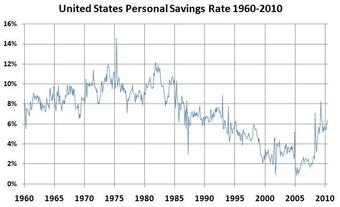
US Savings Rate
Savings have declined in the US on aggregate since the 1980s, which means that the proportion of income spent on consumption and investment increased.
18.1.3: The Role of the Financial System
A financial market or system is a market in which people and entities can trade financial securities, commodities, and other fungible items.
Learning Objective
Explain the importance of the financial system
Key Points
- An economy which relies primarily on interactions between buyers and sellers to allocate resources is known as a market economy.
- Markets work by placing many interested buyers and sellers, including households, firms, and government agencies, in one “place,” thus making it easier for them to find each other.
- Healthy financial systems are associated with the accelerated development of an economy.
Key Terms
- entrepreneurship
-
The art or science of innovation and risk-taking for profit in business.
- investment
-
A placement of capital in expectation of deriving income or profit from its use.
- saving
-
the act of storing for future use
Financial System
A financial market or system is a market in which people and entities can trade financial securities, commodities, and other fungible items . Securities include stocks and bonds, and commodities include precious metals or agricultural goods.
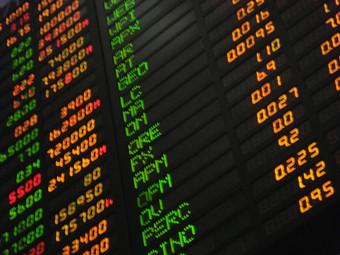
Equity Markets
Equity markets are the most closely followed of the financial markets. They provide transparent and active trading platforms that promote liquidity and access to funds to on a global scale.
There are both general markets (where many commodities are traded) and specialized markets (where only one commodity is traded). Markets work by placing many interested buyers and sellers, including households, firms, and government agencies, in one place, thus making it easier for them to find each other.
An economy that relies primarily on interactions between buyers and sellers to allocate resources is known as a market economy, in contrast either to a command economy or to a non-market economy such as a gift economy.
Role of the Financial System
Financial markets are associated with the accelerated growth of an economy. A financial market helps to achieve the following non-comprehensive list of goals:
- Saving mobilization: Obtaining funds from the savers or surplus units such as household individuals, business firms, public sector units, central government, state governments, etc. is an important role played by financial markets. Borrowers (e.g. bond issuers) are connected with lenders (e.g. bond buyers) in financial markets.
- Investment: Financial markets play a crucial role in arranging to invest funds. Both firms and individuals can invest in companies through financial markets (e.g. by buying stock).
- National Growth: An important role played by financial market is that, they contribute to a nation’s growth by ensuring unfettered flow of surplus funds to deficit units. In other words, financial markets help shift money from industry to industry or firm to firm based on the supply and demand for their products.
- Entrepreneurship growth: Financial markets allow entrepreneurs (and established firms) to access the funds needed to invest in projects or companies.
18.1.4: The Business Cycle: Definition and Phases
The term business cycle refers to economy-wide fluctuations in production, trade, and general economic activity.
Learning Objective
Identify features of the economic business cycle
Key Points
- Business cycles are identified as having four distinct phases: expansion, peak, contraction, and trough.
- Business cycle fluctuations occur around a long-term growth trend and are usually measured by considering the growth rate of real gross domestic product.
- In the United States, it is generally accepted that the National Bureau of Economic Research (NBER) is the final arbiter of the dates of the peaks and troughs of the business cycle.
Key Terms
- contraction
-
A period of economic decline or negative growth.
- peak
-
The highest value reached by some quantity in a time period.
- trough
-
The lowest turning point of a business cycle
- expansion
-
The act or process of expanding.
The Business Cycle
The term “business cycle” (or economic cycle or boom-bust cycle) refers to economy-wide fluctuations in production, trade, and general economic activity. From a conceptual perspective, the business cycle is the upward and downward movements of levels of GDP (gross domestic product) and refers to the period of expansions and contractions in the level of economic activities (business fluctuations) around a long-term growth trend .

Business Cycles
The phases of a business cycle follow a wave-like pattern over time with regard to GDP, with expansion leading to a peak and then followed by contraction leading to a trough.
Business Cycle Phases
Business cycles are identified as having four distinct phases: expansion, peak, contraction, and trough.
An expansion is characterized by increasing employment, economic growth, and upward pressure on prices. A peak is realized when the economy is producing at its maximum allowable output, employment is at or above full employment, and inflationary pressures on prices are evident. Following a peak an economy, typically enters into a correction which is characterized by a contraction, growth slows, employment declines (unemployment increases), and pricing pressures subside. The slowing ceases at the trough and at this point the economy has hit a bottom from which the next phase of expansion and contraction will emerge.
Business Cycle Fluctuations
Business cycle fluctuations occur around a long-term growth trend and are usually measured by considering the growth rate of real gross domestic product.
In the United States, it is generally accepted that the National Bureau of Economic Research (NBER) is the final arbiter of the dates of the peaks and troughs of the business cycle. An expansion is the period from a trough to a peak, and a recession as the period from a peak to a trough. The NBER identifies a recession as “a significant decline in economic activity spread across the economy, lasting more than a few months, normally visible in real GDP, real income, employment, industrial production. ” This is significantly different from the commonly cited definition of a recession being signaled by two consecutive quarters of decline in real GDP.
18.1.5: Recessions
A recession is a business cycle contraction; a general slowdown in economic activity.
Learning Objective
Explain the connection between a recession and other macroeconomic variables
Key Points
- Macroeconomic indicators such as GDP (Gross Domestic Product), employment, investment spending, capacity utilization, household income, business profits, and inflation fall, while bankruptcies and the unemployment rate rise.
- Most mainstream economists believe that recessions are caused by inadequate aggregate demand in the economy, and favor the use of expansionary macroeconomic policy during recessions.
- Strategies favored for moving an economy out of a recession vary depending on which economic school the policymakers follow.
Key Term
- recession
-
A period of reduced economic activity
In economics, a recession is a business cycle contraction; a general slowdown in economic activity. Macroeconomic indicators such as GDP (Gross Domestic Product), employment, investment spending, capacity utilization, household income, business profits, and inflation fall, while bankruptcies and the unemployment rate rise. Recessions generally occur when there is a widespread drop in spending (an adverse demand shock). This may be triggered by various events, such as a financial crisis, an external trade shock, an adverse supply shock, or the bursting of an economic bubble .

Recessions and panic
Recessions are characterized as periods of fear and uncertainty; historically they also were a time of widespread panic. However, as confidence in the central bank and federal government increased, though fear and uncertainty remain, panic-conditioned “runs” as depicted in the photo above have become an element of the past.
Attributes of Recession
A recession has many attributes that can occur simultaneously, these include declines in component measures (economic indicators) of economic activity (GDP) such as consumption, investment, government spending, and net export activity. These indicators in turn, reflect underlying drivers such as employment levels and skills, household savings rates, corporate investment decisions, interest rates, demographics, and government policies.
Causes of Recession
Under ideal conditions, a country’s economy should have the household sector as net savers and the corporate sector as net borrowers, with the government budget nearly balanced and net exports near zero. When these relationships become imbalanced, recession can develop within a country or create pressure for recession in another country. Policy responses are often designed to drive the economy back towards this ideal state of balance.
Most mainstream economists believe that recessions are caused by inadequate aggregate demand in the economy, and favor the use of expansionary macroeconomic policy during recessions.
Policy Responses to Recession
Strategies favored for moving an economy out of a recession vary depending on which economic school the policymakers follow. Monetarists would favor the use of expansionary monetary policy, while Keynesian economists may advocate increased government spending to spark economic growth. Supply-side economists may suggest tax cuts to promote business capital investment. When interest rates reach the boundary of an interest rate of zero percent (zero interest-rate policy) conventional monetary policy can no longer be used and government must use other measures to stimulate recovery.
A severe (GDP down by 10%) or prolonged (three or four years) recession is referred to as an economic depression, although some argue that their causes and cures can be different. As an informal shorthand, economists sometimes refer to different recession shapes, such as V-shaped, U-shaped, L-shaped, and W-shaped recessions.
18.1.6: Managing the Business Cycle
When the economy is not at a steady state, the government and monetary authorities have policy mechanisms to move the economy back to consistent growth.
Learning Objective
Identify how changes in monetary and fiscal policy can manage the business cycle, and why that is desirable
Key Points
- If the economy needs to be slowed, enacted policies are referred to as being contractionary and if the economy needs to be stimulated the policy prescription is expansionary.
- Central banks use monetary policy measures to facilitate consistent economic growth, while the government uses fiscal policy.
- The government policy measures are referred to as fiscal policy.
Key Terms
- fiscal policy
-
Government policy that attempts to influence the direction of the economy through changes in government spending or taxes.
- monetary policy
-
The process by which the central bank, or monetary authority manages the supply of money, or trading in foreign exchange markets.
The business cycle is comprised of the upward and downward movement in the level of Gross Domestic Product (GDP) over time . These fluctuations occur around a long-term growth trend, and typically involve shifts over time between periods of relatively rapid economic growth (an expansion or boom), and periods of relative stagnation or decline (a contraction or recession).

Cycles in the economy
The economy moves through expansion and contraction on a routine basis; policy mechanisms allow for smoother transitions and soften landings.
Policy Responses
When the economy is not at a steady state and instead is at a point of either overheating (growing to fast) or slowing, the government and monetary authorities have policy mechanisms, fiscal and monetary, respectively, at their disposal to help move the economy back to a steady state growth trajectory. If the economy needs to be slowed, these policies are referred to as contractionary and if the economy needs to be stimulated the policy prescription is expansionary.
Expansionary Policy
Expansionary fiscal policy involves government spending exceeding tax revenue, and is usually undertaken during recessions. Fiscal authorities will increase government spending in order to revive the economy.
Expansionary monetary policy relies on the central bank increasing availability of loanable funds through three mechanisms: open market operations, discount rate, and the reserve ratio. As the supply of loanable funds increases, the interest rate is expected to decrease and thereby increase the desire to borrow funds for consumption and investment purposes.
Contractionary Policy
Contractionary fiscal policy is opposite of the action taken in an expansionary purpose, and occurs when government spending is lower than tax revenue.
Similarly, contractionary monetary policy is the opposite of expansionary monetary policy and occurs when the supply of loanable funds is limited, to reduce the access and availability to relatively inexpensive credit.
18.1.7: Long Run Growth
Long run growth is the increase in the market value of the goods and services produced by an economy over time.
Learning Objective
Explain the impact of consistent long-run growth on an economy.
Key Points
- Growth is usually calculated in real terms, meaning that it is inflation-adjusted to eliminate the distorting effect of inflation on the price of goods produced.
- Policymakers strive for continued and consistent growth.
- The large impact of a relatively small growth rate over a long period of time is due to the power of compounding.
- A small difference in economic growth rates between countries can result in very different standards of living for their populations if this small difference continues for many years.
Key Term
- economic growth
-
The increase of the economic output of a country.
Long run growth is the increase in the market value of the goods and services produced by an economy over time. It is conventionally measured as the percentage of increase in real gross domestic product, or real GDP. Growth is usually calculated in real terms: it is inflation-adjusted to eliminate the distorting effect of inflation on the price of goods produced. In economics, economic growth or economic growth theory typically refers to growth of potential output, which is production at full employment.
Policymakers strive for steady, continued, and consistent growth because it is predictable and manageable for both policymakers and market participants. Over long periods of time even small rates of growth, like a 2% annual increase, have large effects. For example, the United Kingdom experienced a 1.97% average annual increase in its inflation-adjusted GDP between 1830 and 2008. In 1830, the GDP was £41,373 million. It grew to £1,330,088 million by 2008 (in 2005 pounds). A growth rate that averaged 1.97% over 178 years resulted in a 32-fold increase in GDP by 2008 .
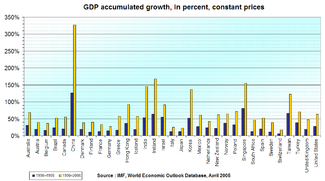
Long-run growth rates
Growth in GDP can be significant, especially when annual growth rates are fairly consistent.
The Power of Compounding
The large impact of a relatively small growth rate over a long period of time is due to the power of compounding. A growth rate of 2.5% per annum leads to a doubling of the GDP within 29 years, while a growth rate of 8% per annum (an average exceeded by China between 2000 and 2010) leads to a doubling of GDP within 10 years. Therefore, a small difference in economic growth rates between countries can result in very different standards of living for their populations if this small difference continues for many years.
Note: an easy way to approximate the doubling time of a number with a constant growth rate is to use the Rule of 72. Divide 72 by the percentage annual growth rate to get a rough estimate of the number of years until the number doubles. For example, at a 10%, divide 72 by 10 to get a doubling time of 7.2 years. The actual doubling time is 7.27 years, so the rule of 72 is a good rough approximation.
Chapter 17: Income Inequality and Poverty
17.1: Defining and Measuring Inequality, Mobility, and Poverty
17.1.1: Defining and Measuring Poverty
Poverty is framed from a material possessions perspective, and is defined as lacking a certain amount to fulfill basic standards of living.
Learning Objective
Describe poverty and the poverty line
Key Points
- The United Nations defines poverty as the inability to obtain choices and opportunities.
- A poverty line pertains to the idea of generating an amount of income that is appropriate to ensure a minimum standard of living for an individual. Someone below a nationally set poverty line lacks the purchasing power to fulfill their needs and capture opportunities.
- In observing poverty over time, the rates of poverty alongside the advances in economic production, demonstrate the value in technological and economic progress.
- Poverty is generally divided into absolute or relative poverty, with absolute concepts referring to a standard consistent over time and geographic location and relative pertaining to social benchmarks.
Key Terms
- purchasing power
-
The amount of goods and services that can be bought with a unit of currency or by consumers.
- Poverty line
-
The threshold of poverty, below which one’s income does not cover necessities.
Poverty is framed from a material or capital possessions perspective, and is loosely defined as lacking a certain amount to fulfill basic standards of living. Absolute poverty is poverty to the extent of which an individual is deprived of the ability to fulfill basic human needs (i.e. water, shelter, food, education, etc.). The United Nations defines poverty as the inability to obtain choices and opportunities. The existence of poverty is one of the greatest challenges faced by the modern world, both in developing and developed nations (see ). Addressing poverty is best approached through the science of understanding monetary exchanges and the creation of wealth, and thus it is useful to employ an economic perspective when discussing and providing solutions to global poverty.
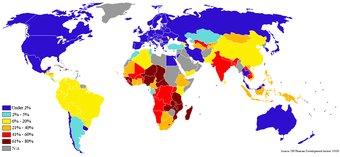
Percentage of People Living on Less than $1/Day
This map underlines the overall percentage of people in specific countries living on less than one dollar (USD) per day. The important takeaway is the wide range of countries suffering from varying levels of poverty.
The Poverty Line
When conceptually approaching the idea of a poverty line, it is useful to frame it within the context of generating an amount of income that is appropriate to ensure a reasonable standard of living for an individual. Someone below a nationally set poverty line lacks the purchasing power to fulfill their needs and capture opportunities. The United States, for example, has most recently (2012) set the poverty line at $23,050 (annually) with a total of 16% of the population falling under this level (according to the U.S. Census Bureau). Internationally, the World Bank defines extreme poverty as living on less than $1 per day (adjusted for purchasing power).
In observing poverty over time, the rates of poverty alongside the advances in economic production, demonstrates the value in technological and economic progress. The industrial revolution, the modernization (and thus increased efficiency) of agriculture, mass production in factories, technological innovation and a wide range of factors that have driven production and economies upwards have contributed to an increased standard of living. Economically, while the distribution of wealth heavily has tended to benefit the wealthy, there has been great value derived in technological progress in regards to minimizing poverty.
Measuring Poverty
Varying approaches have been developed to measure poverty levels, with a particular focus on creating standardized tools to capture a global context. Poverty is generally divided into absolute or relative poverty, with absolute concepts referring to a standard that is consistent over time and geographic location. An example of absolute poverty is the number of people without access to clean drinking water, or the number of people eating less food than the body requires for survival. Absolute poverty levels, as discussed above, essentially underline the ability for an individual to survive with autonomy. Relative poverty is an approach based more upon a benchmark, that is to say the upper echelon of society versus the poor. Income distribution measures lend insight into relative poverty levels.
One interesting perspective is the Multidimensional Poverty Index (MPI). This index was created in 2010 by the Oxford Poverty & Human Development Initiative alongside the United Nations Development Programme. It leverages a variety of dimensions and applies it to the number of people and the overall intensity across the poor to create a model to capture the extent of the poverty in the region. This dimensions include health, child mortality, nutrition, standard of living, electricity, sanitation, water, shelter (via the floor), cooking fuel and assets owned.
17.1.2: Defining and Measuring Income Inequality
Income inequality uses the dispersion of capital to identify how economic inequality is defined among individuals in a given economy.
Learning Objective
Apply indices of income inequality to measure global economic inequality
Key Points
- In pursuing an objective and comparable lens in which to measure income inequality, a variety of methods have been created.
- One of the most commonly used income inequality metric is the Gini Index, which uses a straightforward 0-1 scale to illustrate deviance from perfect income equality.
- The 20:20 Ratio and the Palma Ratio (40:10) use percentile ratios of the richest groups and poorest groups to create scales of income inequality severity.
- The Theil Index takes a slightly different approach than the rest, identifying entropy within the system. Entropy, in this case, means the amount of noise or deviance from par, which is expressed as a scale (0 – 1); 0 indicates perfect equality, and 1 indicates perfect inequality.
- Often touted as the simplest measurement to calculate, the Hoover Index derives the overall amount of income in a system and divides it by the population to create the perfect proportion of distribution in the system.
Key Term
- entropy
-
A measure of the amount of information and noise present in a signal.
Income inequality utilizes the dispersion of capital to identify the way in which economic inequality is defined among a group of individuals in a given economy. Simply put, economics measures income levels and purchasing power across a society to identify averages and distributions to identify the extent of inequalities. Historically this problem was limited to the scope of differences of income and assets between people, creating separate social classes. However, as economists expand their understanding of markets, it has become increasingly clear that there is a relationship between income inequality and the potential for long-term sustainable economic growth. As a result, a wide array of income inequality scales and metrics have been generated in order to identify challenges.
Inequality Metrics
In pursuing an objective and comparable lens in which to measure income inequality, a variety of methods have been created. Models, ratios and indices include:
- Gini Index: One of the most commonly used income inequality metric is the Gini Index, which uses a straightforward 0-1 scale to illustrate deviance from perfect equality of income. A 1 on this scale is essentially socialism, or the perfect distribution of capital/goods. The derivation of the Gini ratio is found via Lorenz curves, or more specifically, the ratio of two areas in a Lorenz curve diagram. The downside to this method is that it does not specifically capture where the inequality occurs, simply the degree of severity in the income gap. This demonstrates the Gini ratio across the globe, with some interesting implications for advanced economies like the U.S.
- 20:20 Ratio:This name indicates the method; the top 20% and the bottom 20% of earners are used to derive a ratio. While this is a simple method of identifying how rich the rich are (and how poor the poor are), it unfortunately only captures these outliers (obscuring the middle 60%).
- Palma Ratio: Quite similar to the 20:20 ratio, the Palma ratio underlines the ratio between the richest 10% and the poorest 40% (dividing the former by the latter). The share of the overall economy occupied by these two groups demonstrates substantial variance from economy to economy, and serves as a strong method to identify how drastic the inequity is.
- Theil Index:The Theil Index takes a slightly different approach than the rest, identifying entropy within the system. Entropy in this context is different than that which is found in thermodynamics, primarily meaning the amount of noise or deviance from par. In this case, 0 indicates perfect equality, and 1 indicates perfect inequality. When there is perfect equality, maximum entropy occurs because earners cannot be distinguished by their incomes. The gaps between two entropies is called redundancy, which acts as a negative entropy measure in the system. Redundancy in some individuals implies scarcity of resources for others. Comparing these gaps and inequality levels (high entropy or high redundancy) is the basic premise behind the Theil Index.
- Hoover Index: Often touted as the simplest measurement to calculate, the Hoover Index derives the overall amount of income in a system and divides it by the population to create the perfect proportion of distribution in the system. In a perfectly equal economy this would equate to income levels, and the deviance from this (on a percentile scale) is representative of the inequality in the system.
To simplify the information above, the basic concept behind measuring inequality is identifying an ideal and tracking any deviance from that ideal (which would be deemed the inequality of a given system). Minimizing this inequality is the sign of a mature and advanced society with high standards of living across the board, while substantial income gaps are indicative of a developing or struggling economy. Some powerful economies, like the United States and China, demonstrate high inequality despite high economic power while others, like Switzerland or Norway, demonstrate high equality despite lower economic output. This is a critical consideration in economic policy (from a political perspective). Minimizing inequality is a central step towards an advanced society.
17.1.3: Defining and Measuring Economic Mobility
Economic mobility is a measurement of how capable a participant in a system can improve (or reduce) their economic status.
Learning Objective
Distinguish between types of economic mobility
Key Points
- This concept of economic mobility is often considered in conjunction with “social mobility,” which is the capacity for an individual to change station within a society.
- Economic mobility can be perceived via a number of approaches, but is best summarized as inter-generational, intra-generational, absolute, or relative.
- Closely related to the concept of economic mobility is that of socio-economic mobility, referring to the ability to move vertically from one social or economic class to another. This is called “vertical” mobility.
- Economists studying economic mobility have identified a number of factors that play an integral role in enabling (or blocking) participants in an economic system from achieving mobility, such as gender, race and education.
Key Terms
- glass ceiling
-
An unwritten, uncodified barrier to further promotion or progression for a member of a specific demographic group.
- Economic mobility
-
The ability of an individual or family to improve their income, and social status, in an individual lifetime or between generations.
Economic mobility is a measurement of how capable a participant in a system can improve (or reduce) their economic status (generally measured in monetary income). This concept of economic mobility is often considered in conjunction with ‘social mobility’, which is the capacity for an individual to change station within a society.
Types of Economic Mobility
Economic mobility can be perceived via a number of approaches, but is best summarized in the following four:
- Intergenerational:Intergenerational mobility pertains to a person’s capacity to alter their station relative to the economic status of their parents or grandparents, essentially the flexibility within a society to allow individuals to grow regardless of their initial station. Contrary to concepts of mobility in America, 42% of individuals in born into the bottom income bracket remain there. An interesting chart, measuring intergenerational income elasticity, can be found in .
- Intragenerational:Intragenerational mobility is defined by an individual’s upwards and downwards movement throughout their lifetime (both relative to their working career and their peers). This type of mobility is shorter term than intergenerational in regards to the way in which it is confined to the lifetime of that individual specifically.
- Absolute:Similar to intergenerational mobility, absolute mobility looks at how widespread economic growth improves (or reduces) an individual or a family’s income over a generational time frame. Put simply, it answers the following question: How likely is a person to exceed their parents income at a given age?
- Relative:Relative mobility, as the name implies, measures the mobility and economic growth of a particular person within the context of the system in which they work.
Closely related to the concept of economic mobility is that of socioeconomic mobility, which refers to the ability to move vertically from one social or economic class to another. This is called “vertical” mobility, which overlaps substantially with the categories discussed above.
Economists studying economic mobility have identified a number of factors that play an integral role in enabling (or blocking) participants in an economic system from achieving mobility. Some of the more well-known issues include:
- Gender: Gender is quite often a limiting factor in economic mobility, with concepts like the “glass ceiling” underlining the difficulty encountered by women in achieving high-earning status. While women have made great strides in some countries, many global economies still struggle to incorporate women into the workplace with equity.
- Race/Ethnicity: In the United States in particular there is huge inequity between Caucasian workers and that of other backgrounds (African American, Hispanic, etc.). Approaching this social tie with income inequity has taken a great deal of political reform over the years, and has much left to accomplish in terms of enabling movement across economic levels.This could in many ways be coupled with immigration, or the concept of being different socially or ethnically from a group that has historically achieved high income levels.
- Education: Access to equitable and affordable education in all places worldwide is a substantial domestic and global challenge in enabling the next generation for success. Access to the best education is highly correlated with access to the best professional opportunities, and thus the expansion and funding of effective public education lies at the center of enabling economic mobility.
17.1.4: Measurement Problems
Due to the high complexity of measuring equality, the accuracy of many poverty and inequality measurements can be less than ideal.
Learning Objective
Describe issues with measuring poverty and income inequality globally
Key Points
- The most popular measurement of income inequality is the Gini ratio, which leverages a simple scale of 0-1 to derive deviance from a given perfect equality point. The primary drawback to this approach is that it measures relative poverty (as opposed to absolute poverty).
- The poverty line is a useful absolute measurement, but suffers from having no global standard set (for comparative value), having limited nuance to measure deviations from the poverty line, and failing to incorporate intangible societal assets such as health care.
- One interesting risk in measuring poverty is the concept of voluntary poverty, or the active pursuit of living at the absolute bare minimum.
- Overall, while measuring inequality is a necessary and useful economic perspective, there are inherent statistical drawbacks in mathematically approaching complex societal issues.
Key Terms
- Poverty line
-
The threshold of poverty, below which one’s income does not cover necessities.
- Gini Index
-
A measure of income distribution.
As with any statistical modeling and measuring approach, there is a great deal of complexity to capture within a finite algorithmic structure, making the accuracy and efficacy of many poverty and inequality measurements less than ideal. Inequality, poverty and economic mobility in particular have a number of measurement challenges.
Gini Index
The most popular measurement of income inequality is the Gini index, which leverages a simple scale of 0-1 to derive deviance from a given perfect equality point. If a system demonstrates a Gini index of 0, the implication is that income differences among any individuals in the population will be essentially zero, while a measurement of 1 is complete income disparity. The primary drawback to this approach is that it measures relative poverty (as opposed to absolute poverty). This criticism spans across most poverty measurement systems (Thiel entropy, the 20:20 ratio, and the Palma ratio to name a few), and ultimately implies that much of what is measured as inequality does not take into account absolute gains.
For example, if an economy were to grow by 20% over 10 years, it is perfectly possible (and indeed quite likely) that the upper 20% will capture 50% gains while the bottom 20% will only capture 10% gains. That bottom 10% (assuming inflation has been accounted for) will be gaining wealth and purchasing power in absolute terms despite the fact that the Gini index will be much worse. The Gini index still has important implications about relative inequality in this circumstance, but it neglects to point out positive gains.
Criticisms of the Poverty Line
Taking into account the problems with the Gini ratio, a concept like the poverty line does an effective job in offsetting this variability. A poverty line is the determination of a specific income level in which it is considered the absolute minimum amount of capital required for an individual or family to live (and have all necessities) over the course of one year.
While there is great absolute value in utilizing a poverty line to determining the percentage of people still surviving on less than is considered the bare minimum, there are also drawbacks to this method as well. Looking at the , one can see that measuring the percentages of individuals under the poverty line from country to country demonstrates what appears to be a graphic for comparison. However, due to the fact that poverty lines are different in different countries (because there is no standard way in which to enforce setting and measuring the poverty line) it is not relative. As a result, there is high absolute value for each country but minimal comparative value between countries. Another prospective drawback of this method is that the poverty threshold only measures when an individual is above or below it, and not the extent to which each individual deviates. Finally, it is also important to consider less quantitative components that affect the standard of living (for example, education quality, roads, access to public transportation, access to healthcare, etc.), and thus country to country comparisons are somewhat reduced in value.
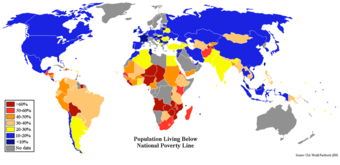
Individuals Below National Poverty Line
This graph illustrates the different percentiles of individuals under the poverty line across the world. One criticism of this method is that national poverty lines are not derived objectively in a standardized fashion, and thus there is limited value to this graphic in relative terms.
Voluntary Poverty
One interesting risk in measuring poverty is the concept of voluntary poverty, or the active pursuit of living at the absolute bare minimum. This is done as a result of lifestyle choice or religion, and is counted into poverty and inequality levels despite the fact that the individual being counted has actively pursued this place in society. While this is a somewhat unusual circumstance, it shifts the measurement of poverty in some regions (particularly those with a high population of certain beliefs or religions) higher than would be expected.
17.2: Policies for Reducing Poverty
17.2.1: Social Insurance
Social insurance are government-sponsored programs, such as Medicare, that provide benefits to people based on individual contributions to that program.
Learning Objective
Describe the characteristics of social insurance programs
Key Points
- Social insurance programs share four characteristics: they have well-defined eligibility requirements and benefits, have provisions for program income and expenses, are funded by taxes or premiums paid by participants, and have mandatory or heavily subsidized participation.
- Social insurance programs differs from welfare programs in that they take participant contributions into account. Welfare benefits are based on need, not contributions.
- Social Security, Medicare, and unemployment insurance are three well-known social insurance programs in the United States.
Key Term
- social insurance
-
Any government-sponsored program where risks are transferred to and pooled by an organization that is legally required to provide certain benefits.
Social insurance has been defined as a program where risks are transferred to and pooled by an organization (often governmental) that is legally required to provide certain benefits. It is any government-sponsored program with the following four characteristics:
- The benefits, eligibility requirements, and other aspects of the program are defined by statute;
- Explicit provision is made to account for income and expenses (often through a trust fund);
- It is funded by taxes or premiums paid by (or on behalf of) participants (although additional sources of funding may be provided as well); and
- The program serves a defined population, and participation is either compulsory, or the program is subsidized heavily enough that most eligible individuals choose to participate.
Social insurance differs from welfare in that the beneficiary’s contributions to the program are taken into account. A welfare program pays recipients based on need, not contributions. Medicare is an example of a social insurance program, while Medicaid is an example of a welfare one.
In the United States, Social Security, Medicare, and unemployment insurance are among the most well-known forms of social insurance.
Social Security
Social Security in the U.S. is primarily the Old-Age, Survivors, and Disability Insurance (OASDI) federal insurance program. Social Security is funded through payroll taxes called Federal Insurance Contributions Act tax (FICA) and/or Self Employed Contributions Act Tax (SECA). Tax deposits are collected by the Internal Revenue Service (IRS) and are formally entrusted to the Social Security Trust Funds. Social Security provides monetary benefits to retirees, their spouses and surviving dependent children, and disabled workers .

Social Security Poster
Social Security is one of the best-known social insurance programs in the United States. It provides benefits to retirees, surviving family members, and disabled workers who have contributed to the Social Security Trust Fund through payroll taxes.
Medicare
Medicare is a national program that guarantees access to health insurance for Americans aged 65 and older, younger people with disabilities, and people with certain chronic diseases. Medicare is funded through revenue from FICA and SECA payroll taxes, as well as through premiums paid by Medicare enrollees and general fund revenue from the federal government.
Unemployment Insurance
Unemployment insurance provides a monetary benefit to workers who have become unemployed through no fault of their own. Benefits are generally paid by state governments, and are funded in large part by state and federal payroll taxes levied against employers. These payroll taxes were established by the Federal Unemployment Tax Act (FUTA), and allow the IRS to collect federal employer taxes used to fund state workforce agencies. FUTA covers the costs of administering the Unemployment Insurance and Job Service programs in all states. In addition, FUTA pays one-half of the cost of extended unemployment benefits (during periods of high unemployment) and provides for a fund from which states may borrow, if necessary, to pay benefits.
17.2.2: Public Assistance
Public assistance is the provision of a minimal level of social support for all citizens.
Learning Objective
Define and describe different types of public assistance
Key Points
- Public assistance is provided by the government, charities, social groups, and religious groups. It is funded by government agencies and private organizations.
- Public assistance systems vary by country, but welfare is usually provided to individuals who are unemployed, those with an illness or disability, the elderly, those with dependent children, and veterans.
- Forms of public assistance include monetary payments, subsidies, vouchers, housing assistance, and universal healthcare.
Key Terms
- public assistance
-
Payment made to disadvantaged persons by government in order to alleviate the burdens of poverty, unemployment, disability, old age, etc.
- subsidy
-
Financial support or assistance, such as a grant.
- voucher
-
A piece of paper that entitles the holder to a discount, or that can be exchanged for goods and services.
Public Assistance
Public assistance, also referred to colloquially as welfare, is the provision of a minimal level of social support for all citizens. In most developed countries, public assistance is provided by the government, charities, social groups, and religious groups. It is funded by government agencies and private organizations.
Public assistance systems vary by country, but welfare is usually provided to individuals who are unemployed, those with an illness or disability, the elderly, those with dependent children, and veterans. Individuals must meet specific criteria to be eligible to receive public assistance.
In the United States, the funds for public assistance are given at a flat rate to each state based on population. Each state has to meet certain criteria to ensure that individuals receiving public assistance are being encouraged to work themselves out of welfare. The goal of public assistance is to support individuals who are in need of help while encouraging them to seek employment and better their lives.
Forms of Public Assistance
Public assistance is offered in a variety of forms including:
- Monetary payments: individuals are paid bi-weekly or monthly based on their income level. Individuals must apply for monetary public assistance and meet specific criteria. Monetary payments will be lessened or stopped once the individual’s income reaches a certain level. An example of monetary payments is Temporary Assistance for Needy Families (TANF), which provides a cash benefit to families in need.
- Subsidy: government funded programs that provide assistance to citizens on federal, state, local, and private levels. Subsidies help to provide food, housing, education, healthcare, and financial support to individuals in need. Examples include Medicaid .
- Vouchers: are bonds given out by the government or other welfare organizations. A voucher is worth a certain monetary value and can only be spent on specific goods .
- Housing assistance: provided by the government to ensure that individuals have shelter. In some cases individuals will receive free housing while other will receive housing at a discounted rate. Housing assistance is based on an individual’s level of income.
- Universal healthcare: health care coverage that provides health care and financial protection to all citizens. It provides a specific package of benefits to all members of society with the goal of providing financial risk protection, improved access to health services, and improved health outcomes.
Chapter 16: Taxes and Public Finance
16.1: Introduction to Taxes
16.1.1: What Taxes Do
On a general level, tax collections provide a revenue source to support the outlays or primary activities of a government.
Learning Objective
Explain the role of taxation with respect to consumer and firm behavior
Key Points
- Taxes allow the government to perform and provide services that would not evolve naturally through a free market mechanism, for example, public parks.
- Taxes are the primary source of revenue for most governments.
- Governments also use taxes to establish income equity and modify consumption decisions.
Key Terms
- sales tax
-
A local or state tax imposed as a percentage of the selling price of goods or services payable by the customer. The tax is not recognized as the seller’s earnings; the seller only collects the tax and transmits the same to local or state authorities.
- income tax
-
A tax levied on earned and unearned income, net of allowed deductions.
- progressive tax
-
A tax by which the rate increases as the taxable base amount increases.
- regressive tax
-
A tax imposed in such a manner that the rate decreases as the amount subject to taxation increases.
Taxes are the primary source of revenue for most governments. They are simply defined as a charge or fee on income or commerce. Taxes are most readily understood from the perspective of income taxes or sales tax, although there are many other types of taxes levied on both individuals and firms.
Necessarily, taxes raise the price of purchasing the good or resource for firms and consumers. As a result, the quantity demanded and supplied reacts according to the supply and demand curves.
Tax Authority
In the United States, Congress has the power to tax as stated in The United States Constitution, Article 1, Section 8, Clause 1: “The Congress shall have the Power to lay and collect Taxes, Duties, Imposts, and Excises to pay the Debts and provide for the common Defense and general Welfare of the United States. ” This power was reinforced in the Sixteenth Amendment to the Constitution: “The Congress shall have the power to lay and collect taxes on income, from whatever source derived, without apportionment among the several States, and without regard to any census or enumeration.”
It is important to note that Congress has delegated to the Internal Revenue Service (IRS) the responsibility of administering the tax laws, known as the Internal Revenue Code (the Code). Congress enacts these tax laws, and the IRS enforces them. Individual states also have the power to tax as do smaller government entities such as towns, cities, counties, and municipalities.
Purpose of Taxation
On a general level, tax collections provide a revenue source to support the outlays or primary activities of a government including but not limited to public buildings, military, national parks, and public welfare in the form of transfer payments. Taxes allow the government to perform and provide services that would not evolve naturally through a free market mechanism, for example, public parks. However, governments also use taxes to establish income equity and modify consumption decisions .
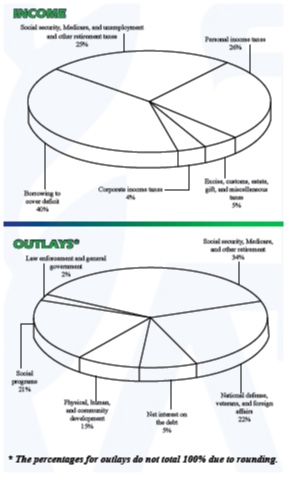
Income and Outlays (IRS Publication 2105; Rev 3-2011)
Tax revenue is used by the government to support services and activities available to all residents.
Sources of Tax Revenue: Income Taxation
Governments use different kinds of taxes and vary the tax rates. This is done to distribute the tax burden among individuals or classes of the population involved in taxable activities, such as business, or to redistribute resources between individuals or classes in the population. This type of taxation is referred to as progressive taxation because the tax liability increases in proportion to income.
Sources of Tax Revenue: Sales Taxes
Sales taxes are borne by the consumer when s/he purchases certain goods. It is an ad valorem tax: the charged value is based on the value of what is being sold. This is in contrast to an excise tax, where the charged value is based on the number of items being sold.
Sales tax is a form of regressive taxation; the liability is based on the percentage of income consumed, which is higher for low income earners. As a result, individuals earning a relatively lower income will pay a higher proportion of income in the form of sales tax, defining the regressive nature of the tax. Though a general revenue source, sales taxes are also used to modify behavior. For example taxes on cigarettes are meant to dissuade purchase due to the inherent health implications of smoking.
16.1.2: How Taxes Impact Efficiency: Deadweight Losses
In economics, deadweight loss is a loss of economic efficiency that can occur when equilibrium for a good or service is not Pareto optimal.
Learning Objective
Discuss how taxes create deadweight loss
Key Points
- Causes of deadweight loss can include actions that prevent the market from achieving an equilibrium clearing condition and include taxes.
- Deadweight loss can generally be referenced as a loss of surplus to either the consumer, producer, or both.
- Harberger’s triangle refers to the deadweight loss associated with government intervention in a perfect market.
Key Terms
- Pareto optimal
-
Describing a situation in which the profit of one party cannot be increased without reducing the profit of another.
- deadweight loss
-
A loss of economic efficiency that can occur when an equilibrium is not Pareto optimal.
Deadweight Loss
In economics, a deadweight loss (also known as excess burden or allocative inefficiency) is a loss of economic efficiency that can occur when equilibrium for a good or service is not Pareto optimal (resource allocation where it is impossible to make any one individual better off without making at least one individual worse off). Causes of deadweight loss can include actions that prevent the market from achieving an equilibrium clearing condition (where supply and demand are equal) and include taxes or subsidies and binding price ceilings or floors (including minimum wages). Deadweight loss can generally be referenced as a loss of surplus to either the consumer, producer, or both.
Harberger’s Triangle, Taxes, and Deadweight Loss
Harberger’s triangle, generally attributed to Arnold Harberger, refers to the deadweight loss (as measured on a supply and demand graph) associated with government intervention in a perfect market . This can happen through price floors, caps, taxes, tariffs, or quotas. In the case of a tax on the supplier of a good, the supply curve will shift inward in proportion to the tax and resulting in a non-market clearing level of supply. As a result, the price of the good increases and the quantity available decreases .

Taxation and Deadweight Loss
Taxation can be evaluated as a non-market cost. In this case imposition of taxes reduces supply, resulting in the creation of deadweight loss (triangle bounded by the demand curve and the vertical line representing the after-tax quantity supplied), similar to a binding constraint.

Harberger’s Triangle
Deadweight loss, represented by Harberger’s triangle, is the yellow triangle. It represents lost efficiency.
The area represented by the Harberger’s triangle results from the intersection of the supply and demand curves above market equilibrium resulting in a reduction in consumer surplus and producer surplus relative to their value before the imposition of the tax. The loss of the surplus, not recouped by tax revenues, is deadweight loss.
Some economists have argued that these triangles do not have a huge impact on the economy, whereas others maintain that they can seriously affect long term economic trends by pivoting the trend downwards, causing a magnification of losses in the long run.
16.2: Deploying and Measuring Taxes
16.2.1: How Taxes Work in the United States
Tax laws are passed by Congress and enforced by the Internal Revenue Service (IRS) at the federal level.
Learning Objective
Discuss the United States taxation process and the legislature involved
Key Points
- There are federal, state, and local taxes in the US.
- Congress passes federal tax laws that are then interpreted and enforced by the IRS.
- The US judicial system is employed to handle tax disputes by companies or individuals.
Key Terms
- Internal Revenue Service
-
The United States government agency that collects taxes and enforces tax laws.
- Congress
-
The two legislative bodies of the United States: the House of Representatives, and the Senate.
There are three levels of government in the United States: the federal government, state governments, and local governments. Each has its own authority to tax. For example, states can set their own sales and payroll taxes that apply only within the state. Similarly, local governments can impose a variety of taxes, such as property taxes. Since the taxation process varies on the state and local level, we will focus on the federal level.
Federal taxes are created by the US Congress, which passes laws mandating what is taxed and the amount of the tax. One of the most well-known taxes, the federal income tax, wasn’t created until the passage of the 16th amendment in 1913 explicitly gave the US Congress the authority to tax income. Congress then takes the tax revenue and apportions it through its power to create and manage the federal budget.
Congress is not the body, however, that actually collects taxes. That duty is charged to the Internal Revenue Service (IRS), a part of the Department of the Treasury. The IRS is responsible for ensuring that companies and individuals pay the taxes they are legally obligated to .

IRS
The IRS is responsible for interpreting and enforcing tax legislation passed by Congress. The IRS taxes only realized returns, though financial reports must also include unrealized returns on the balance sheet.
The IRS also has some power in determining exactly how the tax laws passed by Congress are interpreted and enforced. For example, Congress may say that depreciation will be an allowable expense “in accordance with regulations to be established by the IRS. ” This allows the IRS to articulate the conditions under which depreciation is considered an allowable expense. At the same time, the IRS must also interpret the laws passed by Congress to determine what the law was intended to mean for a given organization or individual.
As would be expected with any law or interpretation of a law by a government body, there are disputes. Disputes over tax rules are generally heard in the United States Tax Court before the tax is paid, or in a United States District Court or United States Court of Federal Claims after the tax is paid. Tax laws are treated like any other piece of legislation in that there is a judicial process for resolving disputes.
16.3: Progressive, Proportional, and Regressive Taxes
16.3.1: Comparing Marginal and Average Tax Rates
Taxes can be evaluated based on an average impact or a marginal impact and can be categorized as progressive, regressive, or proportional.
Learning Objective
Calculate the average tax rate and marginal tax rate
Key Points
- An average tax rate is the ratio of the total amount of taxes paid, T, to the total tax base, P, whereas the marginal tax rate equals the change in taxes, divided by the change in tax base.
- A proportional tax is a tax imposed so that the tax rate is fixed, with no change as the taxable base amount increases or decreases. The average tax rate equals the marginal tax rate.
- A regressive tax is a tax imposed in such a manner that the tax rate decreases as the amount subject to taxation increases. The average tax rate is higher than the marginal tax rate.
- A progressive tax is a tax in which the tax rate increases as the taxable base amount increases. The average tax rate is lower than the marginal tax rate.
Key Terms
- average tax rate
-
The ratio of the amount of taxes paid to the tax base (taxable income or spending).
- marginal tax rate
-
The tax rate that applies to the last unit of currency of the tax base (taxable income or spending), and is often applied to the change in one’s tax obligation as income rises.
Computing taxes
Average and marginal tax rate
An average tax rate is the ratio of the total amount of taxes paid, T, to the total tax base, P, (taxable income or spending), expressed as a percentage. If a company pays different rates on the first $100,000 in earning than the next $100,000, it will sum up the total tax paid and divide it by $200,000 to calculate the average tax rate.
T/P = average tax rate
The marginal tax rate is sometimes defined as the tax rate that applies to the last (or next) unit of the tax base (taxable income or spending), it is in effect, the tax percentage on the highest dollar earned. For example, if a company pays 5% tax on its first $100,000 earned, and 10% on the next $100,000, the marginal tax rate of earning the $101,000th dollar is 10%.
Broadly, the marginal tax rate equals the change in taxes, divided by the change in tax base, expressed as a percentage.
change in T/change in P = marginal tax rate
Types of taxes
Progressive tax
A progressive tax is a tax in which the tax rate increases as the taxable base amount increases . The term “progressive” describes a distribution effect on income or expenditure, referring to the way the rate progresses from low to high, where the average tax rate is less than the marginal tax rate. The term can be applied to individual taxes or to a tax system as a whole; a year, multi-year, or lifetime. Progressive taxes are imposed in an attempt to reduce the tax incidence of people with a lower ability-to-pay, as such taxes shift the incidence increasingly to those with a higher ability-to-pay. The opposite of a progressive tax is a regressive tax, where the relative tax rate or burden increases as an individual’s ability to pay it decreases.
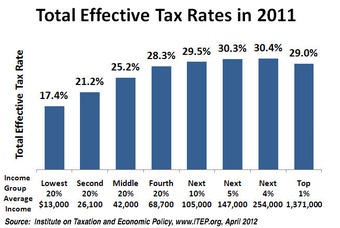
Progressive taxation
Graph demonstrates a progressive tax distribution on income that becomes regressive for top earners.
Regressive tax
A regressive tax is a tax imposed in such a manner that the average tax rate decreases as the amount subject to taxation increases . “Regressive” describes a distribution effect on income or expenditure, referring to the way the rate progresses from high to low, where the average tax rate exceeds the marginal tax rate. In terms of individual income and wealth, a regressive tax imposes a greater burden (relative to resources) on the poor than on the rich — there is an inverse relationship between the tax rate and the taxpayer’s ability to pay as measured by assets, consumption, or income.
Proportional tax
A proportional tax is a tax imposed so that the tax rate is fixed, with no change as the taxable base amount increases or decreases. The amount of the tax is in proportion to the amount subject to taxation. “Proportional” describes a distribution effect on income or expenditure, referring to the way the rate remains consistent (does not progress from “low to high” or “high to low” as income or consumption changes), where the marginal tax rate is equal to the average tax rate.
16.3.2: Tax Incidence, Efficiency, and Fairness
Tax incidence is the analysis of the effect of a particular tax on the distribution of economic welfare.
Learning Objective
Identify who bears the tax burden in various scenarios
Key Points
- Tax incidence or tax burden does not depend on where the revenue is collected, but on the price elasticity of demand and price elasticity of supply.
- Tax incidence falls mostly upon the group that responds least to price (the group that has the most inelastic price-quantity curve).
- If the demand curve is inelastic relative to the supply curve the tax will be disproportionately borne by the buyer rather than the seller. If the demand curve is elastic relative to the supply curve, the tax will be born disproportionately by the seller.
Key Terms
- elastic
-
Sensitive to changes in price.
- inelastic
-
Not sensitive to changes in price.
- tax
-
Money paid to the government other than for transaction-specific goods and services.
In economics, tax incidence is the analysis of the effect of a particular tax on the distribution of economic welfare. Tax incidence is said to “fall” upon the group that ultimately bears the burden of, or ultimately has to pay, the tax. The key concept is that the tax incidence or tax burden does not depend on where the revenue is collected, but on the price elasticity of demand and price elasticity of supply.
Tax incidence does not consider the concept of tax efficiency or the excess burden of taxation, also known as the distortionary cost or deadweight loss of taxation, is one of the economic losses that society suffers as the result of a tax. For example, United States Social Security payroll taxes are paid half by the employee and half by the employer. However, some economists think that the worker is bearing almost the entire burden of the tax because the employer passes the tax on in the form of lower wages. The tax incidence is thus said to fall on the employee and due to the need for workers for a particular job, the tax burden also falls, in this case, on the worker.
Example of Tax Incidence
Imagine a $1 tax on every barrel of apples an apple farmer produces. If the product (apples) is price inelastic to the consumer (whereby if price rose, a small demand loss would be accounted for by the extra revenue), the farmer is able to pass the entire tax on to consumers of apples by raising the price by $1. In this example, consumers bear the entire burden of the tax; the tax incidence falls on consumers. On the other hand, if the apple farmer is unable to raise prices because the product is price elastic (if prices rose, more demand would be lost than extra revenue gained), the farmer has to bear the burden of the tax or face decreased revenues: the tax incidence falls on the farmer. If the apple farmer can raise prices by an amount less than $1, then consumers and the farmer are sharing the tax burden. When the tax incidence falls on the farmer, this burden will typically flow back to owners of the relevant factors of production, including agricultural land and employee wages .

Shared tax incidence
The imposition of a tax can result in a reduction to both consumer and producer surplus relative to the pre-tax scenario.
Where the tax incidence falls depends (in the short run) on the price elasticity of demand and price elasticity of supply. Tax incidence falls mostly upon the group that responds least to price (the group that has the most inelastic price-quantity curve). If the demand curve is inelastic relative to the supply curve the tax will be disproportionately borne by the buyer rather than the seller. If the demand curve is elastic relative to the supply curve, the tax will be borne disproportionately by the seller.
Tax efficiency
In the example provided, the tax burden falls disproportionately on the party exhibiting relatively more inelasticity in the situation. This characteristic results in a reduction of the ability of the party to participate in the market to the level of willingness that would have been present in the absence of the tax. The loss is conceptually defined as a loss of surplus and the loss of surplus is characterized as deadweight loss. Policy makers evaluate the surplus and deadweight loss in relation to the imposition of a tax in order to better evaluate the efficiency of a tax or the distortion that the imposed tax causes on the attainment of market equilibrium.
Policymakers must consider the predicted tax incidence when creating them. If taxes fall on an unintended party, it may not achieve its intended objective and may not be fair.
16.3.3: Tax Incidence and Elasticity
Tax incidence or tax burden does not depend on where the revenue is collected, but on the price elasticity of demand and price elasticity of supply.
Learning Objective
Explain how elasticity influences the relative tax burden between suppliers and consumers (demand).
Key Points
- If a producer (consumer) is inelastic, it will produce (demand) the same quantity no matter what the price.
- If the producer (consumer) is elastic, the producer (consumer) is very sensitive to price.
- The sensitivity between quantity and price will determine the proportion of tax incidence between producers and consumers of a good.
Key Terms
- inelasticity
-
The insensitivity of changes in a quantity with respect to changes in another quantity.
- elasticity
-
The sensitivity of changes in a quantity with respect to changes in another quantity.
Tax incidence refers to who ultimately pays the tax, the producer or consumer, and the resulting societal effect.. Tax incidence is said to “fall” upon the group that ultimately bears the burden of, or ultimately has to pay, the tax. The key concept is that the tax incidence or tax burden does not depend on where the revenue is collected, but on the price elasticity of demand and price elasticity of supply.
Inelastic Supply, Elastic Demand
If a producer is inelastic, he will produce the same quantity no matter what the price. If the consumer is elastic, the consumer is very sensitive to price. A small increase in price leads to a large drop in the quantity demanded .

Tax: Inelastic supply and elastic demand
In a scenario with inelastic supply and elastic demand, the tax burden falls disproportionately on suppliers.
The imposition of the tax causes the market price to increase from P without tax to P with tax and the quantity demanded to fall from Q without tax to Q with tax. Because the consumer is elastic, the quantity change is significant. Because the producer is inelastic, the price does not change much. The producer is unable to pass the tax onto the consumer and the tax incidence falls on the producer. In this example, the tax is collected from the producer and the producer bears the tax burden.
Comparable Elasticities
In most markets, elasticities of supply and demand are fairly similar in the short-run, as a result the burden of an imposed tax is shared between the two groups albeit in varying proportions .

Tax: Similar elasticity for supply and demand
When a tax is imposed in a scenario where demand and supply exhibit similar elasticities, the tax burden is shared.
In general, the tax burden will be greater for the group exhibiting the greater relative inelasticity.
16.3.4: Trading off Equity and Efficiency
Taxes may be considered equitable if they are administered in accordance with the definition of either horizontal or vertical equity.
Learning Objective
Explain tax equity in relation to the progressive, proportional, and regressive nature of taxes.
Key Points
- Horizontal equity conforms to the concept that people with a similar ability to pay taxes should pay the same or similar amounts.
- Vertical equity usually refers to the idea that people with a greater ability to pay taxes should pay more.
- Income taxes are incorporate both horizontal and vertical equity via a progressive tax mechanism. Sales taxes are regressive and are considered inequitable.
Key Terms
- income tax
-
A tax levied on earned and unearned income, net of allowed deductions.
- progressive tax
-
A tax by which the rate increases as the taxable base amount increases.
- equity
-
Justice, impartiality or fairness.
In public finance, horizontal equity conforms to the concept that people with a similar ability to pay taxes should pay the same or similar amounts. It is related to tax neutrality or the idea that the tax system should not discriminate between similar things or people, or unduly distort behavior. Vertical equity usually refers to the idea that people with a greater ability to pay taxes should pay more.
Horizontal Equity, Vertical Equity, and Taxes
Income taxes are a laddered progressive tax where income tax rates are set in income bands or ranges. Each tax rate corresponds to a particular income range; income above a tax range is subject to a higher tax rate that corresponds to a higher income range and income below a specific range is subject to a lower tax rate, similarly identified with a lower income range. Within any given income range, the tax rate is the same.
The income range conforms with the idea that the individuals included within it are similar with respect to their ability to pay. The range can be identified as conforming to the concept of horizontal equity. Vertical equity follows from the laddering of income tax to progressively higher rates. The laddering of income taxes conforms to the underlying definition of vertical equity, as those who have a greater ability to pay tax, pay a higher proportion of their income.
Proportional taxes, conform to horizontal equity. By definition proportional taxes are levied in proportion to income. However, income taxes are only proportional within specific income ranges. At the highest income tax rate, income taxes can become regressive, since high earners are only subject to a constant albeit highest rate on their income. For example, income from $500,000 and above will be subject to the same rate, making the overall tax burden as a proportion of income higher for the individuals on the starting point of the range .
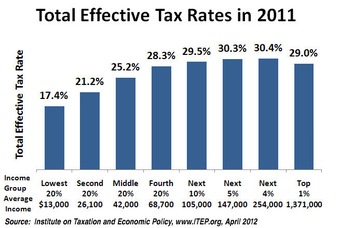
Income tax
Income tax is a progressive tax that assumes a regressive nature at the highest tax rate.
Tax efficiency and tax equity
The purpose of a progressive tax system is to increase the tax burden to those most able to pay. However, some policy makers believe that progressive taxation is an overall inefficiency within the tax structure. These individuals and groups support a flat tax or proportional tax instead. Their argument for a tax modification is related to the view that increasing the tax rate in conjunction with income creates a disincentive to individuals to earn more and is, as a result, punitive to those that achieve income related success. The net result from this reasoning is that progressive taxation results in lower GDP than would have resulted in a proportional tax regime, also referred to as a loss of economic efficiency.
16.4: Taxation in the United States
16.4.1: Financing the US Government
Taxes are the primary source of government revenue.
Learning Objective
Identify the basis for taxation.
Key Points
- Taxes can be used to stabilize the economy.
- The implementation of taxes can promote social equity; for example the use of progressive income taxes.
- There are many types of taxes that can be legislated to derive revenue for government operations.
Key Terms
- balanced budget
-
A (usually government) budget in which income and expenditure are equal over a set period of time.
- fiscal policy
-
Government policy that attempts to influence the direction of the economy through changes in government spending or taxes.
Financing of Government Expenditures
Taxation is the central part of modern public finance. The importance of taxation arises from the fact that it is by far the most significant source of government revenue and is therefore the primary means of financing government expenditures .
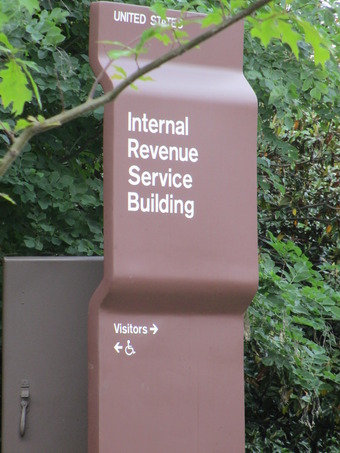
Taxation authority
In the United States the Internal Revenue Service is the regulatory authority empowered by Congress to collect taxes.
Due to the pervasive nature of taxation, taxes can be used as an instrument of attaining certain social objectives. For example, income taxes due to their progressive nature are used to equitably derive revenue by differentiating tax rates by income strata. The income derived in this manner is then used to transfer income to lower income groups, thereby, reducing inequalities related to income and wealth.
Taxation is also used as part of fiscal policy to stabilize the economy. Increasing taxes can reduce consumption and lead to economic slowing when the economy may be growing too quickly. Alternatively, decreasing taxes can be a mechanism to promote economic growth by increasing the funds available for consumption and investment spending. It is important to note that when the government spends more than the tax revenue it collects, the government is operating at a deficit and will have to borrow funds to finance operations until taxes can be increased to return the government spending to a balanced budget.
Types of Taxes
The US government imposes a number of different types of taxes in order to finance its operations. The following is a list of taxes in common use by governmental authorities:
- Excise tax: tax levied on production for sale, or sale, of a certain good.
- Sales tax: tax on business transactions, especially the sale of goods and services.
- Corporate income tax: tax on a company’s profits.
- Income tax: tax on an individual’s wages or salary.
- Capital gains tax: tax on increases in the value of owned assets.
16.4.2: Financing State and Local Government
Taxes are the primary source of revenue for state and local governments; income, property, and sales taxes are common examples of state and local taxes.
Learning Objective
Give an example of federal, state, and local taxes
Key Points
- State and local governments collect taxes from residents to support corresponding state and local government activities. Examples of these services include maintenance of public parks and provision of a police force.
- Property tax is an example of a local tax. It is imposed on the value of real estate.
- Sales tax may be imposed by both a state and local government. It is charged at the point of sale of the good or service.
- Income tax may be imposed by the federal, state, or local government. Tax rates vary by location, and often by income level.
Key Terms
- sales tax
-
A local or state tax imposed as a percentage of the selling price of goods or services payable by the customer. The tax is not recognized as the seller’s earnings; the seller only collects the tax and transmits the same to local or state authorities.
- property tax
-
An (usually) ad valorem tax charged on the basis of the fair market value of property.
- income tax
-
A tax levied on earned and unearned income, net of allowed deductions.
Taxes are important to federal, state, and local governments. They are the primary source of revenue for the corresponding level of government and fund the activities of the governmental entity. For example, on a local level, taxes fund the provision of common services, such as police or fire department, and the maintenance of common areas, such as public parks . On a state level, taxes fund the school systems, including state universities. On a federal level, taxes are used to fund government activities such as the provision of welfare and transfer payments to redistribute income.

Pearl Hill State Park
State parks like Pearl Hill, located in Townsend, Massachusetts, rely on tax revenue for support and maintenance.
Example of a Federal, State, and Local Tax
Income taxes are taxes imposed on the net income of individuals and corporations by the federal, most state, and some local governments. State and local income tax rates vary widely by jurisdiction and many are graduated, or increase progressively as income levels increase. State taxes are generally treated as a deductible expense for federal tax computation.
Example of a State Tax
Sales taxes are imposed by most states on the retail sale price of many goods and some services. Sales tax rates also vary widely among jurisdictions, from 0% to 16%, and may vary within a jurisdiction based on the particular goods or services taxed. Sales tax is collected by the seller at the time of sale, or remitted as use tax by buyers of taxable items who did not pay sales tax.
Example of a Local Tax
Property taxes are imposed by most local governments and many special purpose authorities based on the fair market value of property. Property tax is generally imposed only on real estate, though some jurisdictions tax some forms of business property. Property tax rules and rates vary widely.
16.5: Personal, Property, and Sales Taxes
16.5.1: Corporate and Payroll Taxes
Many countries impose taxes on a company’s earnings along with aspects of doing business. Two examples of these are corporate and payroll taxes.
Learning Objective
Give examples of corporate and payroll taxes
Key Points
- Two common taxes faced by companies are corporate tax and payroll tax.
- Corporate taxes are taxes a corporation must pay, and are analogous to personal taxes. Company income subject to taxation is often determined much like taxable income for individuals.
- Payroll taxes generally fall into two categories: deductions from an employee’s wages and taxes paid by the employer based on the employee’s wages.
Key Terms
- corporate tax
-
A tax levied on a corporation, especially on its profits; corporation tax
- payroll tax
-
A tax levied when an employer pays its employees.
- Social Security
-
A system whereby the state either through general or specific taxation provides various benefits to help ensure the wellbeing of its citizens.
Corporate taxes
Many countries impose a corporate tax, also called corporation tax or company tax, on the income or capital of some types of legal entities. A similar tax may be imposed at state or lower levels. The taxes may also be referred to as income tax or capital tax. Most countries tax all corporations doing business in the country on income from that country. Many countries tax all income of corporations organized in the country. Company income subject to taxation is often determined much like taxable income for individuals. Generally, the tax is imposed on net profits. In some jurisdictions, rules for taxing companies may differ significantly from rules for taxing individuals.
Net taxable income for corporate tax is generally financial statement income. The rate of tax varies by jurisdiction; however, most companies provide or make public the effective tax rate on the income earned. The effective tax rate is the average corporate tax rate on the company’s income and this takes into consideration tax benefits included in a current tax year.
Corporations are also subject to a variety of other taxes including: property tax, payroll tax, excise tax, customs tax and value-added tax along with other common taxes, generally in the same manner as other taxpayers. These, however, are rarely referred to as “corporate taxes” .

Corporations are subject to multiple taxes
Corporations, such as CBS, whose headquarters are pictured above, are subject to multiple forms of tax, from corporate income tax to payroll taxes.
Other taxes: Payroll taxes
Payroll taxes are taxes that employers are required to pay when they pay salaries to their staff. Payroll taxes generally fall into two categories: deductions from an employee’s wages, and taxes paid by the employer based on the employee’s wages.
- Deductions from an employee’s wages are taxes that employers are required to withhold from employees’ wages, also known as withholding tax, pay-as-you-earn tax (PAYE), or pay-as-you-go tax (PAYG). These often cover advance payment of income tax, social security contributions, and various insurances, such as, unemployment and disability.
- Taxes paid by an employer based on the employee’s wages are taxes that are paid from the employer’s own funds. They are directly related to employing a worker. These can consist of fixed charges, or be proportionally linked to an employee’s pay. The charges paid by the employer usually cover the employer’s funding of the social security system, and other insurance programs.
In the United States, payroll taxes are assessed by the federal government, all fifty states, the District of Columbia, and numerous cities. These taxes are imposed on employers and employees and on various compensation bases and are collected and paid to the taxing jurisdiction by the employers. Most jurisdictions imposing payroll taxes require reporting quarterly and annually in most cases, and electronic reporting is generally required for all but small employers.
Chapter 15: Challenges to Efficient Outcomes
15.1: Sources of Inefficiency
15.1.1: Asymmetric Information: Adverse Selection and Moral Hazard
Asymmetric information, different information between two parties, leads to the following – adverse selection, moral hazards, and market failure.
Learning Objective
Examine the concept of adverse selection in the context of imperfect information
Key Points
- Adverse selection is a term used in economics that refers to a process in which undesired results occur when buyers and sellers have access to different/imperfect information, also known as asymmetric information.
- Asymmetric information causes an imbalance of power.
- A moral hazard is a situation where a party will take risks because the cost that could incur will not be felt by the party taking the risk.
- A lack of equal information causes economic imbalances that result in adverse selection and moral hazards. All of these economic weaknesses have the potential to lead to market failure.
Key Terms
- adverse selection
-
The process by which the price and quantity of goods or services in a given market is altered due to one party having information that the other party cannot have at reasonable cost.
- moral hazard
-
A situation where there is a tendency to take undue risks because the costs are not borne by the party taking the risk.
Asymmetric Information
Asymmetric information means that one party has more or better information than the other when making decisions and transactions. The imperfect information causes an imbalance of power. For example, when you are trying to negotiate your salary, you will not know the maximum your employer is willing to pay and your employer will not know the minimum you will be willing to accept.
Accurate information is essential for sound economic decisions. When a market experiences an imbalance it can lead to market failure.
Adverse Selection
Adverse selection is a term used in economics that refers to a process in which undesired results occur when buyers and sellers have access to different/imperfect information. The uneven knowledge causes the price and quantity of goods or services in a market to shift. This results in “bad” products or services being selected. For example, if a bank set one price for all of its checking account customers it runs the risk of being adversely affected by its low-balance and high activity customers. The individual price would generate a low profit for the bank.
Moral Hazards and Market Failure
In addition to adverse selection, moral hazards are also a result of asymmetric information. A moral hazard is a situation where a party will take risks because the cost that could incur will not be felt by the party taking the risk . A moral hazard can occur when the actions of one party may change to the detriment of another after a financial transaction. In relation to asymmetric information, moral hazard may occur if one party is insulated from risk and has more information about its actions and intentions than the party paying for the negative consequences of the risk. For example, moral hazards occur in employment relationships involving employees and management. When a firm cannot observe all of the actions of employees and managers there is the chance that careless and selfish decision making will occur.

Moral Hazard
An insured driver getting into a car accident is an example of a moral hazard. The driver will take risks because the cost is not directly felt due to a transaction. The insurance company pays for the accident and not the driver.
Asymmetric information starts the downward economic spiral for a firm. A lack of equal information causes economic imbalances that result in adverse selection and moral hazards. All of these economic weaknesses have the potential to lead to market failure. A market failure is any scenario where an individual or firm’s pursuit of pure self interest leads to inefficient results.
15.1.2: Principle-Agent Problem
The principle-agent problem (agency dilemma) exists when conflicts of interest arise between a principal and an agent in a business setting.
Learning Objective
Explain the Principal-Agent Problem
Key Points
- A business contract creates a straightforward connection between agent performance and profitability.
- In business relationships, the principal will use performance evaluations to ensure that the agent is fulfilling the necessary duties.
- Incentive structures are used in business relationship in order to bridge the gap between best interests of the principal and the agent.
Key Terms
- subjective
-
Formed, as in opinions, based upon a person’s feelings or intuition, not upon observation or reasoning; coming more from within the observer than from observations of the external environment.
- Objective
-
Agreed upon by all parties present (or nearly all); based on consensually observed facts.
- incentive
-
Something that motivates, rouses, or encourages.
Principal-Agent Problem
In economics, the principal-agent problem (also known as an agency dilemma) exists when conflicts of interest arise between a principal and an agent in a business setting . Conflicts usually exist when contracts are written due to uncertainty and risk taken on by both parties. The principal hires the agent to perform specific to duties that represent its best interest. The work that is performed can be costly to the agent and not in the principal’s best interest. In short, the work done by the agent doesn’t actually reflect the best interests of the principal. Examples of relationships that can experience the principal-agent problem include:
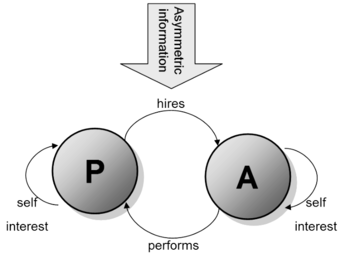
Principle agent problem
The diagram shows the basic idea of the principle agent problem. P is the principle and A is the agent. It clearly illustrates the working relationship between the principle and the agent while highlighting the presence of business partnership as well as self-interest.
- Management (agent) and shareholders (principal)
- Politicians (agent) and voters (principal)
The conflict of interest potentially arises in almost any context where one party is being paid by another to do something, whether it is in formal employment or a negotiated deal. The two parties have different interests and asymmetric information. The deviation of the agent from the principals interest is referred to as “agency costs. “
Contract Design
In order to minimize and control economic conflict, principals and agents design and agree on a contract. It serves as a guide and agreement to safeguard the best interests of both parties. The linear model is used to determine incentive compensation in a contract: w = a + b(e + x + gy).
In the linear model w is the wage, a is a constant, e is the unobserved effort, x is the unobserved exogenous effects on outcomes, and y is the observed exogenous effects; while g and a represent the weight given to y, and the base salary.
A business contract creates a straightforward connection between agent performance and profitability. This connection sets the standard for judging the performance of the agent.
Performance Evaluation
In business relationships, the principal will use performance evaluations to ensure that the agent is fulfilling the necessary duties. There are two forms of performance evaluation:
- objective performance evaluation – takes into account how fast a task can be completed. The evaluation compares the performance of an agent by comparing the work completed by peers within the industry.
- subjective performance evaluation – involves the principal directly evaluating the performance of the agent. In this case, the evaluation is based on opinions instead of observations or reasoning. .
Incentive Structures
Incentive structures are used in business relationship in order to bridge the gap between best interests of the principal and the agent.
Principals offer various incentive structures, which are rewards or motivating factors that drive the agent to work in the best interest of the principal and complete tasks efficiently. Incentive structures include price rates/commissions, profit sharing, and efficiency wages.
It is usually in best interest of both parties to work together. For the principal, agent inefficiency results in sub-optimal results and low welfare. For the agent, efficiency is important in order to receive payment for work completed.
15.1.3: Public Choice: Median Voters and Inefficient Voting Outcomes
Public choice may not lead to an economically efficient outcomes due to who votes, why they vote, and in what system they vote.
Learning Objective
Use the Condorcet paradox to evaluate voting systems
Key Points
- A voting system is a method by which voters choose between multiple options, usually in an election or policy referendum.
- The Condorcet paradox is a voting paradox where collective preferences can be cyclical. It is a paradox because the wishes of the majority can conflict with one another.
- The Condorcet method of voting consists of any election method that elects candidate that would win by majority rule in all pairings against the other candidates.
- Most Condorcet voting methods consist of a single round of voting where individuals rank their top choices. In the event of a tie or unclear winner (Condorcet paradox) alternate methods of determining a winner are used including tie breakers, additional rounds of voting, ect.
Key Terms
- paradox
-
A counter-intuitive conclusion or outcome.
- public choice theory
-
The use of modern economic tools to study problems that traditionally are in the province of political science.
- voting system
-
A system used to determine the result of an election based on voters’ preferences.
A voting system is a method by which voters choose between multiple options, usually in an election or policy referendum. The system enforces rules to ensure valid voting, accurate tabulation, and a final result. Common voting systems include majority rule, proportional representation, or plurality voting. The study of voting systems is called voting theory. Voting theory is a subfield of economics.
Public Choice Theory
No matter what voting system is used, the act of voting gives the public the ability to choose a candidate or influence a decision. Obviously, when voting takes place not everyone will agree with the outcome, but everyone has the ability to participate in the process. Public choice is described as “the use of economic tools to deal with traditional problems of political science. ” In microeconomics, public choice analyses collective decision making and studies economic models of political processes including rent-seeking, elections, legislatures, and voting behavior.
Since not every voter participates in an election, not every voter will have full information, and not every voter will vote based on what s/he perceives as the best long-term outcome, voting outcomes may be inefficient. Elections do not necessarily reflect the best long-term outcome, what the active voters thought was best given their criteria at the time.
Condorcet Paradox
The Condorcet paradox is a voting paradox where collective preferences can be cyclical. It is a paradox because the wishes of the majority can conflict with one another. Conflicting majorities are made up of different groups of individuals. For example, the Condorcet paradox can be compared to the game rock/paper/scissors. For each candidate, there can be another that is preferred by some majority. The Condorcet method of voting consists of any election method that elects candidate that would win by majority rule in all pairings against the other candidates. Most Condorcet voting methods consist of a single round of voting where individuals rank their top choices. In the event of a tie or unclear winner (Condorcet paradox) alternate methods of determining a winner are used including tie breakers, additional rounds of voting, etc.
An example of a voting paradox can be seen in a simple voting scenario. There are three candidates including 1, 2, and 3. There are three voters with preferences. Each voter ranks the candidates from most to least favored . If the results are determined and 3 is the winner, it can be argued that another candidate should have won due to the number of preferred votes verse the first choice of each voter. In this case, the requirement of majority rule does not provide a clear winner. According to the Condorcet paradox additional methods would be needed to determine the winner since the voting process is complex and each voter provides preferences instead of only selecting one candidate.

Preferential voting ballot
The Condorcet paradox is used to evaluate voting systems. Voters rank candidates according to their own preferences. The Condorcet method states that a candidate wins by majority rule.
The Condorcet paradox means that there is not a clear winner and ambiguities must be resolved to determine the election results.
15.1.4: Behavioral Economics: Irrational Actions
Behavioral economics is the study of the effects of social, cognitive, and emotional facts on the financial decisions of individuals and institutions.
Learning Objective
Paraphrase the history and characteristics of behavioral economics
Key Points
- Behavioral economics studies the consequences for market prices, returns, and resource allocation. It focuses on the bounds of rationality of economic agents.
- Behavioral economics analyzes behavioral finance, financial models, and the behavioral game theory in order to gain insight into why certain economic decisions are made.
- Three prevalent themes in behavioral economics are heuristics, framing, and market inefficiencies, though there are many more.
- Throughout its history, behavioral economics has analyzed psychology and economic findings to determine how and why economic decisions are made. Areas of focus included fairness, justice, and utility.
Key Terms
- behavioral economics
-
Study of the effects of social, cognitive, and emotional factors on the economic decisions of individuals and institutions and the consequences for market prices, returns, and resource allocation.
- heuristic
-
Relating to general strategies or methods for solving problems.
Behavioral economics is the study of the effects of social, cognitive, and emotional factors on the economic decisions of individuals and institutions. It also studies the consequences for market prices, returns, and resource allocation. Behavioral economics focuses on the bounds of rationality of economic agents.
Characteristics
Behavioral economics has specific characteristics based on what is studied. Areas of focus include:
- Behavioral finance: the intent is to explain why market participants make systematic errors. Errors impact prices and returns which the create market inefficiencies. It also looks at how other participants take advantage of market inefficiencies.
- Financial models: some financial models used in money management incorporate behavioral financial parameters. Examples of areas studied include overreaction and irrational purchasing habits.
- Behavioral game theory: analyzes interactive strategic decisions and behavior using the methods of game theory, experimental economics, and experimental psychology. Studies interactive learning, social preferences, altruism, framing, and fairness.
There are many aspects in behavioral economics, and three of the most prevalent are:
- Heuristics: people make decisions based on approximate rules and not strict logic.
- Framing: using a collection of anecdotes and stereotypes that make up the mental and emotional filters that individuals rely on the understand and respond to events.
- Market inefficiencies: include the study non-rational decision making and incorrect pricing.
Behavioral economics focuses on the study of how and why individuals and institutions make economic decisions .

Decision making
This graph shows the three stages of rational decision making that was devised by Herbert Simon, a notable economist and scientist.
History
Behavioral economics was born out of the combination of economics and psychology. By 1979, economists used cognitive psychology to explain economic decision making, which included an editing stage and an evaluation stage. The editing stage simplified risky situations using heuristics of choice. The evaluation stage evaluated risky alternatives through the study of dependence, loss aversion, non-linear probability weighting, and sensitivity to gains and losses. Throughout its history, behavioral economics has studied the economic choices of individuals and institutions by analyzing psychology against economic research. The study of behavioral economics shows both the strengths and weaknesses in decision making tendencies and how the decisions impact economic choices.
15.1.5: Government Failure
Government failure occurs when possible interventions are not analyzed before action is taken regarding market inadequacies.
Learning Objective
Analyze situations in which the government has failed to act in an economically optimal way
Key Points
- Government failure, also known as non-market failure, is the public sector version of market failure.
- Government failures can occur in relation to both supply and demand within a market.
- Economic crowding out occurs when the government expands its borrowing to pay for increased expenditure or tax cuts. The expanded borrowing is in excess of its revenue.
- Inefficient government regulation contributes to market and government failure.
Key Terms
- expenditure
-
Act of expending or paying out.
- arbitrage
-
Taking advantage of a price difference between two or more markets: striking a combination of matching deals that capitalize upon the imbalance; the profit made between price differences.
Government Failure
Government failure, also known as non-market failure, is the public sector version of market failure . The market fails and government intervention causes a more inefficient allocation of goods and resources than would occur without the intervention. It occurs when the market inadequacies are not compared and analyzed against possible interventions before action is taken. Government failure can be described as providing “only limited help in prescribing therapies for government success. “
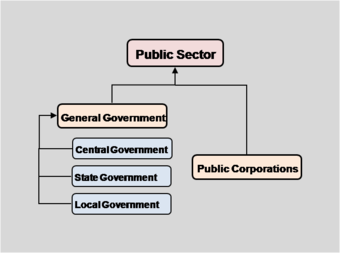
The Public Sector
This graph shows the layers of the government. The government is tied directly to the public sector. Government failure is an analogy made by the public sector when market failure occurs.
A government failure is not the failure of the government to enact a solution to a failure, but rather it is a systematic problem that prevents an efficient government solution to the problem. Government failures can occur in relation to both supply and demand within a market. Demand failures are the result of preference/revelation problems and the imbalance of voting and collective behavior. Supply failures are usually the result of principal-agent problems. In this case, the failure occurs in trying to get one party (agent) to work in the best interest of another party (principal).
Economic Crowding Out
There are specific scenarios that are directly associated with government failure. Economic crowding out occurs when the government expands its borrowing to pay for increased expenditure or tax cuts. The expanded borrowing is in excess of its revenue which crowds out private sector investment due to higher interest rates. Government spending also crowds out private spending.
Government Regulation
When analyzing government failure, inefficient regulation contributes to market failure. The are three specific regulatory inefficiencies:
- Regulatory arbitrage occurs when a regulated institution takes advantage of the difference between its real risk and the regulatory position.
- Regulatory capture occurs when regulatory agencies co-opt whether its the members or the entire regulated industry. Mechanisms that allows regulatory capture include rent seeking and rational ignorance.
- Regulatory risk is a risk faced by private sector firms when there is a chance that regulatory changes will negatively affect their business.
Recent evidence has suggested that even when democracies are economically stable, transparency, media freedom, and a larger government all contribute to increased government corruption. Government corruption leads to both market and government failure.
Chapter 14: Inputs to Production: Labor, Natural Resources, and Technology
14.1: Demand for Labor
14.1.1: Marginal Product of Labor (Physical)
The marginal product of labor is the change in output that results from employing an added unit of labor.
Learning Objective
Define the marginal product of labor
Key Points
- The marginal product of labor is not always equivalent to the output directly produced by that added unit of labor.
- When production is discrete, we can define the marginal product of labor (MPL) as ΔY/ΔL.
- When production is continuous, the MPL is the first derivative of the production function in terms of L.
- Graphically, the MPL is the slope of the production function.
- The law of diminishing marginal returns ensures that in most industries, the MPL will eventually be decreasing.
Key Terms
- returns to scale
-
A term referring to changes in output resulting from a proportional change in all inputs (where all inputs increase by a constant factor).
- marginal product
-
The extra output that can be produced by using one more unit of the input.
In economics, the marginal product of labor (MPL) is the change in output that results from employing an added unit of labor. This is not always equivalent to the output directly produced by that added unit of labor; for example, employing an additional cook at a restaurant may make the other cooks more efficient by allowing more specialization of tasks, creating a marginal product that is greater than that produced directly by the new employee. Conversely, hiring an additional worker onto an already crowded factory floor may make the other employees less productive, leading to a marginal product that is lower than the work done by the additional employee.
When production is discrete, we can define the marginal product of labor as ΔY/ΔL where Y is output. If a factory that is initially producing 100 widgets hires another employee and is then able to produce 106 widgets, the MPL is simply six. When production is continuous, the MPL is the first derivative of the production function in terms of L. Graphically, the MPL is the slope of the production function.
gives another example of marginal product of labor. The second column shows total production with different quantities of labor, while the third column shows the increase (or decrease) as labor is added to the production process.
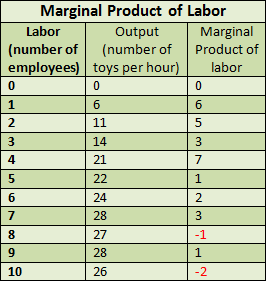
Marginal Product of Labor
This table shows hypothetical returns and marginal product of labor. Note that in reality this firm would never hire more than seven employees, since a negative marginal product is bad for the firm regardless of the wage rate.
The law of diminishing marginal returns ensures that in most industries, the MPL will eventually be decreasing. The law states that “as units of one input are added (with all other inputs held constant) a point will be reached where the resulting additions to output will begin to decrease; that is marginal product will decline. ” The law of diminishing marginal returns applies regardless of whether the production function exhibits increasing, decreasing or constant returns to scale. The key factor is that the variable input is being changed while all other factors of production are being held constant. Under such circumstances diminishing marginal returns are inevitable at some level of production.
14.1.2: Marginal Product of Labor (Revenue)
The marginal revenue product of labor is the change in revenue that results from employing an additional unit of labor.
Learning Objective
Define the marginal product of labor under the marginal revenue productivity theory of wages
Key Points
- The marginal revenue product of a worker is equal to the product of the marginal product of labor (MP:) and the marginal revenue (MR) of output.
- The marginal revenue productivity theory states that a profit maximizing firm will hire workers up to the point where the marginal revenue product is equal to the wage rate.
- The change in output from hiring one more employee is not limited to that directly attributable to the additional worker.
Key Terms
- diminishing marginal returns
-
The decrease in the per-unit output of a production process as the amount of a single factor of production is increased.
- marginal product
-
The extra output that can be produced by using one more unit of the input.
The marginal revenue product of labor (MRPL) is the change in revenue that results from employing an additional unit of labor, holding all other inputs constant. The marginal revenue product of a worker is equal to the product of the marginal product of labor (MPL) and the marginal revenue (MR) of output, given by MR×MP: = MRPL. This can be used to determine the optimal number of workers to employ at an exogenously determined market wage rate. Theory states that a profit maximizing firm will hire workers up to the point where the marginal revenue product is equal to the wage rate, because it is not efficient for a firm to pay its workers more than it will earn in revenues from their labor.
For example, if a firm can sell t-shirts for $10 each and the wage rate is $20/hour, the firm will continue to hire workers until the marginal product of an additional hour of work is two t-shirts. If the MPL is three t-shirts the first will hire more workers until the MPL reaches two; if the MPL is one t-shirt then the firm will remove workers until the MPL reaches two.
Let TR=Total Revenue; L=Labor; Q=Quantity. Mathematically:
- MRPL= ∆TR/∆L
- MR = ∆TR/∆Q
- MPL = ∆Q/∆L
- MR x MPL = (∆TR/∆Q) x (∆Q/∆L) = ∆TR/∆L
Note that the change in output is not limited to that directly attributable to the additional worker. Assuming that the firm is operating with diminishing marginal returns then the addition of an extra worker reduces the average productivity of every other worker (and every other worker affects the marginal productivity of the additional worker) – in other words, everybody is getting in each other’s way.
Because the MRPL is equal to the marginal product of labor times the price of output, any variable that affects either MPL or price will affect the MRPL. For example, changes in technology or the quantity of other inputs will change the marginal product of labor, and changes in the product demand or changes in the price of complements or substitutes will affect the price of output. These will all cause shifts in the MRPL.
14.1.3: Deriving the Labor Demand Curve
Firms will demand labor until the marginal revenue product of labor is equal to the wage rate.
Learning Objective
Explain how a company uses marginal revenue product in hiring decisions
Key Points
- The marginal revenue product of labor (MRPL) is the additional amount of revenue a firm can generate by hiring one additional employee. It is found by multiplying the marginal product of labor by the price of output.
- Firms will demand labor until the MRPL equals the wage rate.
- The demand curve for labor can be shifted by shifted by changes in the productivity of labor, the relative price of labor, or the price of the output.
- It will also change as a result of a change in technology, a change in the price of the good being produced, or a change in the number of firms hiring the labor.
Key Terms
- marginal revenue product
-
The change in total revenue earned by a firm that results from employing one more unit of labor.
- factor of production
-
A resource employed to produce goods and services, such as labor, land, and capital.
Firms demand labor and an input to production. The cost of labor to a firm is called the wage rate. This can be thought of as the firm’s marginal cost. The additional revenue generated by hiring one more unit of labor is the marginal revenue product of labor (MRPL). This can be thought of as the marginal benefit.
The marginal revenue product of labor (MRPL) is the additional amount of revenue a firm can generate by hiring one additional employee. It is found by multiplying the marginal product of labor (MPL) – the amount of additional output one additional worker can generate – by the price of output. If an employee of a customer support call center can take eight calls an hour (the MPL) and each call earns the company $3, then the MRPL is $24.
We can use the MRPL curve to determine the quantity of labor a company will hire. Suppose workers are available at an hourly rate of $10. The amount a factor adds to a firm’s total cost per period is the marginal cost of that factor, so in this case the marginal cost of labor is $10. Firms maximize profit when marginal costs equal marginal revenues, and in the labor market this means that firms will hire more employees until the wage rate (marginal cost of labor) equals the MRPL. At a price of $10, the company will hire workers until the last worker hired gives a marginal revenue product of $10 .
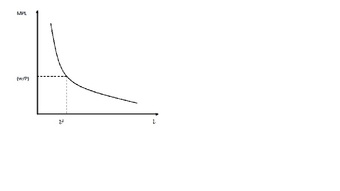
Marginal Product of Labor
The MPL falls as the amount of labor employed increases. The optimum demand for labor falls where the real wage rate (w/P) is equal to the MPL.
Thus, the downward-sloping portion of the marginal revenue product curve shows the number of employees a company will hire at each price (wage), so we can interpret this part of the curve as the firm’s demand for labor. As with other demand curves, the market demand curve for labor is the sum of all firm’s individual demand curves.
Shifting the Demand for Labor
There are three main reasons why the demand curve for labor may shift:
- Changes to the marginal productivity of labor: Technology, for instance, may increase the marginal productivity of labor, shifting the demand curve to the right. For example, computer technology has increased the productivity (marginal product) of many types of workers. This has led to an increase in the marginal revenue product of labor for these jobs, shifting firms’ demand for labor to the right. This both increases the number of employed workers and increases the wage rate.
- The prices of other factors of production: The change in the relative price of labor will increase or decrease demand for labor. For example, is capital becomes more expensive relative to labor, the demand for labor will increase as firms seek to substitute labor for capital.
- The price of the firm’s output: Since the price of the output is a component of MRPL, changes will shift the demand curve for labor. If the price that a firm can charge for its output increases, for example, the MRPL will increase. This is reflected in an outward shift of the demand for labor.
14.2: Labor Market Equilibrium and Wage Determinants
14.2.1: Conditions of Equilibrium
Equilibrium in the labor market requires that the marginal revenue product of labor is equal to the wage rate, and that MPL/PL=MPK/PK.
Learning Objective
Employ the marginal decision rule to determine the equilibrium cost of labor
Key Points
- Firms will hire more labor when the marginal revenue product of labor is greater than the wage rate, and stop hiring as soon as the two values are equal.
- The point at which the MRPL equals the prevailing wage rate is the labor market equilibrium.
- The marginal decision rule says that a firm will shift spending among factors of production as long as the marginal benefit of such a shift exceeds the marginal cost.
- If the marginal benefit of additional labor, MPL/PL, exceeds the marginal cost, MPK/PK, then the firm will be better off by spending more on labor and less on capital.
- According to the marginal decision rule, equilibrium in the labor market must occur where MPL/PL=MPK/PK.
Key Terms
- capital
-
Already-produced durable goods available for use as a factor of production, such as steam shovels (equipment) and office buildings (structures).
- marginal revenue product
-
The change in total revenue earned by a firm that results from employing one more unit of labor.
- marginal product
-
The extra output that can be produced by using one more unit of the input.
The labor market differs somewhat from the market for goods and services because labor demand is a derived demand; labor is not desired for its own sake but rather because it aids in producing output. Firms determine their demand for labor through a lens of profit maximization, ultimately seeking to produce the optimum level of output and the lowest possible cost.
Labor Market Equilibrium
In order to find the equilibrium quantity and price of labor, economists generally make several assumptions:
- The marginal product of labor (MPL) is decreasing;
- Firms are price-takers in the goods market (cannot affect the price of output) as well as in the labor market (cannot affect the wage rate);
- The supply of labor is elastic and increases with the wage rate (upward sloping supply); and
- Firms are profit-maximizers.
The marginal revenue product of labor (MRPL) is equal to the MPL multiplied by the price of output. The MRPL represents the additional revenue that a firm can expect to gain from employing one additional unit of labor – it is the marginal benefit to the firm from labor. Under the above assumptions, the MRPL is decreasing as the quantity of labor increases, and firms can increase profit by hiring more labor if the MRPL is greater than the marginal cost of that additional unit of labor – the wage rate. Thus, firms will hire more labor when the MRPL is greater than the wage rate, and stop hiring as soon as the two values are equal. The point at which the MRPL equals the prevailing wage rate is the labor market equilibrium.
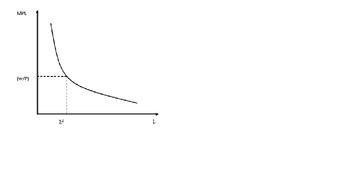
Optimal Demand for Labor
The optimal demand for labor is located where the marginal product equals the real wage rate. The curved line represents the falling marginal product of labor, the y-axis is the marginal product/wage rate, and the x-axis is the quantity of labor.
Optimizing Capital and Labor
In the long run, firms maximize profit by choosing the optimal combination of labor and capital to produce a given amount of output. It’s possible that an automobile company could manufacture 1,000 cars using only expensive, technologically advanced robots and machinery (capital) that do not require any human participation. It’s also possible that the company could produce the same number of vehicles using only employee work (labor), without any assistance from machines or technology. For most industries, however, relying solely on capital or solely on labor is more expensive than using some combination of the two .

Factory Worker
Most firms need a combination of both labor and capital in order to produce their product.
Firms use the marginal decision rule in order to decide what combination of labor, capital, and other factors of production to use in the creation of output. The marginal decision rule says that a firm will shift spending among factors of production as long as the marginal benefit of such a shift exceeds the marginal cost. Imagine that a firm must decide whether to spend an additional dollar on labor. To determine the marginal benefit of that dollar, we divide the marginal product of labor (MPL) by it’s price (the wage rate, PL): MPL/PL. If capital and labor are the only factors of production, then spending an additional $1 on labor while holding the total cost constant means taking $1 out of capital. The cost of that action will be the output lost from cutting back on capital, which is the ratio of the marginal product of capital (MPK) to the price of capital (the rental rate, PK). Thus, the cost of cutting back on capital is MPK/PK.
If the marginal benefit of additional labor, MPL/PL, exceeds the marginal cost, MPK/PK, then the firm will be better off by spending more on labor and less on capital. On the other hand, if MPK/PK is greater than MPL/PL, the firm will be better off spending more on capital and less on labor. The equilibrium – the point at which the firm is producing the maximum amount of output at a given cost – occurs where MPL/PL=MPK/PK.
14.2.2: The Wage Rate
The wage rate is determined by the intersection of supply of and demand for labor.
Learning Objective
Describe the factors that determine the wage rate
Key Points
- An increase in demand or a reduction in supply will raise wages; an increase in supply or a reduction in demand will lower them.
- The demand curve depends on the marginal product of labor and the price of the good labor produces. If the demand curve shifts to the right, either because productivity or the price of output has increased, wages will be pushed up.
- In the long run the supply of labor is simply a function of the population size, but in the short run it depends on variables such as worker preferences, the skills and training a job requires, and wages available in alternative occupations.
Key Terms
- Union
-
an organization of workers who have banded together to achieve common goals
- marginal product
-
The extra output that can be produced by using one more unit of the input.
When labor is an input to production, firms hire workers. Firms are demand labor and workers provide it at a price called the wage rate. Colloquially, “wages” refer to just the dollar amount paid to a worker, but in economics, it refers to total compensation (i.e. it includes benefits).
The marginal benefit of hiring an additional unit of labor is called the marginal product of labor: it is the additional revenue generated from the last unit of labor. In theory, as with other inputs to production, firms will hire workers until the wage rate (marginal cost) equals the marginal revenue product of labor (marginal benefit).
Changes in Supply and Demand
In competitive markets, the demand curve for labor is the same as the marginal revenue curve. Thus, shifts in the demand for labor are a function of changes in the marginal product of labor. This can occur for a number of reasons. First of all, you can imagine that a new product or company is created that represents new demand for labor of a certain type. There are also three main factors that would shift the labor demand curve:
- Technology which affects the output of a unit of labor.
- Changes in the price of the output which affect the value of the unit of labor.
- Changes in the price of labor relative to other factors of production.
In the long run, the supply of labor is a function of the population. A decrease in the supply of labor will typically cause an increase in the wage rate. The fact that a reduction in supply tends to strengthen wages explains why unions and other professional associations have often sought to limit the number of workers in their particular industry. Physicians, for example, have a financial incentive to enforce rigorous training, licensing, and certification requirements in order to limit the number of practitioners and keep the labor supply low .
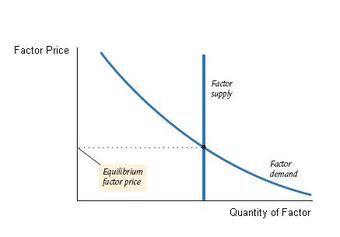
Wage Rate in the Long Run
In the long run the supply of labor is fixed and demand is downward-sloping. The wage rate is determined by their intersection.
14.2.3: Compensation Differentials
Some differences in wage rates across places, occupations, and demographic groups can be explained by compensation differentials.
Learning Objective
Describe nonmonetary factors that affect wage rates
Key Points
- Although basic economic theory suggests that there ought to be one prevailing wage rate for all labor, this is not the case.
- Wage differences are called compensation differentials and can be explained by many factors, such as differences in the skills of the workers, the country or geographical area in which jobs are performed, or the characteristics of the jobs themselves.
- One common source of differences in wage rates is human capital. More skilled and educated workers tend to have higher wages because their marginal product of labor tends to be higher.
- If a certain area is a desirable place to live, the supply of labor will be higher than in other areas and wages will be lower. This is a type of geographical differential.
- Discrimination against gender or racial groups can cause compensation differentials.
- A compensating differential is the additional amount of income that a given worker must be offered in order to motivate them to accept a given undesirable job, relative to other jobs that worker could perform.
Key Terms
- discrimination
-
Distinct treatment of an individual or group to their disadvantage; treatment or consideration based on class or category rather than individual merit; partiality; prejudice; bigotry.
- differential
-
a qualitative or quantitative difference between similar or comparable things
According to the basic theory of the labor market, there ought to be one equilibrium wage rate that applies to all workers across industries and countries. Of course this is not the case; doctors typically make more per hour than retail clerks, and workers in the United States typically earn a higher wage than workers in India. These wage differences are called compensation differentials and can be explained by many factors, such as differences in the skills of the workers, the country or geographical area in which jobs are performed, or the characteristics of the jobs themselves.
Education Differentials
One common source of differences in wage rates is human capital. More skilled and educated workers tend to have higher wages because their marginal product of labor tends to be higher . Additionally, the differential pay for more education tends to compensate workers for the time, effort, and foregone wages from obtaining the necessary training. If all jobs paid the same rate, for example, fewer people would go through the expense and effort of law school. The compensation differential ensures that individuals are willing to invest in their own human capital.

Education Differentials
Workers seek increased compensation by attaining higher levels of education
Geographic Compensation Differentials
If a certain part of a country is a particularly attractive area to live in and if labor mobility is perfect, then more and more workers will move to that area, which in turn will increase the supply of labor and depress wages. If the attractiveness of that area compared to other areas does not change, the wage rate will be set at such a rate that workers will be indifferent between living in areas that are more attractive but with a lower wage and living in areas which are more attractive with a higher wage. In this way, a sustained equilibrium with different wage rates across different areas can occur.
Discrimination and Compensation Differentials
In the United States, minorities and women make lower wages on average than Caucasian men. Some of this is due to historical trends affecting these groups that result in less human capital or a concentration in certain lower-paying occupations. Another source of differing wage rates, however, is discrimination. Several studies have shown that, in the United States, several minority groups (including black men and women, Hispanic men and women, and white women) suffer from decreased wage earning for the same job with the same performance levels and responsibilities as white males.
Compensating Differential
Not to be confused with a compensation differential, a compensating differential is a term used in labor economics to analyze the relation between the wage rate and the unpleasantness, risk, or other undesirable attributes of a particular job. It is defined as the additional amount of income that a given worker must be offered in order to motivate them to accept a given undesirable job, relative to other jobs that worker could perform. One can also speak of the compensating differential for an especially desirable job, or one that provides special benefits, but in this case the differential would be negative: that is, a given worker would be willing to accept a lower wage for an especially desirable job, relative to other jobs. .

Hazard Differential
Hazard pay is a type of compensating differential. Occupations that are dangerous, such as police work, will typically have higher pay to compensate for the risk associated with that job.
14.2.4: Performance and Pay
Theoretically there is a direct connection between job performance and pay, but in reality other factors often distort this relationship.
Learning Objective
Identify the relationship between performance and wages
Key Points
- According to economic theory, workers’ wages are equal to the marginal revenue product of their labor. If one employee is very productive he or she will have a high marginal revenue product.
- In reality, wages are determined not only by one’s productivity, but also by seniority, networking, ambition, and luck.
- Some of the disconnect between performance and pay can be addressed with alternate pay schemes.
Key Terms
- commission
-
A fee charged by an agent or broker for carrying out a transaction
- piece work
-
Work that a worker is paid for according to the number of units produced, rather than the number of hours worked.
According to economic theory, workers’ wages are equal to the marginal revenue product of their labor. If one employee is very productive he or she will have a high marginal revenue product: one additional hour of their work will produce a significant increase in output. It follows that more productive employees should have higher wages than less productive employees. Imagine if this were not true: a firm decides to pay a highly productive worker less than the marginal revenue product of his labor. Any other firm could make a profit by offering a higher salary to attract the productive employee to their company, and the worker’s wage would rise. Theoretically, therefore, there is a direct relationship between job performance and pay.
We know that this is not always the case in reality. Wages are determined not only by one’s productivity, but also by seniority, networking, ambition, and luck. It is very rare for an entry-level worker to make the same wage as an experienced member of the same profession regardless of their relative levels of productivity because the older worker has had time to receive pay raises and promotions for which the younger employee is simply not eligible. Discrimination is sometimes responsible for members of minority racial or gender groups receiving wages that are less than wages for the majority group even when productivity levels are the same. Finally, outside forces, such as unions or government regulations, can distort pay rates .
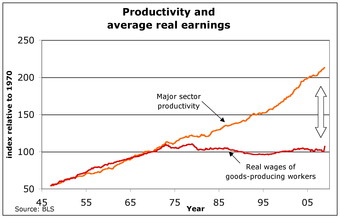
Wages and Productivity in the U.S.
On a macroeconomic level, this graph shows the disconnect, beginning around 1975, between the productivity of labor and the wage rate in the U.S. If the economic theory were correct in the real world, wages and productivity would increase together.
Linking Performance and Pay
Some of the disconnect between performance and pay can be addressed with alternate pay schemes. While a salary or hourly pay does not directly take into account the quality of work, performance-related pay compensates workers with higher levels of productivity directly. One example is commission-based pay. In this type of pay scheme, workers receive some percentage of the profit that they generate for their company. This may be paid on top of a baseline salary or may be the only form of compensation. This type of system is very common among car salespeople and insurance brokers.
Another alternative is piece-work, in which employees are paid a fixed rate for every unit produced or action performed, regardless of the time it takes. This is common in settings where it is easy to measure the output of piece work, such as when a garment worker is paid per each piece of cloth sewn or a telemarketer is paid for every call placed.
14.2.5: Marginal Revenue Productivity and Wages
In a perfectly competitive market, the wage rate is equal to the marginal revenue product of labor.
Learning Objective
Explain how wages are determines by marginal revenue productivity
Key Points
- In the long run the supply of labor is a simple function of the size of the population, so in order to understand changes in wage rates we focus on the demand for labor.
- The marginal product of labor (MPL) is the increase in output that a firm experiences from adding one additional unit of labor.
- The marginal benefit to the firm of hiring an additional unit of labor is called the marginal revenue product of labor (MRPL). It is calculated by multiplying MPL by the price of the output.
- The MRPL represents the firm’s demand curve for labor, which means that the firm will continue to hire more labor until the MRPL is equal to the wage rate.
Key Terms
- marginal benefit
-
The extra benefit received from a small increase in the consumption of a good or service. It is calculated as the increase in total benefit divided by the increase in consumption.
- marginal revenue product
-
The change in total revenue earned by a firm that results from employing one more unit of labor.
Just as in any market, the price of labor, the wage rate, is determined by the intersection of supply and demand. When the supply of labor increases the equilibrium price falls, and when the demand for labor increases the equilibrium price rises. In the long run the supply of labor is a simple function of the size of the population, so in order to understand changes in wage rates we focus on the demand for labor.
To determine demand in the labor market we must find the marginal revenue product of labor (MRPL), which is based on the marginal productivity of labor (MPL) and the price of output. Conceptually, the MRPL represents the additional revenue that the firm can generate by adding one additional unit of labor (recall that MPL is the additional output from the additional unit of labor). Thus, MRPL is simply the product of MPL and the price of the output.
The MPL is generally decreasing: adding a 100th unit of labor will not increase output as much as adding a 99th. Since competitive industries are price takers and cannot change the price of output by changing their level of production, the MRPL curve will have the same downward slope as the MPL curve.
From the perspective of the firm, the MRPL is the marginal benefit to the firm of hiring an additional unit of labor. We know that a profit-maximizing firm will increase its factors of production until their marginal benefit is equal to the marginal cost. Therefore, firms will continue to add labor (hire workers) until the MRPL equals the wage rate. Thus, workers earn a wage equal to the marginal revenue product of their labor. For example, in a perfectly competitive market, an employee who earns $20/hour has a marginal productivity that is worth exactly $20 .
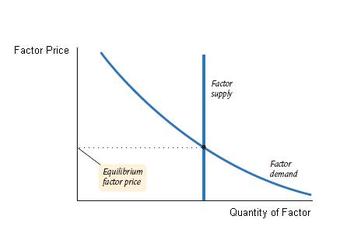
Marginal Product and Wages
The graph shows that a factor of production – in our case, labor – has a fixed supply in the long run, so the wage rate is determined by the factor demand curve – in our case, the marginal revenue product of labor. The intersection of vertical supply and the downward sloping demand gives the wage rate.
14.2.6: Changes in Equilibrium for Shifts in Market Supply and Market Demand
A shift in the supply or demand of labor will cause a change in the market equilibrium.
Learning Objective
Discuss the factors that influence the shape and position of the labor supply curve
Key Points
- The opportunity cost of leisure is the wages lost while not working; as wages rise, the cost of leisure increases.
- The substitution effect means that when wages rise, people are likely to substitute more labor for less leisure.
- However, the income effect means that as people become wealthier, their demand for normal goods such as leisure increases.
- Typically the substitution effect dominates the supply of labor at normal wage rates, but the income effect may come to dominate at higher wage rates. This creates a backward bending labor supply curve.
- The supply curve for labor will shift in response to changes in preferences, changes in income, changes in population, and changes in expectations.
- The demand curve for labor will shift in response to changes in human capital, changes in technology, changes in the price of complements or substitutes for output, and changes in consumer preferences.
Key Terms
- Opportunity cost
-
The cost of any activity measured in terms of the value of the next best alternative forgone (that is not chosen).
- normal good
-
A good for which demand increases when income increases and falls when income decreases but price remains constant.
As in all competitive markets, the equilibrium price and quantity of labor is determined by supply and demand.
Labor Supply
Labour supply curves are derived from the ‘labor-leisure’ trade-off. More hours worked earn higher incomes but necessitate a cut in the amount of other things workers enjoy such as going to movies, hanging out with friends, or sleeping. The opportunity cost of working is leisure time and vis versa. Considering this tradeoff, workers collectively offer a set of labor to the market which economists call the supply of labor.
To see how changes in wages affect the supply of labor, suppose wages rise. This increases the cost of leisure and causes the supply of labor to rise – this is the substitution effect, which states that as the relative price of one good increases, consumption of that good will decrease. However, there is also an income effect – an increased wage means higher income, and since leisure is a normal good, the quantity of leisure demanded will go up. In general, at low wage levels the substitution effect dominates the income effect and higher wages cause an increase in the supply of labor. At high incomes, however, the negative income effect could offset the positive substitution effect and higher wage levels could actually cause labor to decrease. A worker making $800/hour who receives a raise to $1200/hour may not have much use for the extra money and may choose to work less while maintaining the same standard of living, for example. This creates a supply curve that bends backwards, initially increasing with the wage rate but later decreasing.
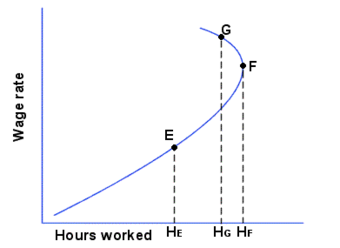
Backward Bending Supply
While normally hours of labor supplied will increase with the wage rate, the income effect may produce the opposite effect at high wage levels.
People supply labor in order to increase their utility—just as they demand goods and services in order to increase their utility. The supply curve for labor will shift in response to changes in the same factors that shift demand for goods and services. These include changes in preferences, changes in income, changes in population, and changes in expectations. A change in preferences that causes people to prefer more leisure, for example, will shift the supply curve to the left, creating a lower level of employment and a higher wage rate.
Labor Demand
An increase in the demand for labor will increase both the level of employment and the wage rate. We have already seen that the demand for labor is based on the marginal product of labor and the price of output. Thus, any factor that affects productivity or output prices will also shift labor demand. Some of these factors include:
- Available technology (marginal productivity of labor)
- The skills or education of the workforce (marginal productivity of labor)
- Level of physical capital (marginal productivity of labor)
- Price of physical capital (price of output)
- Price of substitute or complement goods (price of output)
- Consumer preferences (price of output)
All of the above may cause the demand for labor to shift and change the equilibrium quantity and price of labor.
14.2.7: Labor Union Impacts on Equilibrium
Unions are organizations of workers that seek to improve working conditions and raise the equilibrium wage rate.
Learning Objective
Examine the role of unions and collective bargaining in labor-firm relations
Key Points
- Unions’ primary work involves negotiating wages, work rules, complaint procedures, promotions, benefits, workplace safety and policies with company management.
- If the labor market is a competitive one in which wages are determined by demand and supply, increasing the wage requires either increasing the demand for labor or reducing the supply.
- Increasing demand for labor requires increasing the marginal product of labor or raising the price of the good produced by labor.
- Increasing demand for labor requires increasing the marginal product of labor or raising the price of the good produced by labor.
- Unions can restrict the supply of labor in two ways: slowing the growth of the labor force and promoting policies that make it difficult for workers to enter a particular craft.
Key Terms
- collective bargaining
-
A method of negotiation in which employees negotiate as a group with their employers.
- strike
-
A work stoppage (or otherwise concerted stoppage of an activity) as a form of protest.
- minimum wage
-
The lowest rate at which an employer can legally pay an employee; usually expressed as pay per hour.
A labor union is an organization of workers who have banded together to achieve common goals. The primary activity of the union is to bargain with the employer on behalf of union members and negotiate labor contracts. The most common purpose of associations or unions is maintaining or improving the conditions of employment, which may include the negotiation of wages, work rules, complaint procedures, promotions, benefits, workplace safety, and policies.
In order to achieve these goals unions engage in collective bargaining: the process of negotiation between a company’s management and a labor union. When collective bargaining fails, union members may go on strike, refusing to work until a firm addresses the workers’ grievances.
Union Impacts on Equilibrium
Fundamentally, unions seek higher wages for its member workers (though, here “wages” encompases all types of compensation, not just cash paid to the workers by the employer).
The effect of unions on the labor market equilibrium can be analyzed like any other price increase. If employers (those who demand labor) have an inelastic demand for labor, the increase in wages (the price of labor) will not translate into a drop in employment (quantity of labor supplied). If, however, their demand is elastic, employers will simply respond to union demands for higher wages by hiring fewer workers.
However, the reality of unions is more complex. As an organized body, unions are also active in the political realm. They can lobby for legislation that will affect the market not only for labor, but also for the goods they produce. For example, unions may advocate for trade restrictions to protect the markets in which they work from foreign competition. By preventing domestic firms from having to compete with unrestricted foreign firms, they can ensure that consumers do not have lower cost alternatives which would drive employers who pay a higher union wage out of business.

Union Members Strike
One tool that unions may use to raise wages is to go on strike.
14.3: Income Distribution
14.3.1: How Income is Allocated
Recent growth in overall income inequality has been driven mostly by increasing inequality in wages and salaries.
Learning Objective
Discuss factors that contribute to income inequality
Key Points
- There is a potential role for government to correct the market failures that have propelled the rise in income inequality.
- Common factors thought to impact domestic economic inequality include labor market outcomes, globalization, technological changes, policy reforms, more regressive taxation, and discrimination.
- Some government tools for affecting income distribution are policies, hiring regulations, and progressive taxation.
Key Terms
- regressive
-
Whose rate decreases as the amount increases.
- progressive
-
Gradually advancing in extent; increasing.
- globalization
-
The process of international integration arising from the interchange of world views, products, ideas, and other aspects of culture.
Recent growth in overall income inequality has been driven mostly by increasing inequality in wages and salaries. Globalization has contributed to some portion of rising inequality as jobs have moved to lower wage geographies, placing downward pressure on wages of higher cost of living countries. However, economists view the impact of technological progress to outweigh the effect of globalization, as technology has effectively been substituted for more expensive wage labor. Policy reforms and regressive taxation have promoted disparity but are relatively minor contributors to existing inequality. Discrimination and favoritism in the workplace has continued to limit advancement of minority groups and women, but evidence reveals that wage related impacts to marginalized groups diminish with the increase in educational attainment.
Common factors thought to impact domestic economic inequality include:
- Labor market outcomes
- Globalization
- Technological changes
- Policy reforms
- More regressive taxation
- Discrimination
Globally, income inequality has increased over the last few decades. In the U.S., recent studies have stated that the wealthiest 400 Americans control nearly 50% of domestic wealth. Given that economic theory points to a decline in income inequality over time, the recent increase has led many researchers to conclude that we may be starting a new inequality cycle .
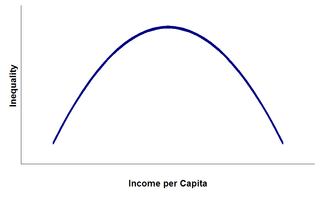
Kuznets curve
The Kuznets curve depicts the relationship between inequality and income; after hitting a market peak, inequality will decrease as income increases. Recent economic trends have caused researchers to believe that the economy may have started on a new Kuznet’s curve given the heightening economic inequality.
Role of Government
The market for labor is not completely transparent, competition is imperfect, information unevenly distributed, opportunities to acquire education and skills unequal, and since many such imperfect conditions exist in virtually every market, there is in fact little presumption that markets are in general efficient. This means that there is an enormous potential role for government to correct these market failures.
Governments have a number of tools with which they can affect income distribution. One way in which governments attempt to decrease income inequality is through progressive taxation. Wealthier people pay proportionally more of their income in taxes, which are then used to pay for services for the poor. Government can also place regulations of hiring and firing practices to address issues such as discrimination.
14.3.2: Current Topics in Income Distribution
Income inequality in the United States has grown significantly since the early 1970s.
Learning Objective
Describe trends in income inequality in the U.S.
Key Points
- While inequality has risen among most developed countries, and especially English-speaking ones, it is highest in the United States.
- The fruits of overall growth have accrued disproportionately to the top 1%.
- According to PolitiFact and others, 400 Americans now own more than 50% of the net wealth of the United States.
Key Term
- inequality
-
An unfair, not equal, state.
While income inequality has risen among most developed countries, and especially English-speaking ones, it is highest in the United States. Income inequality in the United States has grown significantly since the early 1970s and has been the subject of study of many scholars and institutions.
Most of the income growth has been between the middle class and top earners, with the disparity becoming more extreme the further one goes up in the income distribution. A 2011 study by the Congressional Budget Office (CBO) found that the top earning 1% of households increased their income by about 275% after federal taxes and income transfers over a period between 1979 and 2007, compared to a gain of just under 40% for the 60% in the middle of America’s income distribution. Scholars and others differ as to the causes, solutions, and the significance of the trend, which in 2011 helped ignite the “Occupy” protest movement. As a result, inequality has been described both as irrelevant in the face of economic opportunity (or social mobility) in America, and as a cause of the decline in that opportunity.
Yale professor and economist Robert J. Shiller, who was among three Americans who won the Nobel prize for economics in 2013, believes that rising economic inequality in the United States and other countries is “the most important problem that we are facing now today. “
Brief History of Income Disparity in America
The first era of inequality lasted roughly from the post-civil war era (“the Gilded Age”) to sometime around 1937. But from about 1937 to 1947, a period that has been dubbed the “Great Compression,” income inequality in America fell dramatically. Highly progressive New Deal taxation, the strengthening of unions, and regulation of the National War Labor Board during World War II raised the income of the poor and working class and lowered that of top earners. This “middle class society” characterized by a relatively low level of inequality remained fairly steady for about three decades ending in early 1970s. The return to high inequality or what has been referred as the “Great Divergence,” began in the 1970s. It was caused mainly due to the widening gap between middle and top earners.
Recent History: Inequality on the Rise
The income growth of the average American family closely matched that of economic productivity until some time in the 1970s. However, while income began to stagnate, productivity continued to climb .
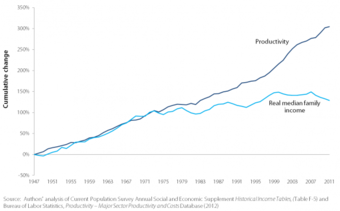
U.S. Income over time
Though productivity gains were primarily the basis for the increase in U.S. income, in more recent times, productivity increases have not been captured in income increases for the majority of U.S. families as noted in the graph.
In 2013, the Economic Policy Institute noted that even though corporate profits are at historic highs, the wage and benefit growth of the vast majority has stagnated. The fruits of overall growth have accrued disproportionately to the top 1%. According to PolitiFact and others, 400 Americans now own more than 50% of the net wealth of the United States.
14.4: Capital and Natural Resource Markets
14.4.1: Other Factors of Production
There are three factors of production that are required to produce economic output: land, labor, and capital.
Learning Objective
Discuss the role of capital and resources in production
Key Points
- Land includes the site where goods are produced as well as all the minerals below and above the site.
- Labor includes all human effort used in production as well as the necessary technical and marketing expertise.
- Capital are the human-made goods used in the production of other goods, such as machinery and buildings. It does not include cash.
Key Term
- capital
-
Already-produced durable goods available for use as a factor of production, such as steam shovels (equipment) and office buildings (structures).
Factors of production are the inputs to the production process. Finished goods are the output. Input determines the quantity of output; in other words, output depends upon input. Input is the starting point and output is the end point of a production process and such input-output relationship is called a production function. There are three basic, otherwise known as classical, factors of production:
- Land:which includes the site where goods are produced as well as all the minerals below and above the site;
- Labor:which includes all human effort used in production as well as the necessary technical and marketing expertise; and
- Capital: which are the human-made goods used in the production of other goods, such as machinery and buildings .
Land is sometime included with capital in certain situations, such as in service industries where land has little importance. All three of these are required in combination at a time to produce a commodity. In economics, production means creation or an addition of utility. Factors of production (or productive ‘inputs’ or ‘resources’) are any commodities or services used to produce goods or services.
Further Defining Capital
In accounting and other disciplines, the phrase “capital” can also refer to cash that have been invested in a business. The classical economists also employed the word “capital” in reference to money. Money, however, was not considered to be a factor of production in the sense of capital stock since it is not used to directly produce any good. The return to loaned money or to loaned stock was styled as interest while the return to the actual proprietor of capital stock (tools, etc.) is classified as profit.
It is important to note that the final output is the result of the combination of all of the inputs. Things like technological advancement and worker productivity are intricately tied to the productivity of the inputs; it is not enough to simply have the factors of production in one place without the knowledge and ability to convert them into the correct outputs.
14.4.2: The Importance of Factor Prices
The prices of different factors of production can help determine which products a country will produce.
Learning Objective
Explain how changes in resource prices affect production
Key Points
- The exports of a capital-abundant country will be from capital-intensive industries, and relatively labor-abundant countries will import such goods, exporting labor intensive goods in return.
- In the long-run, entities will specialize in what costs them comparatively less to produce.
- If one factor of production becomes more plentiful, and therefore cheaper, it will cause production of the good that relies on that factor to increase.
Key Term
- comparative advantage
-
The ability of a party to produce a particular good or service at a lower margin and opportunity cost over another.
Comparative advantage is the ability of one country or region to produce a particular good or service at a lower opportunity cost than another. This idea suggests that in the long-run, entities will specialize in what costs them less to produce. These entities will then trade the goods they produce for the items that it would be expensive for them to produce. As a result, the prices of different factors of production can help dictate which products a country will choose to produce.

Trade
Trade and comparative advantage are why factor prices are so important in determining what a country produces. Trade allows a country to produce only what is comparatively cheaper for them to manufacture because they can get everything else they need through trade.
This idea was expanded upon in the Heckscher-Ohlin Model (H-O model), which was designed to be used to predict patterns of international commerce. This model is premised on several assumptions. These assumptions are:
- All countries have identical production technology;
- Production output is assumed to exhibit constant returns to scale;
- The technologies used to produce the two commodities differ;
- Factor mobility within countries;
- Factor immobility between countries;
- Commodity prices are the same everywhere; and
- Perfect internal competition.
If these assumptions are held to be true, the HO-model suggests that the exports of a capital-abundant country will be from capital-intensive industries, and labor-abundant countries will import such goods, exporting labor intensive goods in return.
For example, a country where capital and land are abundant but labor is scarce will have comparative advantage in goods that require lots of capital and land, but little labor. If capital and land are abundant, their prices will be low. As capital and land the main factors used in the production of grain, the price of grain will also be low, and thus attractive for both local consumption and export. Labor intensive goods on the other hand will be very expensive to produce since labor is scarce and its price is high. Therefore, the country is better off importing those goods.
Shifts in Factor Prices
Assuming the cost of relative goods remain constant, if one factor of production becomes more or less expensive, it can cause a significant shift of what is produced in that country.
If one factor of production becomes more plentiful, and therefore cheaper, it will cause production of the good that relies on that factor to increase. In response to that increase, the country will produce fewer goods that rely on other factors.
For example, imagine a country has a population boom from immigration. Its supply of labor will increase. As a result, the price of labor decreases. This country produces one good that is labor intensive, clothes, and one that is capital intensive, cars. When the cost of labor decreases, the country will produce more clothes and less cars. This is not necessarily a one-to-one relationship where the production of one more shirt means one less car is produced; the only thing that can be predicted is an overall shift in production levels.
It is important to note that the shifts in factor prices described above are based entirely on the assumptions found in the H-O Model. It is rare that a real market would meet all of those standards, so the results in the real world might vary from what this section describes.
14.4.3: Marginal Productivity and Resource Demand
Firms will demand more of a resource if the marginal product of the resource is greater than the marginal cost.
Learning Objective
Explain the relationship between marginal productivity and resource demand
Key Points
- When firms have positive net marginal products of resources, the demand for the resource will increase.
- Some resources are subject to the typical market constraints of supply and demand.
- Some resources are public goods, which means that they could be depleted if firms that have positive net marginal products from the resource are not regulated.
Key Term
- marginal productivity
-
The extra output that can be produced by using one more unit of the input
The marginal product of a given resource is the additional revenue generated by employing one more unit of the resource. In the case of labor, for example, the marginal product of labor is the additional value generated for the company by hiring one additional worker. A firm will continue to employ more of the resource until the marginal revenue equals the marginal cost to the firm. The same concept applies to all resources that can be used in production, whether its labor or wood or land.
Since firms will seek to use additional resources if the net marginal product is positive, they can affect the demand for the resources. For many resources, the increased demand has the same effects as if it were any other input: an increase in demand will lead to an increase in price .
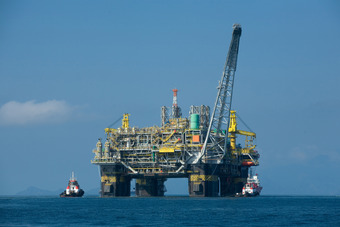
Oil Rig
Oil is a natural resource that is traded in markets. When firms have positive net marginal productivity from using more oil, demand for oil will rise.
Some resources, though, are public goods and therefore are not regulated by normal market forces. Take, for example, a body of water that multiple firms all use. If each firm has a positive marginal productivity of using more water in their manufacturing process, they will use more water since it’s free (there is no, or limited, marginal cost). If each firm individually chooses to use more water, the lake will eventually be damaged. This is known as the tragedy of the commons.
Governments have an incentive to attempt to correct such market failures. There are often regulations on the use of public goods to prevent the tragedy of the common, and there may be regulations on private goods as well (e.g. companies are required to get permits to mine on land they own).
14.4.4: Marginal Productivity and Income Distribution
Demand for the type of workers that can provide positive marginal productivity over marginal cost will see an increase in their wages.
Learning Objective
Explain how the marginal productivity of different factors can affect income distribution
Key Points
- Firms hire workers when they have higher marginal productivity than marginal cost.
- Workers are often categorized as either skilled or unskilled workers. Firms only hire the type of workers they need.
- If, on aggregate, there is a higher demand for skilled workers than unskilled workers, skilled workers will gain proportionally more income as their wages rise.
Key Term
- marginal productivity
-
The extra output that can be produced by using one more unit of the input
Firms will hire workers if the marginal productivity of the worker is greater than the marginal cost. That is, firms will hire someone if the employee can produce more value for the firm than s/he costs in wages or salary.
Not all labor, however, is equal in the firm’s eyes. The two broad categorizations of laborers is skilled (e.g. doctor) and unskilled (e.g. an assembly line worker). Firms will hire the type of workers that they need .

Scientists are Skilled Workers
Scientists are skilled workers. Firms, such as pharmacutical companies, will hire more scientists if the marginal productivity is greater than the marginal cost. This will drive up demand for scientists, and therefore their wages.
Suppose there are many firms with positive net marginal productivity of skilled labor. They will each seek to hire more skilled workers, driving up demand for skilled workers. This will increase the wages of skilled workers, but not of unskilled workers. Skilled workers will be gain proportionally more wealth than unskilled workers. Taken in aggregate, the marginal productivity of one type of worker influences the income that they earn in comparison to other types of workers.
On a national scale, this can have massive implications. If a country has a number of workers with high marginal productivity proportional to marginal cost, firms will want to hire those workers. Those workers will see gains to their income, affecting overall income distribution.
It is important to remember, however, that countries will specialize in goods in which they have a comparative advantage. If a country has an absolutely advantage in both skilled and unskilled workers, but a comparative advantage in unskilled workers, the country will specialize in the good that is intensive in the use of unskilled labor. The increased returns will go to unskilled workers (they will see their wages increase), even though the country also has an absolute advantage in skilled labor.
14.4.5: Capital Market
A capital market is a financial exchange for the buying and selling of long-term debt and equity-backed securities.
Learning Objective
Define the capital market
Key Points
- In primary markets, new stock or bond issues are sold to investors, often via a mechanism known as underwriting. In the secondary markets, existing securities are sold and bought among investors or traders.
- The money markets are used for the raising of short term finance, sometimes for loans that are expected to be paid back as early as overnight. Capital markets are used for the raising of long term finance.
- Regular bank lending is not usually classed as a capital market transaction, even when loans are extended for a period longer than a year.
Key Term
- capital market
-
The market for long-term securities, including the stock market and the bond market.
A capital market is a financial exchange for the buying and selling of long-term debt and equity-backed securities ( ). The purpose of these markets is to channel the funds of savers to entities that would put that capital to long-term productive use (i.e. borrowers).
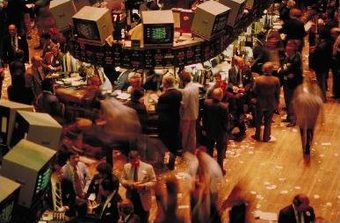
NYSE
This is the floor of the New York Stock Exchange. The NYSE is one of the largest capital markets in the world.
Primary vs. Secondary Markets
A key division within the capital markets is between the primary markets and secondary markets. In primary markets, new stock or bond issues are sold to investors. The main entities seeking to raise long-term funds on the primary capital markets are governments (which may be municipal, local or national) and business enterprises (companies). Governments tend to issue only bonds, whereas companies often issue either equity or bonds. The main entities purchasing the bonds or stocks include pension funds, hedge funds, sovereign wealth funds, and, less commonly, individuals and investment banks trading on their own behalf.
In the secondary markets, existing securities are sold and bought among investors or traders, usually on an exchange, over-the-counter, or elsewhere. The existence of secondary markets increases the willingness of investors in primary markets, as they know they are likely to be able to swiftly cash out their investments if the need arises.
Money Market vs. Capital Market
Money markets and capital markets are closely related, but are different types of financial markets. The money markets are used for the raising of short term finance, sometimes for loans that are expected to be paid back as early as overnight. Funds borrowed from the money markets are typically used for general operating expenses, to cover brief periods of illiquidity.
Capital markets are used for the raising of long term finance, such as the purchase of shares, or for loans that are not expected to be fully paid back for at least a year. When a company borrows from the primary capital markets, often the purpose is to invest in additional physical capital goods, which will be used to help increase its income. It can take many months or years before the investment generates sufficient return to pay back its cost, and hence the finance is long term.
Regular Bank Lending is Not a Capital Market Transaction
Regular bank lending is not usually classed as a capital market transaction, even when loans are extended for a period longer than a year. A key difference is that with a regular bank loan, the lending doesn’t take the form of resalable security like a share or bond that can be traded on the markets. A second difference is that lending from banks and similar institutions is more heavily regulated than capital market lending. A third difference is that bank depositors and shareholders tend to be more risk averse than capital market investors.
14.4.6: Natural Resource Market
Commodity markets are exchanges that trade in primary rather than manufactured products.
Learning Objective
Define the natural resource market
Key Points
- There are two types of commodities. Hard commodities are mined and soft commodities are agricultural products.
- There are approximately 50 commodity markets worldwide. In general, these markets deal in purely financial transactions instead of outright purchases of goods. These financial transactions are known as financial derivatives.
- In the United States, the principal regulator of commodity and futures markets is the Commodity Futures Trading Commission (CFTC). The National Futures Association (NFA) formed in 1976 and is the futures industry’s self-regulatory organization.
Key Term
- commodity
-
Raw materials, agricultural and other primary products as objects of large-scale trading in specialized exchanges.
Natural resources are a fundamental part of the production process, as these goods make up the basis of any manufactured product. Most natural resources that are used can be acquired through the open market or through private deals. Below are some methods of acquiring different natural resources for production.
Public Goods
Some natural resources that are components of the production process are not sold, but are public goods. Public goods, like air and riverways, are non-excludable and non-rivalrous. This means that anyone can use these goods without paying a fee, and if one person uses the good it does not limit the ability of another to use the good.
As time has progressed, people have learned that some means of use of public goods in production processes can degrade certain natural resources. For example, pollution is a result of production processes that can foul the public goods of air and waterways. To combat this, governments have begun to impose ecotaxes on producers that use processes that pollute or otherwise dilute public goods. While not a market, these taxes are essentially a fee charged to producers for using public natural resources and can make the production process more expensive.
Commodity Markets
Commodity markets are exchanges that trade in primary rather than manufactured products . Not all commodities are natural resources, and not all natural resources are commodities, but commodity markets remain an important source for many resources. There are two types of commodities:

Chicago Mercantile Exchange
The Chicago Mercantile Exchange, shown above, is one of the world’s largest commodity markets.
- Soft commodities are agricultural products such as wheat, coffee, cocoa and sugar;
- Hard commodities are mined, such as gold, rubber and oil.
Commodity markets are heavily regulated. In the United States, the principal regulator of commodity and futures markets is the Commodity Futures Trading Commission (CFTC). The National Futures Association (NFA) formed in 1976 and is the futures industry’s self-regulatory organization. The NFA’s first regulatory operations began in 1982 and fall under the Commodity Exchange Act of the Commodity Futures Trading Commission Act.
In Europe, commodity markets are regulated by the European Securities and Markets Authority (Esma), based in Paris and formed in 2011. Esma sets position limits on commodity derivatives.
Closed Purchases
Not all natural resources can be acquired on commodity markets. Some must be acquired through direct purchases without the use of an intermediary clearing house. One example is for land. Land is one of the three factors of production, can be used to mine other natural resources and is absolutely necessary if a person wants to have a “brick and mortar” location where they can sell their goods. Land cannot be acquired through a commodity market, but must be obtained through an agreement with someone who owns the land. A person can either purchase the land outright or become a tenant of the person who owns the property.
The challenge of this process is that for these closed deals, the producer has to find the resource that they need, determine who owns it, and then negotiate with that person to obtain the resource. These costs can make these natural resources more expensive.
14.5: Capital, Productivity, and Technology
14.5.1: Capital and Technology
Firms add capital to the point where the value of marginal product of capital is equal to the rental rate of capital.
Learning Objective
Analyze how firms determine the amount of capital to use in production.
Key Points
- Capital is the infrastructure and equipment used to produce goods and services.
- The production function describes the relationship between the quantity of inputs used in production and the quantity of output. It can be used to derive the marginal product for capital.
- The value of marginal product (VMP) of capital is the marginal product of capital multiplied by its price. The firm’s demand curve for capital is derived from the VMP of capital.
Key Terms
- Production function
-
Relates physical output of a production process to physical inputs or factors of production.
- Value of marginal product of capital
-
The marginal product of capital multiplied by its price.
Capital is a factor of production, along with labor and land. It consists of the infrastructure and equipment used to produce goods and services. Capital can include factory buildings, vehicles, plant machinery, and tools used in the production process. Firms may buy, rent, or lease infrastructure and tools in the capital market, but even if the firm owns these factors of production, the opportunity cost of using this capital is the foregone rent that the firm could receive if it rented the capital to somebody else rather than using it for production. Because of this, we say that the price of capital is the rental rate.
A firm decides how much of each factor input to use and how much output to produce based on the market prices for outputs and inputs, as well as exogenous technological determinants represented by the production function. The production function describes the relationship between the quantity of inputs used in production and the quantity of output. It can be used to derive the marginal product for capital, which is the increase in the amount of output from an additional unit of capital. The value of marginal product (VMP) of capital is the marginal product of capital multiplied by price. The downward-sloping demand curve for capital, which is equal to the VMP of capital, reflects the fact that the production process exhibits diminishing marginal product. A firm will continue to add capital up to the point where the rental rate is equal to the value of marginal product of capital , which is the point of equilibrium.
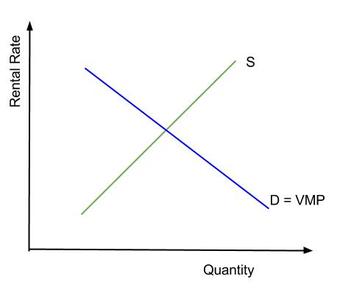
Firm Demand for Capital
Firms will increase the quantity of capital hired to the point where the value of marginal product of capital is equal to the rental rate of capital.
14.5.2: Total Factor Productivity
Total factor productivity, which captures how efficiently inputs are utilized, is a key indicator of competitiveness.
Learning Objective
Discuss the importance of Total Factor Productivity in comparing firms, industries, and countries.
Key Points
- Total factor productivity measures the residual growth in total output of a firm, industry, or national economy that cannot be explained by the accumulation of traditional inputs such as labor and capital.
- Total factor productivity cannot be measured directly. Instead, it is a residual which accounts for effects on total output not caused by inputs.
- Total factor productivity is considered one of the key indicators of competitiveness. It is also accepted by economics as the main contributing factor to economic growth.
Key Term
- Total factor productivity
-
A variable which accounts for effects in total output not caused by traditionally measured inputs of labor and capital.
Total factor productivity measures the residual growth in total output of a firm, industry, or national economy that cannot be explained by the accumulation of traditional inputs such as labor and capital . Increases in total factor productivity reflect a more efficient use of inputs, and total factor productivity is often taken as a measure of long-term technological change or dynamism brought about by such factors as technical innovation.
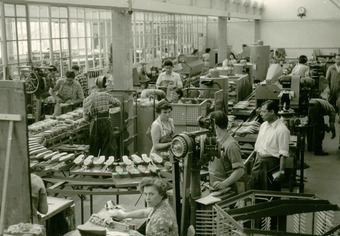
Total Factor Productivity
Total output is not only a function of labor and capital, but also of total factor productivity, a measure of efficiency.
Total factor productivity cannot be measured directly. Instead, it is a residual which accounts for effects on total output not caused by inputs. In the Cobb-Douglas production function, total factor productivity is captured by the variable A:
In the equation above, Y represents total output, K represents capital input, L represents labor input, and alpha and beta are the two inputs’ respective shares of output. An increase in K or L will lead to an increase in output. However, due to to the law of diminishing returns, the increased use of inputs will fail to yield increased output in the long run. The quantity of inputs used thus does not completely determine the amount of output produced. How effectively the factors of production are used is also important. Total factor productivity is less tangible than capital and labor inputs, and it can account for a range of factors, from technology, to human capital, to organizational innovation.
Total factor productivity can be used to measure competitiveness. The higher a country’s total factor productivity, the more competitive it is likely to be (subject to constraints such as resources). It is also generally viewed as one of the main vehicles for driving economic growth.
When a country is able to increase its total factor productivity, it can yield higher output with the same resources, and therefore drive economic growth.
14.5.3: Changes in Technology Over Time
Technological improvement improves the efficiency of production, which increases supply and lowers prices.
Learning Objective
Summarize how changes in technology affect a firm’s decision to produce.
Key Points
- The technology available in a particular industry or economy allows firms to use labor and capital more or less efficiently.
- A change in technology alters the combination of inputs required in the production process. An improvement in technology usually means that fewer and/or less costly inputs are needed.
- If the cost of production is lower, the profits available at a given price will increase, and producers will produce more.
- While we usually think of technology as enhancing production, declines in production due to problems in technology are also possible.
Key Terms
- input
-
Something fed into a process with the intention of it shaping or affecting the outputs of that process.
- assembly line
-
A system of workers and machinery in which a product is assembled in a series of consecutive operations; typically the product is attached to a continuously moving belt
Factors of production typically include land, labor, capital, and natural resources. These inputs are used directly to produce a good or service. Technology, on the other hand, is used to put these factors of production to work. A firm doesn’t purchase additional units of technology to feed into the production process in the same way that a firm might hire more labor in order to increase output. Instead, the technology available in a particular industry or economy allows firms to use labor and capital more or less efficiently. It is important to note that advances in technology are a result of innovation, innovative practices such as process changes are also worth mentioning in this context. Innovation is the driving economic force behind these leaps in efficiency.
Technological change is a term used to describe any change in the set of feasible production possibilities. A change in technology alters the combinations of inputs or the types of inputs required in the production process. An improvement in technology usually means that fewer and/or less costly inputs are needed. If the cost of production is lower, the profits available at a given price will increase, and producers will produce more. With more produced at every price, the supply curve will shift to the right, meaning an increase in supply and a decrease in prices. For the economy as a whole, an improvement in technology shifts the production possibilities frontier outward .

Production Possibility Frontier (PPF)
An increase in technology that allows for greater output based upon the same inputs can be described as an outward shift of the PPF, as demonstrated in this figure.
The invention and popularization of the assembly line is an example of process change, which is worth mentioning in context with technological change. Innovative practices to how we do this is an example of the way in which output can be increased with the same input, and is often discussed in conjunction with technological innovation. During the industrial revolution, many products that had previously been created by hand by a single person or a team of craftsmen began to be manufactured instead in factories in which each worker performed one simple operation. This meant that companies could produce much more output using the same amount of raw materials, capital, and labor. Supply of these goods increased, and the production possibilities curve for the entire economy shifted outwards.
Technological change in the computer industry has resulting in a shift of the computer supply curve. Due to advances in technology, computers can now be manufactured more cheaply, even though they continue to grow smaller, faster, and more powerful. Producers respond to the cheaper production process by increasing output, shifting the supply curve outwards. Thus, the number of computers produced increases and the price of computers falls.
Chapter 13: Oligopoly
13.1: Prerequisites of Oligopoly
13.1.1: Few Sellers
An oligopoly – a market dominated by a few sellers – is often able to maintain market power through increasing returns to scale.
Learning Objective
Explain how increasing returns to scale will cause a higher prevalence of oligopolies
Key Points
- The existence of oligopoly requires that a few firms are able to gain significant market power, preventing other, smaller competitors from entering the market.
- Increasing returns to scale is a term that describes an industry in which the rate of increase in output is higher than the rate of increase in inputs. In other words, doubling the number of inputs will more than double the amount of output.
- Monopolies and oligopolies often form when an industry has increasing returns to scale at relatively high output levels.
Key Terms
- oligopoly
-
An economic condition in which a small number of sellers exert control over the market of a commodity.
- returns to scale
-
A term referring to changes in output resulting from a proportional change in all inputs (where all inputs increase by a constant factor).
Oligopoly Structure
In an oligopoly market structure, a few large firms dominate the market, and each firm recognizes that every time it takes an action it will provoke a response among the other firms. These actions, in turn, will affect the original firm. Each firm, therefore, recognizes that it is interdependent with the other firms in the industry. This interdependence is unique to the oligopoly market structure; in perfect and monopolistic competition, we assume that each firm is small enough that the rest of the market will ignore its actions.
Increasing Returns to Scale
The existence of oligopoly requires that a few firms are able to gain significant market power, preventing other, smaller competitors from entering the market. One source of this power is increasing returns to scale. Increasing returns to scale is a term that describes an industry in which the rate of increase in output is higher than the rate of increase in inputs. In other words, doubling the number of inputs will more than double the amount of output. Increasing returns to scale implies that larger firms will face lower average costs than smaller firms because they are able to take advantage of added efficiency at higher levels of production.
Types of Returns to Scale
Most industries exhibit different types of returns to scale in different ranges of output. Typically in competitive markets, there could be increasing returns at relatively low output levels, decreasing returns at relatively high output levels, and constant returns at one output level between those ranges. Monopolies and oligopolies, however, often form when an industry has increasing returns to scale at relatively high output levels. When a few large firms already exist in this type of market, any new competitor will be smaller and therefore have higher average costs of production. This will make it difficult to compete with the already-established firms. Therefore, the oligopoly firms have a built-in defense against new competition.
Take the example of the cell phone industry in the United States. As of the fourth quarter of 2008, Verizon, AT&T, Sprint, and T-Mobile together controlled 89% of the U.S. cell phone market. The cell phone industry has increasing returns to scale: the cost of providing cellular access to 100,000 people is more than half the cost of providing cellular access to 200,000 people. Any new entrant into the cell phone market will either need to pay one of the larger companies for access to its already-existing network, or try to build a network from scratch. Both options result in higher costs, higher prices, and difficulty in competing with the major networks .

Cell Phone Tower
Cell phone companies have increasing returns to scale, which leads to a market dominated by only a few firms.
13.1.2: Product Differentiation
Oligopolies can form when product differentiation causes decreased competition within an industry.
Learning Objective
Explain the relationship between product differentiation and the existence of an oligopoly
Key Points
- Product differentiation is the process of distinguishing a product or service from others, to make it more attractive to a particular target market.
- The objective of differentiation is to develop a position that potential customers see as unique. This primarily affects performance through reducing competition.
- Many oligopolies make differentiated products: cigarettes, automobiles, computers, ready-to-eat breakfast cereal, and soft drinks.
- Although product differentiation is not required for an oligopoly to form, if a firm can successfully differentiate its products it will gain market power and resist competition more easily.
Key Term
- product differentiation
-
Perceived differences between the product of one firm and that of its rivals so that some customers value it more.
Product differentiation (or simply differentiation) is the process of distinguishing a product or service from others, to make it more attractive to a particular target market. This involves differentiating it from competitors’ products as well as a firm’s own products. In economics, successful product differentiation is inconsistent with the conditions for perfect competition, which include the requirement that the products of competing firms should be perfect substitutes.
Differentiation is due to buyers perceiving a difference; hence, causes of differentiation may be functional aspects of the product or service, how it is distributed and marketed, or who buys it. The major sources of product differentiation are as follows:
- Differences in quality which are usually accompanied by differences in price
- Differences in functional features or design
- Ignorance on the part of buyers regarding the essential characteristics and qualities of goods they are purchasing
- Sales promotion activities of sellers and, in particular, advertising
- Differences in availability (e.g. timing and location).
The objective of differentiation is to develop a position that potential customers see as unique. This primarily affects performance through reducing competition: As the product becomes more differentiated, categorization becomes more difficult and hence draws fewer comparisons with its competition. A successful product differentiation strategy will move a product from competing based primarily on price to competing on non-price factors (such as product characteristics, distribution strategy, or promotional variables).
Product Differentiation and Oligopolies
While some oligopoly industries make standardized products – tools, copper, and steep pipes, for example – others make differentiated products: cars, cigarettes, soda, and cell phone manufacturers. Product differentiation is not necessary for the existence of an oligopoly, but if a firm can successfully engage in product differentiation it can more easily gain market power and dominate at least part of the industry.
For example, the soft drink industry in the US is an oligopoly dominated by the Coca-Cola Company, the Dr. Pepper Snapple Group, and PepsiCo. These companies are able to differentiate their products (e.g. by taste), and are therefore able to gain market power .

Advertising for Product Differentiation
Some companies are able to use marketing to achieve product differentiation, encouraging the formation of oligopolies.
13.1.3: Entry Barriers
One important source of oligopoly power are barriers to entry: obstacles that make it difficult to enter a given market.
Learning Objective
Explain the necessity of entry barriers for the existence of an oligopoly
Key Points
- Because barriers to entry protect incumbent firms and restrict competition in a market, they can contribute to distortionary prices.
- The most important barriers are economies of scale, patents, access to expensive and complex technology, and strategic actions by incumbent firms designed to discourage or destroy new entrants.
- In industrialized economies, barriers to entry have resulted in oligopolies forming in many sectors, with unprecedented levels of competition fueled by increasing globalization.
Key Terms
- incumbent
-
A firm that is an established player in the market.
- research and development
-
The process of discovering and creating new knowledge about scientific and technological topics in order to develop new products
- patent
-
A declaration issued by a government agency declaring someone the inventor of a new invention and having the privilege of stopping others from making, using, or selling the claimed invention.
One important source of oligopoly power is barriers to entry. Barriers to entry are obstacles that make it difficult to enter a given market. The term can refer to hindrances a firm faces in trying to enter a market or industry—such as government regulation and patents, or a large, established firm taking advantage of economies of scale—or those an individual faces in trying to gain entrance to a profession—such as education or licensing requirements. Because barriers to entry protect incumbent firms and restrict competition in a market, they can contribute to distortionary prices.
The most important barriers are economies of scale, patents, access to expensive and complex technology, and strategic actions by incumbent firms designed to discourage or destroy new entrants. For example, microprocessing companies face high research and development costs before possibly making a profit. This means that new firms cannot enter the market whenever existing firms are making a positive economic profit, as is the case in perfect competition. Pharmaceutical manufacturers are one type of company that generally rely on patents, which makes competition irrelevant for a period of time after development: competitors can’t legally begin manufacturing the product until the patent expires.
Additional sources of barriers to entry often result from government regulation favoring existing firms. For example, requirements for licenses and permits may raise the investment needed to enter a market, creating an effective barrier to entry.
In industrialized economies, barriers to entry have resulted in oligopolies forming in many sectors, with unprecedented levels of competition fueled by increasing globalization. For example, there are now only a small number of manufacturers of civil passenger aircraft. Oligopolies have also formed in heavily-regulated markets such as wireless communications: in some areas only two or three providers are licensed to operate .

Oligopoly in Aircraft Manufacturing
Manufacturing commercial airplanes takes a very large initial investment in technology, equipment, and licensing. Consequently, the industry is dominated by two firms.
13.1.4: Price Leadership
Price leadership is a form of tacit collusion that oligopolies may use to achieve a monopoly-like market outcome.
Learning Objective
Define price leadership within the context of an oligopoly
Key Points
- Oligopolies are defined by one firm’s interdependence on other firms within the industry. When one firm changes its price or level of output, other firms are directly affected.
- When firms collude, they use restrictive trade practices to voluntarily lower output and raise prices in much the same way as a monopoly, splitting the higher profits that result.
- An alternative to overt collusion is tacit collusion, an unwritten, unspoken understanding through which firms agree to limit their competition.
- One strategy is to follow the price leadership of a particular firm, raising or lowering prices when the leader makes such a change. The price leader may be the largest firm in the industry, or it may be a firm that has been particularly good at assessing changes in demand or cost.
Key Terms
- Price leadership
-
The action taken by a leader in an oligopolistic industry to determine prices for the entire industry.
- collude
-
To act in concert with; to conspire.
- Cartel
-
A group of businesses or nations that collude explicitly to limit competition within an industry or market.
Oligopoly
Oligopolies are defined by one firm’s interdependence on other firms within the industry. When one firm changes its price or level of output, other firms are directly affected. Unlike perfect competition and monopoly, uncertainty about how rival firms interact makes the specification of a single model of oligopoly impossible. Economists often simplify firm behavior into two strategies: firm can compete, in which case the market outcome will resemble that in perfect competition; or they can collude, in which case the market outcome will more closely resemble monopoly. When firms collude, they use restrictive trade practices to voluntarily lower output and raise prices in much the same way as a monopoly, splitting the higher profits that result.
Price Leadership
Firms can collude explicitly, as in the case of cartels, but this type of behavior is illegal in many parts of the world. An alternative to overt collusion is tacit collusion, in which firms have an unspoken understanding that limits their competition. One way in which firms achieve this is price leadership, in which one firm serves as an industry leader and sets prices, while other firms raise and lower their prices to match. For example, the steel, cars, and breakfast cereals industries have all been accused of engaging in tacit collusion..
Tacit collusion can be difficult to identify. The fact that a price change by one firm is follwed by similar price changes among other firms doesn’t necessarily mean that tacit collusion exists. After all, in a perfectly competitive industry, economists expect prices to move together because all firms face similar changes in demand and the cost of inputs.
For example, imagine that a town has three gas stations. Without any way to communicate, all three will lower their prices in an attempt to capture the entire market, stopping only when marginal cost equals marginal revenue. If the firms could cooperate, however, they would be better off if all set the price of gas at $0.20 above marginal cost. Each would have slightly lower sales but would have much higher revenue. Although explicit communication about prices is illegal, the firms might tacitly agree that whenever one station raises its prices, the other two will follow suit. In this way, all three can receive the benefits of oligopoly . The gas station that first raises its prices, and that the other two follow, is called the price leader.
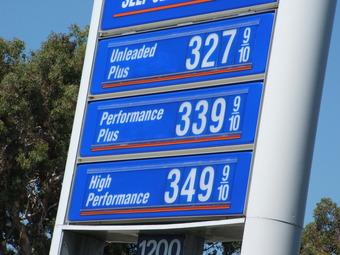
Price Leadership and Gas Prices
Although companies cannot legally communicate to set prices, some accuse certain industries of using price leadership to accomplish the same goal.
13.2: Oligopoly in Practice
13.2.1: Collusion and Competition
Firms in an oligopoly can increase their profits through collusion, but collusive arrangements are inherently unstable.
Learning Objective
Assess the considerations involved in the oligopolist’s decision about whether to compete or cooperate
Key Points
- Firms in an oligopoly may collude to set a price or output level for a market in order to maximize industry profits. At an extreme, the colluding firms can act as a monopoly.
- Oligopolists pursuing their individual self-interest would produce a greater quantity than a monopolist, and charge a lower price.
- Collusive arrangements are generally illegal. Moreover, it is difficult for firms to coordinate actions, and there is a threat that firms may defect and undermine the others in the arrangement.
- Price leadership, which occurs when a dominant competitor sets the industry price and others follow suit, is an informal type of collusion which is generally legal.
Key Terms
- Price leadership
-
Occurs when one company, usually the dominant competitor among several, leads the way in determining prices, the others soon following.
- collusion
-
A secret agreement for an illegal purpose; conspiracy.
- price fixing
-
An agreement between sellers to sell a product only at a fixed price, or maintain the market conditions such that the price is maintained at a given level by controlling supply.
Oligopoly is a market structure in which there are a few firms producing a product. When there are few firms in the market, they may collude to set a price or output level for the market in order to maximize industry profits . As a result, price will be higher than the market-clearing price, and output is likely to be lower. At the extreme, the colluding firms may act as a monopoly, reducing their individual output so that their collective output would equal that of a monopolist, allowing them to earn higher profits.

OPEC
The oil-producing countries of OPEC have at times cooperated to raise world oil prices in order to secure a steady income for themselves.
If oligopolists individually pursued their own self-interest, then they would produce a total quantity greater than the monopoly quantity, and charge a lower price than the monopoly price, thus earning a smaller profit. The promise of bigger profits gives oligopolists an incentive to cooperate. However, collusive oligopoly is inherently unstable, because the most efficient firms will be tempted to break ranks by cutting prices in order to increase market share.
Several factors deter collusion. First, price-fixing is illegal in the United States, and antitrust laws exist to prevent collusion between firms. Second, coordination among firms is difficult, and becomes more so the greater the number of firms involved. Third, there is a threat of defection. A firm may agree to collude and then break the agreement, undercutting the profits of the firms still holding to the agreement. Finally, a firm may be discouraged from collusion if it does not perceive itself to be able to effectively punish firms that may break the agreement.
In contrast to price-fixing, price leadership is a type of informal collusion which is generally legal. Price leadership, which is also sometimes called parallel pricing, occurs when the dominant competitor publishes its price ahead of other firms in the market, and the other firms then match the announced price. The leader will typically set the price to maximize its profits, which may not be the price that maximized other firms’ profits.
13.2.2: Game Theory Applications to Oligopoly
Game theory provides a framework for understanding how firms behave in an oligopoly.
Learning Objective
Explain how game theory applies to oligopolies
Key Points
- In an oligopoly, firms are affected not only by their own production decisions, but by the production decisions of other firms in the market as well. Game theory models situations in which each actor, when deciding on a course of action, must also consider how others might respond to that action.
- The prisoner’s dilemma is a type of game that illustrates why cooperation is difficult to maintain for oligopolists even when it is mutually beneficial. In this game, the dominant strategy of each actor is to defect. However, acting in self-interest leads to a sub-optimal collective outcome.
- The Nash equilibrium is an important concept in game theory. It is the set of strategies such that no player can do better by unilaterally changing his or her strategy.
- Game theory is generally not needed to understand competitive or monopolized markets.
Key Terms
- Prisoner’s dilemma
-
A game that shows why two individuals might not cooperate, even if it appears that it is in their best interests to do so.
- game theory
-
A branch of applied mathematics that studies strategic situations in which individuals or organisations choose various actions in an attempt to maximize their returns.
- Nash equilibrium
-
The set of players’ strategies for which no player can benefit by changing his or her strategy, assuming that the other players keep theirs unchanged.
In an oligopoly, firms are interdependent; they are affected not only by their own decisions regarding how much to produce, but by the decisions of other firms in the market as well. Game theory offers a useful framework for thinking about how firms may act in the context of this interdependence. More specifically, game theory can be used to model situations in which each actor, when deciding on a course of action, must also consider how others might respond to that action.
For example, game theory can explain why oligopolies have trouble maintaining collusive arrangements to generate monopoly profits. While firms would be better off collectively if they cooperate, each individual firm has a strong incentive to cheat and undercut their competitors in order to increase market share. Because the incentive to defect is strong, firms may not even enter into a collusive agreement if they don’t perceive there to be a way to effectively punish defectors.
The prisoner’s dilemma is a specific type of game in game theory that illustrates why cooperation may be difficult to maintain for oligopolists even when it is mutually beneficial. In the game, two members of a criminal gang are arrested and imprisoned. The prisoners are separated and left to contemplate their options . If both prisoners confess, each will serve a two-year prison term. If one confesses, but the other denies the crime, the one that confessed will walk free, while the one that denied the crime would get a three-year sentence. If both deny the crime, they will both serve only a one year sentence. Betraying the partner by confessing is the dominant strategy; it is the better strategy for each player regardless of how the other plays. This is known as a Nash equilibrium. The result of the game is that both prisoners pursue individual logic and betray, when they would have collectively gotten a better outcome if they had both cooperated.
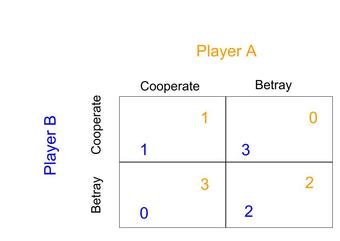
Prisoner’s Dilemma
In a prisoner’s dilemma game, the dominant strategy for each player is to betray the other, even though cooperation would have led to a better collective outcome.
The Nash equilibrium is an important concept in game theory. It is the set of strategies such that no player can do better by unilaterally changing his or her strategy. If a player knew the strategies of the other players (and those strategies could not change), and could not benefit by changing his or her strategy, then that set of strategies represents a Nash equilibrium. If any player would benefit by changing his or her strategy, then that set of strategies is not a Nash equilibrium.
While game theory is important to understanding firm behavior in oligopolies, it is generally not needed to understand competitive or monopolized markets. In competitive markets, firms have such a small individual effect on the market, that taking other firms into account is simply not necessary. A monopolized market has only one firm, and thus strategic interactions do not occur.
13.2.3: The Prisoner’s Dilemma and Oligopoly
The prisoner’s dilemma shows why two individuals might not cooperate, even if it is collectively in their best interest to do so.
Learning Objective
Analyze the prisoner’s dilemma using the concepts of strategic dominance, Pareto optimality, and Nash equilibria
Key Points
- In the game, two criminals are arrested and imprisoned. Each criminal must decide whether he will cooperate with or betray his partner. The criminals cannot communicate to coordinate their actions.
- Betrayal is the dominant strategy for both players in the game. Betrayal leads to best individual outcome regardless of what the other person does.
- Both players choosing betrayal is the Nash equilibrium of the game. However, this outcome is not Pareto-optimal. Both players would have clearly been better off if they had cooperated.
- Cooperation by firms in oligopolies is difficult to achieve because defection is in the best interest of each individual firm.
Key Terms
- Pareto optimal
-
Describing a situation in which the profit of one party cannot be increased without reducing the profit of another.
- Nash equilibrium
-
The set of players’ strategies for which no player can benefit by changing his or her strategy, assuming that the other players keep theirs unchanged.
- Strategic dominance
-
Occurs when one strategy is better than another strategy for one player, no matter how that player’s opponents may play.
Sometimes firms fail to cooperate with each other, even when cooperation would bring about a better collective outcome. The prisoner’s dilemma is a canonical example of a game analyzed in game theory that shows why two individuals might not cooperate, even if it appears that it is in their best interest to do so.
In the game, two members of a criminal gang are arrested and imprisoned. Each prisoner is in solitary confinement with no means of speaking to or exchanging messages with the other. The police offer each prisoner a bargain :
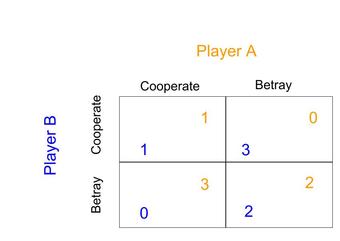
Prisoner’s Dilmma
Betrayal in the dominant strategy for both players, as it provides for a better individual outcome regardless of what the other player does. However, the resulting outcome is not Pareto-optimal. Both players would clearly have been better off if they had cooperated.
- If Prisoner A and Prisoner B both confess to the crime, each of them will serve two years in prison.
- If A confesses but B denies the crime, A will be set free, while B will serve three years in prison (and vice versa).
- If both A and B deny the crime, both of them will only serve one year in prison.
For both players, the choice to betray the partner by confessing has strategic dominance in this situation; it is the better strategy for each player regardless of what the other player does. This set of strategies is thus a Nash equilibrium in the game–no player would be better off by changing his or her strategy. As a result, all purely self-interested prisoners would betray each other, resulting in a two year prison sentence for both. This outcome is not Pareto optimal; it is clearly possible to improve the outcomes for both players through cooperation. If both players had denied the crime, they would each be serving only one year in prison.
Similarly to the prisoner’s dilemma scenario, cooperation is difficult to maintain in an oligopoly because cooperation is not in the best interest of the individual players. However, the collective outcome would be improved if firms cooperated, and were thus able to maintain low production, high prices, and monopoly profits.
One traditional example of game theory and the prisoner’s dilemma in practice involves soft drinks. Coca-Cola and Pepsi compete in an oligopoly, and thus are highly competitive against one another (as they have limited other competitive threats). Considering the similarity of their products in the soft drink industry (i.e. varying types of soda), any price deviation on part of one competitor is seen as an act of non-conformity or betrayal of an established status quo.
In such a scenario, there are a number of plausible reactions and outcomes. If Coca-Cola reduces their prices, Pepsi may follow to ensure they do not lose market share. In this situation, defection results in a lose-lose. Which is to say that, due to the initial price reduction by Coca-Cola (betrayal of status quo), both companies likely see reduced profit margins. On the other hand, Pepsi could uphold the price point despite Coca-Cola’s deviation, sacrificing market share to Coca-Cola but maintaining the established price point. Prisoner dilemma scenarios are difficult strategic choices, as any deviation from established competitive practice may result in less profits and/or market share.
13.2.4: Duopoly Example
The Cournot model, in which firms compete on output, and the Bertrand model, in which firms compete on price, describe duopoly dynamics.
Learning Objective
Discuss the characteristics of a duopoly
Key Points
- The Cournot model focuses on the production output decision of a single firm. A firm determines its competitor’s output level and the residual market demand. It then determines its profit-maximizing output for that residual demand as if it were the entire market, and produces accordingly.
- In the Bertrand model, firms set profit-maximizing prices in response to what they expect the competitor to charge. The model predicts that both firms will lower prices until they reach the marginal cost limit, arriving at an outcome equivalent to what prevails under perfect competition.
- The accuracy of the Cournot or Bertrand model will vary from industry to industry, depending on how easy it is to adjust output levels in the industry.
Key Terms
- Bertrand duopoly
-
A model that describes interactions among firms competing on price.
- Cournot duopoly
-
An economic model describing an industry in which companies compete on the amount of output they will produce, which they decide on independently of each other and at the same time.
A true duopoly is a specific type of oligopoly where only two producers exist in a market. There are two principle duopoly models: Cournot duopoly and Bertrand duopoly.
Cournot Duopoly
Cournot duopoly is an economic model that describes an industry structure in which firms compete on output levels. The model makes the following assumptions:
- There are two firms, which produce a homogeneous product;
- The number of firms is fixed;
- Firms do not cooperate (there is no collusion);
- Firms have market power, and each firm’s output decision affects the good’s price;
- Firms are economically rational and act strategically, seeking to maximize profit given their competitor’s decisions; and
- Firms compete on quantity, and choose quantity simultaneously.
The Cournot model focuses on the production output decision of a single firm. The firm determines its rival’s output level, evaluates the residual market demand, and then changes its own output level to maximize profits. It is assumed that the firm’s output decision will not affect the output decision of its competitor.
For example, suppose that there are two firms in the market for toasters with a given demand function. Firm A will determine the output of Firm B, hold it constant, and then determine the remainder of the market demand for toasters. Firm A will then determine its profit-maximizing output for that residual demand as if it were the entire market, and produce accordingly. Firm B will be conducting similar calculations with respect to Firm A at the same time.
Bertrand Duopoly
The Bertrand model describes interactions among firms that compete on price. Firms set profit-maximizing prices in response to what they expect a competitor to charge. The model rests on the following assumptions:
- There are two firms producing homogeneous products;
- Firms do not cooperate;
- Firms compete by setting prices simultaneously; and
- Consumers buy everything from a firm with a lower price. If all firms charge the same price, consumers randomly select among them.
In the Bertrand model, Firm A’s optimum price depends on where it believes Firm B will set its price . Pricing just below the other firm will obtain full market demand, though this choice is not optimal if the other firm is pricing below marginal cost, as this would result in negative profits. If Firm B is setting the price below marginal cost, Firm A will set the price at marginal cost. If Firm B is setting the price above marginal cost but below monopoly price, then Firm A will set the price just below that of Firm B. If Firm B sets the price above monopoly price, Firm A will set the price at monopoly level.
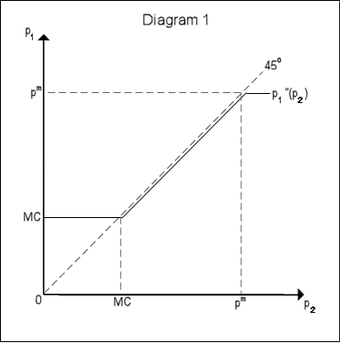
Bertrand Duopoly
The diagram shows the reaction function of a firm competing on price. When P2 (the price set by Firm 2) is less than marginal cost, Firm 1 prices at marginal cost (P1=MC). When Firm 2 prices above MC but below monopoly prices, Firm 1 prices just below Firm 2. When Firm 2 prices above monopoly price (PM), Firm 1 prices at monopoly level (P1=PM).
Imagine if both firms set equal prices above marginal cost. Each firm would get half the market at a higher than marginal cost price. However, by lowering prices just slightly, a firm could gain the whole market. As a result, both firms are tempted to lower prices as much as they can. However, it would be irrational to price below marginal cost, because the firm would make a loss. Therefore, both firms will lower prices until they reach the marginal cost limit. According to this model, a duopoly will result in an outcome exactly equivalent to what prevails under perfect competition. The result of the firms’ strategies is a Nash equilibrium–a pair or strategies where neither firm can increase profits by unilaterally changing the price.
Colluding to charge the monopoly price and supplying one half of the market each is the best that the firms could do in this scenario. However, not colluding and charging the marginal cost, which is the non-cooperative outcome, is the only Nash equilibrium of this model.
The accuracy of the Cournot or Bertrand model will vary from industry to industry. If capacity and output can be easily changed, Bertrand is generally a better model of duopoly competition. If output and capacity are difficult to adjust, then Cournot is generally a better model.
13.2.5: Cartel Example
A cartel is a formal collusive arrangement among firms with the goal of increasing profits.
Learning Objective
Assess the role of competition and collusion in the formation of cartels
Key Points
- Cartel members cooperate to set industry price and output.
- Game theory indicates that cartels are inherently unstable. Each individual member has an incentive to cheat in order to make higher profits in the short run.
- Cheating may lead to the collapse of a cartel. With the collapse, firms would revert to competing, which would lead to decreased profits.
- OPEC, the Organization of Petroleum Exporting Countries, provides an example of a historically effective cartel.
Key Term
- Cartel
-
A group of businesses or nations that collude to limit competition within an industry or market.
A cartel is an agreement among competing firms to collude in order to attain higher profits. Cartels usually occur in an oligopolistic industry, where the number of sellers is small and the products being traded are homogeneous. Cartel members may agree on such matters are price fixing, total industry output, market share, allocation of customers, allocation of territories, bid rigging, establishment of common sales agencies, and the division of profits.
Game theory suggests that cartels are inherently unstable, because the behavior of cartel members represents a prisoner’s dilemma. Each member of a cartel would be able to make a higher profit, at least in the short-run, by breaking the agreement (producing a greater quantity or selling at a lower price) than it would make by abiding by it. However, if the cartel collapses because of defections, the firms would revert to competing, profits would drop, and all would be worse off.
Whether members of a cartel choose to cheat on the agreement depends on whether the short-term returns to cheating outweigh the long-term losses from the possible breakdown of the cartel. It also partly depends on how difficult it is for firms to monitor whether the agreement is being adhered to by other firms. If monitoring is difficult, a member is likely to get away with cheating for longer; members would then be more likely to cheat, and the cartel will be more unstable.
Perhaps the most globally recognizable and effective cartel is OPEC, the Organization of Petroleum Exporting Countries . In 1973 members of OPEC reduced their production of oil. Because crude oil from the Middle East was known to have few substitutes, OPEC member’s profits skyrocketed. From 1973 to 1979, the price of oil increased by $70 per barrel, an unprecedented number at the time. In the mid 1980s, however, OPEC started to weaken. Discovery of new oil fields in Alaska and Canada introduced new alternatives to Middle Eastern oil, causing OPEC’s prices and profits to fall. Around the same time OPEC members also started cheating to try to increase individual profits.

OPEC
In the 1970s, OPEC members successfully colluded to reduce the global production of oil, leading to higher profits for member countries.
Chapter 12: Monopolistic Competition
12.1: Monopolistic Competition
12.1.1: Defining Monopolistic Competition
Monopolistic competition is a type of imperfect competition such that many producers sell products that are differentiated from one another.
Learning Objective
Evaluate the characteristics and outcomes of markets with imperfect competition
Key Points
- Monopolistic competition is different from a monopoly. A monopoly exists when a person or entity is the exclusive supplier of a good or service in a market.
- Markets that have monopolistic competition are inefficient for two reasons. First, at its optimum output the firm charges a price that exceeds marginal costs. The second source of inefficiency is the fact that these firms operate with excess capacity.
- Monopolistic competitive markets have highly differentiated products; have many firms providing the good or service; firms can freely enter and exits in the long-run; firms can make decisions independently; there is some degree of market power; and buyers and sellers have imperfect information.
Key Terms
- monopoly
-
A market where one company is the sole supplier.
- Monopolistic competition
-
A type of imperfect competition such that one or two producers sell products that are differentiated from one another as goods but not perfect substitutes (such as from branding, quality, or location).
Monopolistic Competition
Monopolistic competition is a type of imperfect competition such that many producers sell products that are differentiated from one another as goods but not perfect substitutes (such as from branding, quality, or location). In monopolistic competition, a firm takes the prices charged by its rivals as given and ignores the impact of its own prices on the prices of other firms.
Unlike in perfect competition, firms that are monopolistically competitive maintain spare capacity. Models of monopolistic competition are often used to model industries. Textbook examples of industries with market structures similar to monopolistic competition include restaurants, cereal, clothing, shoes, and service industries in large cities .

Clothing
The clothing industry is monopolistically competitive because firms have differentiated products and market power.
Monopolistic competition is different from a monopoly. A monopoly exists when a person or entity is the exclusive supplier of a good or service in a market. The demand is inelastic and the market is inefficient.
Monopolistic competitive markets:
- have products that are highly differentiated, meaning that there is a perception that the goods are different for reasons other than price;
- have many firms providing the good or service;
- firms can freely enter and exits in the long-run;
- firms can make decisions independently;
- there is some degree of market power, meaning producers have some control over price; and
- buyers and sellers have imperfect information.
Sources of Market Inefficiency
Markets that have monopolistic competition are inefficient for two reasons. The first source of inefficiency is due to the fact that at its optimum output, the firm charges a price that exceeds marginal costs. The monopolistic competitive firm maximizes profits where marginal revenue equals marginal cost. A monopolistic competitive firm’s demand curve is downward sloping, which means it will charge a price that exceeds marginal costs. The market power possessed by a monopolistic competitive firm means that at its profit maximizing level of production there will be a net loss of consumer and producer surplus.
The second source of inefficiency is the fact that these firms operate with excess capacity. The firm’s profit maximizing output is less than the output associated with minimum average cost. All firms, regardless of the type of market it operates in, will produce to a point where demand or price equals average cost. In a perfectly competitive market, this occurs where the perfectly elastic demand curve equals minimum average cost. In a monopolistic competitive market, the demand curve is downward sloping. In the long run, this leads to excess capacity.
12.1.2: Product Differentiation
Product differentiation is the process of distinguishing a product or service from others to make it more attractive to a target market.
Learning Objective
Define product differentiation
Key Points
- Differentiation occurs because buyers perceive a difference between products. Causes of differentiation include functional aspects of the product or service, how it is distributed and marketed, and who buys it.
- Differentiation affects performance primarily by reducing direct competition. As the product becomes more different, categorization becomes more difficult, and the product draws fewer comparisons with its competition.
- There are three types of product differentiation: simple, horizontal, and vertical.
Key Term
- product differentiation
-
Perceived differences between the product of one firm and that of its rivals so that some customers value it more.
One of the defining traits of a monopolistically competitive market is that there is a significant amount of non-price competition. This means that product differentiation is key for any monopolistically competitive firm. Product differentiation is the process of distinguishing a product or service from others to make it more attractive to a target market .

Kool-Aid
Kool-Aid is an individual brand that competes with Kraft’s other brand (Tang).
Although research in a niche market may result in changing a product in order to improve differentiation, the changes themselves are not differentiation. Marketing or product differentiation is the process of describing the differences between products or services, or the resulting list of differences; differentiation is not the process of creating the differences between the products. Product differentiation is done in order to demonstrate the unique aspects of a firm’s product and to create a sense of value.
In economics, successful product differentiation is inconsistent with the conditions of perfect competition, which require products of competing firms to be perfect substitutes.
Consumers do not need to know everything about the product for differentiation to work. So long as the consumers perceive that there is a difference in the products, they do not need to know how or why one product might be of higher quality than another. For example, a generic brand of cereal might be exactly the same as a brand name in terms of quality. However, consumers might be willing to pay more for the brand name despite the fact that they cannot identify why the more expensive cereal is of higher “quality. “
There are three types of product differentiation:
- Simple: the products are differentiated based on a variety of characteristics;
- Horizontal: the products are differentiated based on a single characteristic, but consumers are not clear on which product is of higher quality; and
- Vertical: the products are differentiated based on a single characteristic and consumers are clear on which product is of higher quality.
Differentiation occurs because buyers perceive a difference. Drivers of differentiation include functional aspects of the product or service, how it is distributed and marketed, and who buys it. The major sources of product differentiation are as follows:
- Differences in quality, which are usually accompanied by differences in price;
- Differences in functional features or design;
- Ignorance of buyers regarding the essential characteristics and qualities of goods they are purchasing;
- Sales promotion activities of sellers, particularly advertising; and
- Differences in availability (e.g. timing and location).
The objective of differentiation is to develop a position that potential customers see as unique. Differentiation affects performance primarily by reducing direct competition. As the product becomes more different, categorization becomes more difficult, and the product draws fewer comparisons with its competition. A successful product differentiation strategy will move the product from competing on price to competing on non-price factors.
12.1.3: Demand Curve
The demand curve in a monopolistic competitive market slopes downward, which has several important implications for firms in this market.
Learning Objective
Explain how the shape of the demand curve affects the firms that exist in a market with monopolistic competition
Key Points
- The downward slope of a monopolistically competitive demand curve signifies that the firms in this industry have market power.
- Market power allows firms to increase their prices without losing all of their customers.
- The downward slope of the demand curve contributes to the inefficiency of the market, leading to a loss in consumer surplus, deadweight loss, and excess production capacity.
Key Terms
- market power
-
The ability of a firm to profitably raise the market price of a good or service over marginal cost. A firm with total market power can raise prices without losing any customers to competitors.
- elastic
-
Sensitive to changes in price.
The demand curve of a monopolistic competitive market slopes downward. This means that as price decreases, the quantity demanded for that good increases. While this appears to be relatively straightforward, the shape of the demand curve has several important implications for firms in a monopolistic competitive market.

Monopolistic Competition
As you can see from this chart, the demand curve (marked in red) slopes downward, signifying elastic demand.
Market Power
The demand curve for an individual firm is downward sloping in monopolistic competition, in contrast to perfect competition where the firm’s individual demand curve is perfectly elastic. This is due to the fact that firms have market power: they can raise prices without losing all of their customers. In this type of market, these firms have a limited ability to dictate the price of its products; a firm is a price setter not a price taker (at least to some degree). The source of the market power is that there are comparatively fewer competitors than in a competitive market, so businesses focus on product differentiation, or differences unrelated to price. By differentiating its products, firms in a monopolistically competitive market ensure that its products are imperfect substitutes for each other. As a result, a business that works on its branding can increase its prices without risking its consumer base.
Inefficiency in the Market
Monopolistically competitive firms maximize their profit when they produce at a level where its marginal costs equals its marginal revenues. Because the individual firm’s demand curve is downward sloping, reflecting market power, the price these firms will charge will exceed their marginal costs. Due to how products are priced in this market, consumer surplus decreases below the pareto optimal levels you would find in a perfectly competitive market, at least in the short run. As a result, the market will suffer deadweight loss. The suppliers in this market will also have excess production capacity.
12.1.4: Short Run Outcome of Monopolistic Competition
Monopolistic competitive markets can lead to significant profits in the short-run, but are inefficient.
Learning Objective
Examine the concept of the short run and how it applies to firms in a monopolistic competition
Key Points
- The “short run” is the time period when one factor of production is fixed in terms of costs, while the other elements of production are variable.
- Like monopolies, the suppliers in monopolistic competitive markets are price makers and will behave similarly in the short-run.
- Also like a monopoly, a monopolastic competitive firm will maximize its profits when its marginal revenues equals its marginal costs.
Key Term
- short-run
-
The conceptual time period in which at least one factor of production is fixed in amount and others are variable in amount.
In terms of production and supply, the “short run” is the time period when one factor of production is fixed in terms of costs while the other elements of production are variable. The most common example of this is the production of a good that requires a factory. If demand spikes, in the short run you will only be able to produce the amount of good that the capacity of the factory allows. This is because it takes a significant amount of time to either build or acquire a new factory. If demand for the good plummets you can cut production in the factory, but will still have to pay the costs of maintaining the factory and the associated rent or debt associated with acquiring the factory. You could sell the factory, but again that would take a significant amount of time. The “short run” is defined by how long it would take to alter that “fixed” aspect of production.
In the short run, a monopolistically competitive market is inefficient. It does not achieve allocative nor productive efficiency. Also, since a monopolistic competitive firm has powers over the market that are similar to a monopoly, its profit maximizing level of production will result in a net loss of consumer and producer surplus, creating deadweight loss.
Setting a Price and Determining Profit
Like monopolies, the suppliers in monopolistic competitive markets are price makers and will behave similarly in the short-run. Also like a monopoly, a monopolistic competitive firm will maximize its profits by producing goods to the point where its marginal revenues equals its marginal costs. The profit maximizing price of the good will be determined based on where the profit-maximizing quantity amount falls on the average revenue curve. The profit the firm makes is the the amount of the good produced multiplied by the difference between the price minus the average cost of producing the good. .
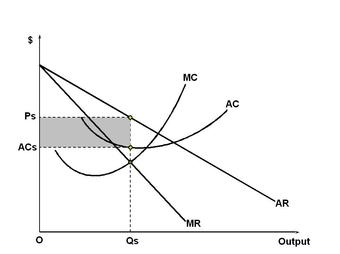
Short Run Equilibrium Under Monopolistic Competition.
As you can see from the chart, the firm will produce the quantity (Qs) where the marginal cost (MC) curve intersects with the marginal revenue (MR) curve. The price is set based on where the Qs falls on the average revenue (AR) curve. The profit the firm makes in the short term is represented by the grey rectangle, or the quantity produced multiplied by the difference between the price and the average cost of producing the good.
Since monopolistically competitive firms have market power, they will produce less and charge more than a firm would under perfect competition. This causes deadweight loss for society, but, from the producer’s point of view, is desirable because it allows them to earn a profit and increase their producer surplus.
Because of the possibility of large profits in the short-run and relatively low barriers of entry in comparison to perfect markets, markets with monopolistic competition are very attractive to future entrants.
12.1.5: Long Run Outcome of Monopolistic Competition
In the long run, firms in monopolistic competitive markets are highly inefficient and can only break even.
Learning Objective
Explain the concept of the long run and how it applies to a firms in monopolistic competition
Key Points
- In terms of production and supply, the “long-run” is the time period when all aspects of production are variable and can therefore be adjusted to meet shifts in demand.
- Like monopolies, the suppliers in monopolistic competitive markets are price makers and will behave similarly in the long-run.
- Like a monopoly, a monopolastic competitive firm will maximize its profits by producing goods to the point where its marginal revenues equals its marginal costs.
- In the long-run, the demand curve of a firm in a monopolistic competitive market will shift so that it is tangent to the firm’s average total cost curve. As a result, this will make it impossible for the firm to make economic profit; it will only be able to break even.
Key Term
- long-run
-
The conceptual time period in which there are no fixed factors of production.
In terms of production and supply, the “long-run” is the time period when there is no factor that is fixed and all aspects of production are variable and can therefore be adjusted to meet shifts in demand. Given a long enough time period, a firm can take the following actions in response to shifts in demand:
- Enter an industry;
- Exit an industry;
- Increase its capacity to produce more; and
- Decrease its capacity to produce less.
In the long-run, a monopolistically competitive market is inefficient. It achieves neither allocative nor productive efficiency. Also, since a monopolistic competitive firm has power over the market that is similar to a monopoly, its profit maximizing level of production will result in a net loss of consumer and producer surplus.
Setting a Price and Determining Profit
Like monopolies, the suppliers in monopolistic competitive markets are price makers and will behave similarly in the long-run. Also like a monopoly, a monopolistic competitive firm will maximize its profits by producing goods to the point where its marginal revenues equals its marginal costs. The profit maximizing price of the good will be determined based on where the profit-maximizing quantity amount falls on the average revenue curve.
While a monopolistic competitive firm can make a profit in the short-run, the effect of its monopoly-like pricing will cause a decrease in demand in the long-run. This increases the need for firms to differentiate their products, leading to an increase in average total cost. The decrease in demand and increase in cost causes the long run average cost curve to become tangent to the demand curve at the good’s profit maximizing price. This means two things. First, that the firms in a monopolistic competitive market will produce a surplus in the long run. Second, the firm will only be able to break even in the long-run; it will not be able to earn an economic profit .
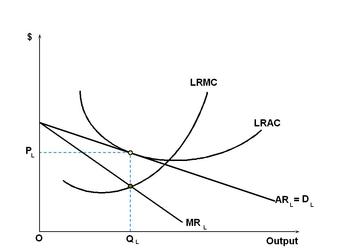
Long Run Equilibrium of Monopolistic Competition
In the long run, a firm in a monopolistic competitive market will product the amount of goods where the long run marginal cost (LRMC) curve intersects marginal revenue (MR). The price will be set where the quantity produced falls on the average revenue (AR) curve. The result is that in the long-term the firm will break even.
12.1.6: Monopolistic Competition Compared to Perfect Competition
The key difference between perfectly competitive markets and monopolistically competitive ones is efficiency.
Learning Objective
Differentiate between monopolistic competition and perfect competition
Key Points
- Perfectly competitive markets have no barriers of entry or exit. Monopolistically competitive markets have a few barriers of entry and exit.
- The two markets are similar in terms of elasticity of demand, a firm’s ability to make profits in the long-run, and how to determine a firm’s profit maximizing quantity condition.
- In a perfectly competitive market, all goods are substitutes. In a monopolistically competitive market, there is a high degree of product differentiation.
Key Term
- perfect competition
-
A type of market with many consumers and producers, all of whom are price takers
Examples
- The classic example of a monopoly is De Beers, who at one point in the 1980s reputably owned 90% of all the diamond supply to major markets. This results in a high degree of price control, as a lack of competitive forces will enable De Beers to essentially set the going price for diamonds (granted the control their distribution).
- A good example of monopolistic competition, on the other hand, would be the Some modern day apps in the app store (this is NOT to say the app stores themselves, which are something of an oligopoly). There are thousands upon thousands of apps, some are free, some are paid, and some have free versions with microtransactions. The key is that demand is highly elastic, and supply is nearly infinite, allowing consumers a great deal of freedom in their purchasing decisions.
Perfect competition and monopolistic competition are two types of economic markets.
Similarities
One of the key similarities that perfectly competitive and monopolistically competitive markets share is elasticity of demand in the long-run. In both circumstances, the consumers are sensitive to price; if price goes up, demand for that product decreases. The two only differ in degree. Firm’s individual demand curves in perfectly competitive markets are perfectly elastic, which means that an incremental increase in price will cause demand for a product to vanish ). Demand curves in monopolistic competition are not perfectly elastic: due to the market power that firms have, they are able to raise prices without losing all of their customers.
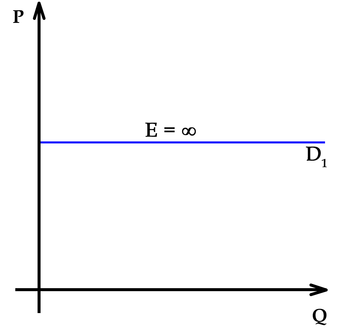
Demand curve in a perfectly competitive market
This is the demand curve in a perfectly competitive market. Note how any increase in price would wipe out demand.
Also, in both sets of circumstances the suppliers cannot make a profit in the long-run. Ultimately, firms in both markets will only be able to break even by selling their goods and services.
Both markets are composed of firms seeking to maximize their profits. In both of these markets, profit maximization occurs when a firm produces goods to such a level so that its marginal costs of production equals its marginal revenues.
Differences
One key difference between these two set of economic circumstances is efficiency. A perfectly competitive market is perfectly efficient. This means that the price is Pareto optimal, which means that any shift in the price would benefit one party at the expense of the other. The overall economic surplus, which is the sum of the producer and consumer surpluses, is maximized. The suppliers cannot influence the price of the good or service in question; the market dictates the price. The price of the good or service in a perfectly competitive market is equal to the marginal costs of manufacturing that good or service.
In a monopolistically competitive market the price is higher than the marginal cost of producing the good or service and the suppliers can influence the price, granting them market power. This decreases the consumer surplus, and by extension the market’s economic surplus, and creates deadweight loss.
Another key difference between the two is product differentiation. In a perfectly competitive market products are perfect substitutes for each other. But in monopolistically competitive markets the products are highly differentiated. In fact, firms work hard to emphasize the non-price related differences between their products and their competitors’.
A final difference involves barriers to entry and exit. Perfectly competitive markets have no barriers to entry and exit; a firm can freely enter or leave an industry based on its perception of the market’s profitability. In a monopolistic competitive market there are few barriers to entry and exit, but still more than in a perfectly competitive market.
12.1.7: Efficiency of Monopolistic Competition
Monopolistic competitive markets are never efficient in any economic sense of the term.
Learning Objective
Discuss the effect monopolistic competition has on overall market efficiency
Key Points
- Because a good is always priced higher than its marginal cost, a monopolistically competitive market can never achieve productive or allocative efficiency.
- Suppliers in monopolistically competitive firms will produce below their capacity.
- Because monopolistic firms set prices higher than marginal costs, consumer surplus is significantly less than it would be in a perfectly competitive market. This leads to deadweight loss and an overall decrease in economic surplus.
Key Terms
- producer surplus
-
The amount that producers benefit by selling at a market price that is higher than the lowest price at which they would be willing to sell.
- consumer surplus
-
The difference between the maximum price a consumer is willing to pay and the actual price they do pay.
Monopolistically competitive markets are less efficient than perfectly competitive markets.
Producer and Consumer Surplus
In terms of economic efficiency, firms that are in monopolistically competitive markets behave similarly as monopolistic firms. Both types of firms’ profit maximizing production levels occur when their marginal revenues equals their marginal costs. This quantity is less than what would be produced in a perfectly competitive market. It also means that producers will supply goods below their manufacturing capacity.
Firms in a monopolistically competitive market are price setters, meaning they get to unilaterally charge whatever they want for their goods without being influenced by market forces. In these types of markets, the price that will maximize their profit is set where the profit maximizing production level falls on the demand curve.This price exceeds the firm’s marginal costs and is higher than what the firm would charge if the market was perfectly competitive. This means two things:
- Consumers will have to pay a higher price than they would in a perfectly competitive market, leading to a significant decline in consumer surplus; and
- Producers will sell less of their goods than they would have in a perfectly competitive market, which could offset their gains from charging a higher price and could result in a decline in producer surplus.
Regardless of whether there is a decline in producer surplus, the loss in consumer surplus due to monopolistic competition guarantees deadweight loss and an overall loss in economic surplus .

Inefficiency in Monopolistic Competition
Monopolistic competition creates deadweight loss and inefficiency, as represented by the yellow triangle. The quantity is produced when marginal revenue equals marginal cost, or where the green and blue lines intersect. The price is determined based on where the quantity falls on the demand curve, or the red line. In the short run, the monopolistic competition market acts like a monopoly.
Productive and Allocative Efficiency
Productive efficiency occurs when a market is using all of its resources efficiently. This occurs when a product’s price is set at its marginal cost, which also equals the product’s average total cost. In a monopolistic competitive market, firms always set the price greater than their marginal costs, which means the market can never be productively efficient.
Allocative efficiency occurs when a good is produced at a level that maximizes social welfare. This occurs when a product’s price equals its marginal benefits, which is also equal to the product’s marginal costs. Again, since a good’s price in a monopolistic competitive market always exceeds its marginal cost, the market can never be allocatively efficient.
12.1.8: Advertising and Brand Management in Monopolistic Competition
Advertising and branding help firms in monopolistic competitive markets differentiate their products from those of their competitors.
Learning Objective
Evaluate whether advertising is beneficial or detrimental to consumers
Key Points
- A company’s brand can help promote quality in that company’s products.
- Advertising helps inform consumers about products, which decreases selection costs.
- Costs associated with advertising and branding include higher prices, customers mislead by false advertisements, and negative societal affects such as perpetuating stereotypes and spam.
Key Terms
- brand
-
The reputation of an organization, a product, or a person among some segment of the population.
- advertising
-
Communication with the purpose of influencing potential customers about products and services
One of the characteristics of a monopolistic competitive market is that each firm must differentiate its products. Two ways to do this is through advertising and cultivating a brand. Advertising is a form of communication meant to inform, educate, and influence potential customers about products and services. Advertising is generally used by businesses to cultivate a brand . A brand is a company’s reputation in relation to products or services sold under a specific name or logo.
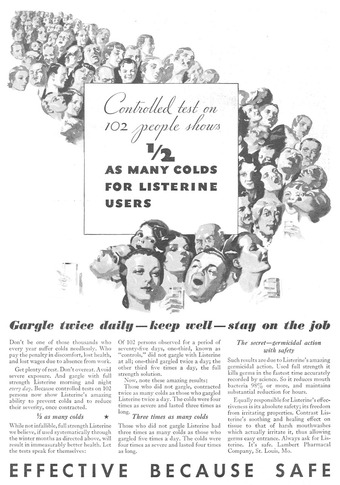
Listerine advertisement, 1932
From 1921 until the mid-1970s, Listerine was also marketed as preventive and a remedy for colds and sore throats. In 1976, the Federal Trade Commission ruled that these claims were misleading, and that Listerine had “no efficacy” at either preventing or alleviating the symptoms of sore throats and colds. Warner-Lambert was ordered to stop making the claims and to include in the next $10.2 million dollars of Listerine ads specific mention that “contrary to prior advertising, Listerine will not help prevent colds or sore throats or lessen their severity. “
Benefits of Advertising and Branding
The purpose of the brand is to generate an immediate positive reaction from consumers when they see a product or service being sold under a certain name in order to increase sales. A brand and the associated reputation are built on advertising and consumers’ past experiences with the products associated with that brand.
Reputation among consumers is important to a monopolistically competitive firm because it is arguably the best way to differentiate itself from its competitors. However, for that reputation to be maintained, the firm must ensure that the products associated with the brand name are of the highest quality. This standard of quality must be maintained at all times because it only takes one bad experience to ruin the value of the brand for a segment of consumers. Brands and advertising can thus help guarantee quality products for consumers and society at large.
Advertising is also valuable to society because it helps inform consumers. Markets work best when consumers are well informed, and advertising provides that information. Advertising and brands can help minimize the costs of choosing between different products because of consumers’ familiarity with the firms and their quality.
Finally, advertising allows new firms to enter into a market. Consumers might be hesitant to purchase products with which they are unfamiliar. Advertising can educate and inform those consumers, making them comfortable enough to give those products a try.
Costs of Advertising and Branding
There are some concerns about how advertising can harm consumers and society as well. Some believe that advertising and branding induces customers to spend more on products because of the name associated with them rather than because of rational factors. Further, there is no guarantee that advertisements accurately describe products; they can mislead consumers. Finally, advertising can have negative societal effects such as the perpetuation of negative stereotypes or the nuisance of “spam. “
Chapter 11: Monopoly
11.1: Introduction to Monopoly
11.1.1: Defining Monopoly
A monopoly is an economic market structure where a specific person or enterprise is the only supplier of a particular good.
Learning Objective
Differentiate monopolies and competitive markets
Key Points
- A monopoly market is characterized by the profit maximizer, price maker, high barriers to entry, single seller, and price discrimination.
- Monopoly characteristics include profit maximizer, price maker, high barriers to entry, single seller, and price discrimination.
- Sources of monopoly power include economies of scale, capital requirements, technological superiority, no substitute goods, control of natural resources, legal barriers, and deliberate actions.
- There are a few similarities between a monopoly and competitive market: the cost functions are the same, both minimize cost and maximize profit, the shutdown decisions are the same, and both are assumed to have perfectly competitive market factors.
- Differences between the two market structures including: marginal revenue and price, product differentiation, number of competitors, barriers to entry, elasticity of demand, excess profits, profit maximization, and the supply curve.
- The most significant distinction is that a monopoly has a downward sloping demand instead of the “perceived” perfectly elastic curve of the perfectly competitive market.
Key Terms
- monopoly
-
A market where one company is the sole supplier.
- differentiation
-
The act of distinguishing a product from the others in the market.
A monopoly is a specific type of economic market structure. A monopoly exists when a specific person or enterprise is the only supplier of a particular good. As a result, monopolies are characterized by a lack of competition within the market producing a good or service .

Monopoly
The graph shows a monopoly and the price (P) and change in price (P reg) as well as the output (Q) and output change (Q reg).
Characteristics of a Monopoly
A monopoly can be recognized by certain characteristics that set it aside from the other market structures:
- Profit maximizer: a monopoly maximizes profits. Due to the lack of competition a firm can charge a set price above what would be charged in a competitive market, thereby maximizing its revenue.
- Price maker: the monopoly decides the price of the good or product being sold. The price is set by determining the quantity in order to demand the price desired by the firm (maximizes revenue).
- High barriers to entry: other sellers are unable to enter the market of the monopoly.
- Single seller: in a monopoly one seller produces all of the output for a good or service. The entire market is served by a single firm. For practical purposes the firm is the same as the industry.
- Price discrimination: in a monopoly the firm can change the price and quantity of the good or service. In an elastic market the firm will sell a high quantity of the good if the price is less. If the price is high, the firm will sell a reduced quantity in an elastic market.
Sources of Monopoly Power
In a monopoly, specific sources generate the individual control of the market. Sources of power include:
- Economies of scale
- Capital requirements
- Technological superiority
- No substitute goods
- Control of natural resources
- Network externalities
- Legal barriers
- Deliberate actions
Monopoly vs. Competitive Market
Monopolies and competitive markets mark the extremes in regards to market structure. There are a few similarities between the two including: the cost functions are the same, both minimize cost and maximize profit, the shutdown decisions are the same, and both are assumed to have perfectly competitive market factors.
However, there are noticeable differences between the two market structures including: marginal revenue and price, product differentiation, number of competitors, barriers to entry, elasticity of demand, excess profits, profit maximization, and the supply curve. The most significant distinction is that a monopoly has a downward sloping demand instead of the “perceived” perfectly elastic curve of the perfectly competitive market.
11.2: Barriers to Entry: Reasons for Monopolies to Exist
11.2.1: Resource Control
Control over a natural resource that is critical to the production of a final good is one source of monopoly power.
Learning Objective
Explain the relationship between resource control and monopolies
Key Points
- Single ownership over a resource gives the owner the power to raise the market price of a good over marginal cost without losing customers to competitors.
- De Beers is a classic example of a monopoly based on a natural resource. De Beers had a lot of market power in the world market for diamonds over the course of the 20th century, keeping the price of diamonds high.
- In practice, monopolies rarely arise because of control over natural resources.
Key Terms
- market power
-
The ability of a firm to profitably raise the market price of a good or service over marginal cost. A firm with total market power can raise prices without losing any customers to competitors.
- economic rent
-
The portion of income paid to a factor of production in excess of its opportunity cost.
Control over natural resources that are critical to the production of a good is one source of monopoly power. Single ownership over a resource gives the owner of the resource the power to raise the market price of a good over marginal cost without losing customers to competitors. In other words, resource control allows the controller to charge economic rent. This is a classic outcome of imperfectly competitive markets.
A classic example of a monopoly based on resource control is De Beers . De Beers Consolidated Mines were founded in 1888 in South Africa as an amalgamation of a number of individual diamond mining operations. De Beers had a monopoly over the production of diamonds for most of the 20th century, and it used its dominant position to manipulate the international diamond market. It convinced independent producers to join its single channel monopoly. In instances when producers refused to join, De Beers flooded the market with diamonds similar to the ones they were producing. De Beers also purchased and stockpiled diamonds produced by other manufacturers in order to control prices through supply. The De Beers model changed at the turn of the 21st century, when diamond producers from Russia, Canada, and Australia started to distribute diamonds outside of the De Beers channel. The sale of diamonds also suffered from rising awareness about blood diamonds. De Beers’ market share fell from as high as 90 percent in the 1980s to less than 40 percent in 2012.

Diamonds
For most of the 20th century, De Beers had monopoly power over the world market for diamonds.
In practice, monopolies rarely arise because of control over natural resources. Economies are large, usually with multiple people owning resources. International trade is an additional source of competition for owners of natural resources.
11.2.2: Economies of Scale and Network Externalities
Economies of scale and network externalities discourage potential competitors from entering a market.
Learning Objective
Define Economies of Scale., Explain why economies of scale are desirable for monopolies
Key Points
- Economies of scale are cost advantages that large firms gain because of their size.
- Natural monopolies arise as a result of economies of scale. Natural monopolies have overwhelming cost advantages over potential competitors.
- Network effects occur when the value of a good or service increases because many other people are using it. This makes competing goods or services with lower levels of adoption unattractive to new customers.
Key Terms
- economies of scale
-
The characteristics of a production process in which an increase in the scale of the firm causes a decrease in the long run average cost of each unit.
- Network externalities
-
Are evident when the value of a product or service is dependent on the number of other people using it.
- Natural monopoly
-
Occurs when a firm is able to serve the entire market demand at a lower cost than any combination of two or more smaller, more specialized firms.
Economies of scale and network externalities are two types of barrier to entry. They discourage potential competitors from entering a market, and thus contribute to the monopolistic power of some firms.
Economies of scale are cost advantages that large firms obtain due to their size.They occur because the cost per unit of output decreases with increasing scale, as fixed costs are spread over more units of output . Economies of scale are also gained through bulk-buying of materials with long-term contracts, the increased specialization of managers, ability to obtain lower interest rates when borrowing from banks, access to a greater range of financial instruments, and spreading the cost of marketing over a greater range of output. Each of these factors contributes to reductions in the long-run average cost of production.
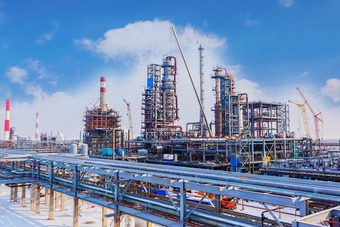
Economies of Scale
Large firms obtain economies of scale in part because fixed costs are spread over more units of output.
A natural monopoly arises as a result of economies of scale. For natural monopolies, the average total cost declines continually as output increases, giving the monopolist an overwhelming cost advantage over potential competitors. It becomes most efficient for production to be concentrated in a single firm.
Network externalities (also called network effects) occur when the value of a good or service increases as a result of many people using it. Because of network effects, certain goods or services that are adopted widely will appear to be much more attractive to new customers than competing goods or services. This is evident in online social networks. Social networks with the largest memberships are more attractive to new users, because new users know that their friends or colleagues are more likely to be on these networks. It is also evident with certain software programs. For example, most people use Microsoft word processing software. While other word processing programs may be available, an individual would risk running into compatibility problems when sending files to people or machines using the mainstream software. This makes it difficult for new companies to enter the market and to gain market share.
11.2.3: Government Action
There are two types of government-initiated monopoly: a government monopoly and a government-granted monopoly.
Learning Objective
Discuss different types of monopolies initiated by government
Key Points
- Government-granted monopolies and government monopolies differ in the decision-making structure of the monopolist. In a government-granted monopoly, business decisions are made by a private firm. In a government monopoly, decisions are made by a government agency.
- In a government-granted monopoly, the government gives a private individual or a firm the right to be a sole provider of a good or service.
- In a government monopoly, an agency under the direct authority of the government itself holds the monopoly.
- In both types of government-initiated monopoly competition is kept out of the market through laws, regulations, and other mechanisms of government enforcement.
Key Terms
- Government monopoly
-
A form of monopoly in which a government agency is the sole provider of a particular good or service and competition is prohibited by law.
- Government-granted monopoly
-
A form of monopoly in which a government grants exclusive rights to a private individual or firm to be the sole provider of a good or service.
Monopoly Creation
There are instances in which the government initiates monopolies, creating a government-granted monopoly or a government monopoly. Government-granted monopolies often closely resemble government monopolies in many respects, but the two are distinguished by the decision-making structure of the monopolist. In a government monopoly, the holder of the monopoly is formally the government itself and the group of people who make business decisions is an agency under the government’s direct authority. In a government-granted monopoly, on the other hand, the monopoly is enforced through the law, but the holder of the monopoly is formally a private firm, which makes its own business decisions.
Government-Granted Monopoly
In a government-granted monopoly, the government gives a private individual or a firm the right to be a sole provider of a good or service. Potential competitors are excluded from the market by law, regulation, or other mechanisms of government enforcement. Intellectual property rights such as copyright and patents are government-granted monopolies. Additionally, the Dutch East India Company provides a historical example of a government-granted monopoly. It was granted exclusive trading privileges with colonial possessions under mercantilist economic policy.
Government Monopoly
In a government monopoly, an agency under the direct authority of the government itself holds the monopoly, and the monopoly is sustained by the enforcement of laws and regulations that ban competition or reserve exclusive control over factors of production to the government. The state-owned petroleum companies that are common in oil-rich developing countries (such as Aramco in Saudi Arabia or PDVSA in Venezuela) are examples of government monopolies created through nationalization of resources and existing firms. The United States Postal Service is another example of a government monopoly . It was created through laws that ban potential competitors from offering certain types of services, such as first-class and standard mail delivery. Around the world, government monopolies on public utilities, telecommunications systems, and railroads have historically been common.

Postal Service
The postal service operates as a government monopoly in many countries, including the United States.
11.2.4: Legal Barriers
The government creates legal barriers through patents, copyrights, and granting exclusive rights to companies.
Learning Objective
Identify the legal conditions that lead to monopolistic power.
Key Points
- Intellectual property rights are an example of legal barriers that give rise to monopolies.
- A copyright gives the creator of an original creative work exclusive rights to it for a limited time. This provides an incentive for the continued creation of innovative goods.
- A patent is a limited property right the government gives inventors in exchange for the details of their invention being made public.
- The government can provide exclusive or special rights to companies that legally allow them to be monopolies.
Key Terms
- patent
-
A declaration issued by a government agency declaring the inventor of a new product has the privilege of stopping others from making, using or selling the claimed invention for a limited time.
- Copyright
-
A legal concept that gives the creator of an original work exclusive rights to it, usually for a limited time, with the intention of enabling the creator to be compensated for his or her work.
In some cases, the government will grant a person or firm exclusive rights to produce a good or service, enabling them to monopolize the market for this good or service. Intellectual property rights, including copyright and patents, are an important example of legal barriers that give rise to monopolies.
Copyright
Copyright gives the creator of an original creative work (such as a book, song, or film) exclusive rights to it, usually for a limited time, with the intention of enabling the creator to be compensated for his or her work . The intent behind copyright is to promote the creation of new works by providing creators the opportunity to profit from their works. The copyright holder receives the right to be credited for the work, to determine who may adapt the work to other forms, who may perform the work, and who may financially benefit from it, along with other related rights. When the copyright on a work expires, the work is transferred to the public domain, enabling others to repurpose and build on the work.

Copyright
Copyright is an example of a temporary legal monopoly granted to creators of original creative works.
Patent
A patent is a limited property right the government gives inventors in exchange for their agreement to share the details of their invention with the public. During the term of the patent, the patent holder has the right to exclude others from making, using, or selling the patented invention. The patent provides incentives (1) to invent in the first place, (2) to disclose the invention once it is made, (3) to make the necessary investments in research and development, production, and bringing the invention to market, and (4) to innovate by designing around or improving upon earlier patents. When a patent expires and the invention enters the public domain, others can build on the invention.
For example, when a pharmaceutical company first markets a drug, it is usually under a patent, and only the pharmaceutical company can sell it until the patent expires. This allows the company to recoup the cost of developing this particular drug. After the patent expires, any pharmaceutical company can manufacture and sell a generic version of the drug, bringing down the price of the original drug to compete with new versions.
Government Granted Monopoly
It is also possible that there is a monopoly because the government has granted a single company exclusive or special rights. The water utility company, for example, is a monopoly in your area because it is the only organization granted the right to provide water. Another example is that the Digital Millenium Copyright Act the proprietary Macrovision copy prevention technology is required for analog video recorders. Though other forms of copy prevention aren’t prohibited, requiring Macrovision effectively gives it a monopoly and prevents more effective copy prevention methods from being developed.
11.2.5: Natural Monopolies
Natural monopolies occur when a single firm can serve the entire market at a lower cost than a combination of two or more firms.
Learning Objective
Demonstrate an understanding of how a natural monopoly is created
Key Points
- A natural monopoly’s cost structure is very different from that of most industries. For a natural monopoly, the average total cost continues to shrink as output increases.
- Natural monopolies tend to form in industries where there are high fixed costs. A firm with high fixed costs requires a large number of customers in order to have a meaningful return on investment.
- Other firms are discouraged from entering the market because of the high initial costs and the difficulty of obtaining a large enough market share to achieve the same low costs as the monopolist.
Key Terms
- economies of scale
-
The characteristics of a production process in which an increase in the scale of the firm causes a decrease in the long run average cost of each unit.
- Natural monopoly
-
Occurs when a firm is able to serve the entire market demand at a lower cost than any combination of two or more smaller, more specialized firms.
Natural monopolies occur when a single firm is able to serve the entire market demand at a lower cost than any combination of two or more smaller firms. For example, imagine there are two firms in a natural monopoly’s market and each of them produces half of the quantity that the monopoly produces. The total cost of the natural monopoly is lower than the sum of the total costs of two firms producing the same quantity .
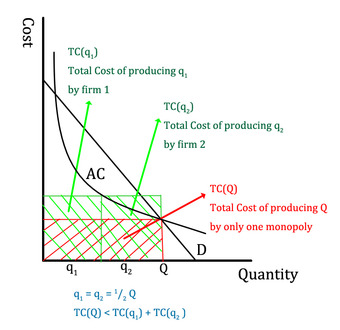
Natural Monopoly
The total cost of the natural monopoly’s production is lower than the sum of the total costs of two firms producing the same quantity.
Cost Structure
A natural monopoly’s cost structure is very different from that of most industries. In other industries, the marginal cost initially decreases due to economies of scale, then increases as the company experiences growing pains (as employees become overworked, the firm’s bureaucracy expands, etc.). Along with this, the average cost of production decreases and then increases. In contrast, a natural monopoly will have a marginal cost that is constant or declining, and an average total cost that drops as the quantity of output increases.
Fixed Costs
Natural monopolies tend to form in industries where there are high fixed costs. A firm with high fixed costs requires a large number of customers in order to have a meaningful return on investment. As it gains market share and increases its output, the fixed cost is divided among a larger number of customers. Therefore, in industries with large initial investment requirements, average total costs decline as output increases. Once a natural monopoly has been established, there will be high barriers to entry for other firms because of the large initial cost and because it would be difficult for the entrant to capture a large enough part of the market to achieve the same low costs as the monopolist.
Examples of natural monopolies are water and electricity services. For both of these, fixed costs of building the necessary infrastructure are high. The cost of constructing a competing transmission network and delivering service will be so high that it effectively bars potential competitors from entering the monopolist’s market.
11.2.6: Other Barriers to Entry
Firms gain monopolistic power as a result of markets’ barriers to entry, which discourage potential competitors.
Learning Objective
Identify the common conditions that lead to monopolistic power
Key Points
- There are several different types of barriers to entry, including a firm’s control over scarce natural resources, high capital requirements for an industry, economies of scale, network effects, legal barriers, and government backing.
- Some industries require large investments in capital or research and development, making it difficult for new firms to enter.
- Monopolies benefit from economies of scale, which give them a cost advantage over their competitors.
- The legal system can grant firms monopoly rights over a resource or production of a good.
Key Terms
- Barriers to entry
-
Circumstances that prevent or greatly impede a potential competitor’s ability to compete in the market.
- Network effects
-
When the value of a product or service is dependent on the number of people using it.
Monopolies derive their market power from barriers to entry: circumstances that prevent or greatly impede a potential competitor’s ability to compete in the market. There are several different types of barriers to entry.
Control Over Natural Resources
The supply of natural resources such as precious metals or oil deposits is limited, giving their owners monopoly powers. For example, De Beers controls the vast majority of the world’s diamond reserves, allowing only a certain number of diamonds to be mined each year and keeping the price of diamonds high .

Diamond
De Beers controls the majority of the world’s diamond reserves, preventing other players from entering the industry and setting a high price for diamonds.
High Capital Requirements
Some production processes require large investments in capital or large research and development costs that make it difficult for new companies to enter an industry. Examples include steel production, pharmaceuticals, and space transport.
Economies of Scale
Monopolies exhibit decreasing costs as output increases. Decreasing costs coupled with large initial costs give monopolies a cost advantage in production over would-be competitors. Market entrants have not yet achieved economies of scale, so their output simply costs so much more than the incumbent firms that market entry is difficult.
Network Effects
The use of a product by other people can increase its value to a person . One example is Microsoft spreadsheet and word processing software, which is still used widely. This is because when a person uses software that is used by so many others, he or she is less likely to run into compatibility problems in the course of work or other activities. This tendency to use what everyone else is using makes it difficult for new companies to develop and sell competing software.

Network effects are one reason why it’s so difficult for new companies to compete against Facebook: they simply will have difficulty establishing a network of users to compete.
Legal Barriers
Legal rights can provide an opportunity to monopolize a market for a good. Intellectual property rights, such as patents and copyright, give the rights holder exclusive control over the production and sale of certain goods. Property rights may give a company exclusive control of the materials necessary to produce a good. The granting of permits or professional licenses can also favor certain firms, while setting standards that are difficult for new firms to meet.
Government Backing
There are cases in which a government agency is the sole provider of a particular good or service and competition is prohibited by law. For example, in many countries, the postal system is run by the government with competition forbidden by law in some or all services. Government monopolies in public utilities, telecommunications systems, and railroads have also historically been common. In other instances, the government may be an invested partner in a monopoly rather than a sole owner. This will still make it difficult for competitors to operate on equal footing.
11.3: Monopoly Production and Pricing Decisions and Profit Outcome
11.3.1: Market Differences Between Monopoly and Perfect Competition
Monopolies, as opposed to perfectly competitive markets, have high barriers to entry and a single producer that acts as a price maker.
Learning Objective
Distinguish between monopolies and competitive firms
Key Points
- In a perfectly competitive market, there are many producers and consumers, no barriers to exit and entry into the market, perfectly homogenous goods, perfect information, and well-defined property rights.
- Perfectly competitive producers are price takers that can choose how much to produce, but not the price at which they can sell their output.
- A monopoly exists when there is only one producer and many consumers.
- Monopolies are characterized by a lack of economic competition to produce the good or service and a lack of viable substitute goods.
Key Terms
- perfect competition
-
A type of market with many consumers and producers, all of whom are price takers
- network externality
-
The effect that one user of a good or service has on the value of that product to other people
- perfect information
-
The assumption that all consumers know all things, about all products, at all times, and therefore always make the best decision regarding purchase.
A market can be structured differently depending on the characteristics of competition within that market. At one extreme is perfect competition. In a perfectly competitive market, there are many producers and consumers, no barriers to enter and exit the market, perfectly homogeneous goods, perfect information, and well-defined property rights. This produces a system in which no individual economic actor can affect the price of a good – in other words, producers are price takers that can choose how much to produce, but not the price at which they can sell their output. In reality there are few industries that are truly perfectly competitive, but some come very close. For example, commodity markets (such as coal or copper) typically have many buyers and multiple sellers. There are few differences in quality between providers so goods can be easily substituted, and the goods are simple enough that both buyers and sellers have full information about the transaction. It is unlikely that a copper producer could raise their prices above the market rate and still find a buyer for their product, so sellers are price takers.
A monopoly, on the other hand, exists when there is only one producer and many consumers. Monopolies are characterized by a lack of economic competition to produce the good or service and a lack of viable substitute goods. As a result, the single producer has control over the price of a good – in other words, the producer is a price maker that can determine the price level by deciding what quantity of a good to produce. Public utility companies tend to be monopolies. In the case of electricity distribution, for example, the cost to put up power lines is so high it is inefficient to have more than one provider. There are no good substitutes for electricity delivery so consumers have few options. If the electricity distributor decided to raise their prices it is likely that most consumers would continue to purchase electricity, so the seller is a price maker.
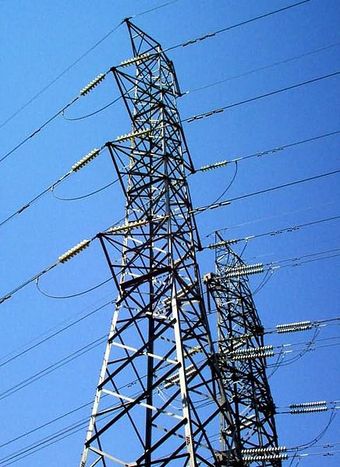
Electricity Distribution
The cost of electrical infrastructure is so expensive that there are few or no competitors for electricity distribution. This creates a monopoly.
Sources of Monopoly Power
Monopoly power comes from markets that have high barriers to entry. This can be caused by a variety of factors:
- Increasing returns to scale over a large range of production
- High capital requirements or large research and development costs
- Production requires control over natural resources
- Legal or regulatory barriers to entry
- The presence of a network externality – that is, the use of a product by a person increases the value of that product for other people
Monopoly Vs. Perfect Competition
Monopoly and perfect competition mark the two extremes of market structures, but there are some similarities between firms in a perfectly competitive market and monopoly firms. Both face the same cost and production functions, and both seek to maximize profit. The shutdown decisions are the same, and both are assumed to have perfectly competitive factors markets.
However, there are several key distinctions. In a perfectly competitive market, price equals marginal cost and firms earn an economic profit of zero. In a monopoly, the price is set above marginal cost and the firm earns a positive economic profit. Perfect competition produces an equilibrium in which the price and quantity of a good is economically efficient. Monopolies produce an equilibrium at which the price of a good is higher, and the quantity lower, than is economically efficient. For this reason, governments often seek to regulate monopolies and encourage increased competition.
11.3.2: Marginal Revenue and Marginal Cost Relationship for Monopoly Production
For monopolies, marginal cost curves are upward sloping and marginal revenues are downward sloping.
Learning Objective
Analyze how marginal and marginal costs affect a company’s production decision
Key Points
- Firm typically have marginal costs that are low at low levels of production but that increase at higher levels of production.
- While competitive firms experience marginal revenue that is equal to price – represented graphically by a horizontal line – monopolies have downward-sloping marginal revenue curves that are different than the good’s price.
- For monopolies, marginal revenue is always less than price.
Key Terms
- marginal cost
-
The increase in cost that accompanies a unit increase in output; the partial derivative of the cost function with respect to output. Additional cost associated with producing one more unit of output.
- marginal revenue
-
The additional profit that will be generated by increasing product sales by one unit.
Profit Maximization
In traditional economics, the goal of a firm is to maximize their profits. This means they want to maximize the difference between their earnings, i.e. revenue, and their spending, i.e. costs. To find the profit maximizing point, firms look at marginal revenue (MR) – the total additional revenue from selling one additional unit of output – and the marginal cost (MC) – the total additional cost of producing one additional unit of output. When the marginal revenue of selling a good is greater than the marginal cost of producing it, firms are making a profit on that product. This leads directly into the marginal decision rule, which dictates that a given good should continue to be produced if the marginal revenue of one unit is greater than its marginal cost. Therefore, the maximizing solution involves setting marginal revenue equal to marginal cost.
This is relatively straightforward for firms in perfectly competitive markets, in which marginal revenue is the same as price . Monopoly production, however, is complicated by the fact that monopolies have demand curves and MR curves that are distinct, causing price to differ from marginal revenue .

Monopoly
In a monopoly market, the marginal revenue curve and the demand curve are distinct and downward-sloping. Production occurs where marginal cost and marginal revenue intersect.

Perfect Competition
In a perfectly competitive market, the marginal revenue curve is horizontal and equal to demand, or price. Production occurs where marginal cost and marginal revenue intersect.
Monopoly Profit Maximization
The marginal cost curves faced by monopolies are similar to those faced by perfectly competitive firms. Most will have low marginal costs at low levels of production, reflecting the fact that firms can take advantage of efficiency opportunities as they begin to grow. Marginal costs get higher as output increases. For example, a pizza restaurant can easily double production from one pizza per hour to two without hiring additional employees or buying more sophisticated equipment. When production reaches 50 pizzas per hour, however, it may be difficult to grow without investing a lot of money in more skilled employees or more high-tech ovens. This trend is reflected in the upward-sloping portion of the marginal cost curve.
The marginal revenue curve for monopolies, however, is quite different than the marginal revenue curve for competitive firms. While competitive firms experience marginal revenue that is equal to price – represented graphically by a horizontal line – monopolies have downward-sloping marginal revenue curves that are different than the good’s price.
11.3.3: Profit Maximization Function for Monopolies
Monopolies set marginal cost equal to marginal revenue in order to maximize profit.
Learning Objective
Explain the monopolist’s profit maximization function
Key Points
- The first-order condition for maximizing profits in a monopoly is 0=∂q=p(q)+qp′(q)−c′(q), where q = the profit-maximizing quantity.
- A monopoly’s profits are represented by π=p(q)q−c(q), where revenue = pq and cost = c.
- Monopolies have the ability to limit output, thus charging a higher price than would be possible in competitive markets.
Key Terms
- deadweight loss
-
A loss of economic efficiency that can occur when an equilibrium is not Pareto optimal.
- first-order condition
-
A mathematical relationship that is necessary for a quantity to be maximized or minimized.
Monopolies have much more power than firms normally would in competitive markets, but they still face limits determined by demand for a product. Higher prices (except under the most extreme conditions) mean lower sales. Therefore, monopolies must make a decision about where to set their price and the quantity of their supply to maximize profits. They can either choose their price, or they can choose the quantity that they will produce and allow market demand to set the price.
Since costs are a function of quantity, the formula for profit maximization is written in terms of quantity rather than in price. The monopoly’s profits are given by the following equation:
π=p(q)q−c(q)
In this formula, p(q) is the price level at quantity q. The cost to the firm at quantity q is equal to c(q). Profits are represented by π. Since revenue is represented by pq and cost is c, profit is the difference between these two numbers. As a result, the first-order condition for maximizing profits at quantity q is represented by:
0=∂q=p(q)+qp′(q)−c′(q)
The above first-order condition must always be true if the firm is maximizing its profit – that is, if p(q)+qp′(q)−c′(q) is not equal to zero, then the firm can change its price or quantity and make more profit.
Marginal revenue is calculated by p(q)+qp′(q), which is derived from the term for revenue, pq. The term c′(q) is marginal cost, which is the derivative of c(q). Monopolies will produce at quantity q where marginal revenue equals marginal cost. Then they will charge the maximum price p(q) that market demand will respond to at that quantity.
Consider the example of a monopoly firm that can produce widgets at a cost given by the following function:
c(q)=2+3q+q2
If the firm produces two widgets, for example, the total cost is 2+3(2)+22=12. The price of widgets is determined by demand:
p(q)=24-2p
When the firm produces two widgets it can charge a price of 24-2(2)=20 for each widget. The firm’s profit, as shown above, is equal to the difference between the quantity produces multiplied by the price, and the total cost of production: p(q)q−c(q). How can we maximize this function?
Using the first order condition, we know that when profit is maximized, 0=p(q)+qp′(q)−c′(q). In this case:
0=(24-2p)+q(-2)-(3+2q)=21-6q
Rearranging the equation shows that q=3.5. This is the profit maximizing quantity of production.
Consider the diagram illustrating monopoly competition . The key points of this diagram are fivefold.
- First, marginal revenue lies below the demand curve. This occurs because marginal revenue is the demand, p(q), plus a negative number.
- Second, the monopoly quantity equates marginal revenue and marginal cost, but the monopoly price is higher than the marginal cost.
- Third, there is a deadweight loss, for the same reason that taxes create a deadweight loss: The higher price of the monopoly prevents some units from being traded that are valued more highly than they cost.
- Fourth, the monopoly profits from the increase in price, and the monopoly profit is illustrated.
- Fifth, since—under competitive conditions—supply equals marginal cost, the intersection of marginal cost and demand corresponds to the competitive outcome.
We see that the monopoly restricts output and charges a higher price than would prevail under competition.

Monopoly Diagram
This graph illustrates the price and quantity of the market equilibrium under a monopoly.
11.3.4: Monopoly Production Decision
To maximize output, monopolies produce the quantity at which marginal supply is equal to marginal cost.
Learning Objective
Explain how to identify the monopolist’s production point
Key Points
- Unlike a competitive company, a monopoly can decrease production in order to charge a higher price.
- Because of this, rather than finding the point where the marginal cost curve intersects a horizontal marginal revenue curve (which is equivalent to good’s price), we must find the point where the marginal cost curve intersect a downward-sloping marginal revenue curve.
- Monopolies have downward sloping demand curves and downward sloping marginal revenue curves that have the same y-intercept as demand but which are twice as steep.
- The shape of the curves shows that marginal revenue will always be below demand.
Key Terms
- marginal cost
-
The increase in cost that accompanies a unit increase in output; the partial derivative of the cost function with respect to output. Additional cost associated with producing one more unit of output.
- marginal revenue
-
The additional profit that will be generated by increasing product sales by one unit.
Monopoly Production
A pure monopoly has the same economic goal of perfectly competitive companies – to maximize profit. If we assume increasing marginal costs and exogenous input prices, the optimal decision for all firms is to equate the marginal cost and marginal revenue of production. Nonetheless, a pure monopoly can – unlike a firm in a competitive market – alter the market price for its own convenience: a decrease of production results in a higher price. Because of this, rather than finding the point where the marginal cost curve intersects a horizontal marginal revenue curve (which is equivalent to good’s price), we must find the point where the marginal cost curve intersect a downward-sloping marginal revenue curve.
Monopoly Production Point
Like non-monopolies, monopolists will produce the at the quantity such that marginal revenue (MR) equals marginal cost (MC). However, monopolists have the ability to change the market price based on the amount they produce since they are the only source of products in the market. When a monopolist produces the quantity determined by the intersection of MR and MC, it can charge the price determined by the market demand curve at the quantity. Therefore, monopolists produce less but charge more than a firm in a competitive market .

Monopoly Production
Monopolies produce at the point where marginal revenue equals marginal costs, but charge the price expressed on the market demand curve for that quantity of production.
In short, three steps can determine a monopoly firm’s profit-maximizing price and output:
- Calculate and graph the firm’s marginal revenue, marginal cost, and demand curves
- Identify the point at which the marginal revenue and marginal cost curves intersect and determine the level of output at that point
- Use the demand curve to find the price that can be charged at that level of output
11.3.5: Monopoly Price and Profit
Monopolies can influence a good’s price by changing output levels, which allows them to make an economic profit.
Learning Objective
Analyze the final price and resulting profit for a monopolist
Key Points
- Typically a monopoly selects a higher price and lesser quantity of output than a price-taking company.
- A monopoly, unlike a perfectly competitive firm, has the market all to itself and faces the downward-sloping market demand curve.
- Graphically, one can find a monopoly’s price, output, and profit by examining the demand, marginal cost, and marginal revenue curves.
Key Terms
- economic profit
-
The difference between the total revenue received by the firm from its sales and the total opportunity costs of all the resources used by the firm.
- demand
-
The desire to purchase goods and services.
Monopolies, unlike perfectly competitive firms, are able to influence the price of a good and are able to make a positive economic profit. While a perfectly competitive firm faces a single market price, represented by a horizontal demand/marginal revenue curve, a monopoly has the market all to itself and faces the downward-sloping market demand curve. An important consequence is worth noticing: typically a monopoly selects a higher price and lesser quantity of output than a price-taking company; again, less is available at a higher price.
Imagine that the market demand for widgets is Q=30-2P. This says that when the price is one, the market will demand 28 widgets; when the price is two, the market will demand 26 widgets; and so on. The monopoly’s total revenue is equal to the price of the widget multiplied by the quantity sold: P(30-2P). This can also be rearranged so that it is written in terms of quantity: total revenue equals Q(30-Q)/2.
The firm can produce widgets at a total cost of 2Q2, that is, it can produce one widget for $2, two widgets for $8, three widgets for $18, and so on. We know that all firms maximize profit by setting marginal costs equal to marginal revenue. Finding this point requires taking the derivative of total revenue and total cost in terms of quantity and setting the two derivatives equal to each other. In this case:
Setting these equal to each other:
So the profit maximizing point occurs when Q=3.
At this point, the price of widgets is $13.50, the monopoly’s total revenue is $40.50, the total cost is $18, and profit is $22.50. For comparison, it is easy to see that if the firm produced two widgets price would be $14 and profit would be $20; if it produced four widgets price would be $13 and profit would again be $20. Q=3 must be the profit-maximizing output for the monopoly.
Graphically, one can find a monopoly’s price, output, and profit by examining the demand, marginal cost, and marginal revenue curves. Again, the firm will always set output at a level at which marginal cost equals marginal revenue, so the quantity is found where these two curves intersect. Price, however, is determined by the demand for the good when that quantity is produced. Because a monopoly’s marginal revenue is always below the demand curve, the price will always be above the marginal cost at equilibrium, providing the firm with an economic profit .

Monopoly Pricing
Monopolies create prices that are higher, and output that is lower, than perfectly competitive firms. This causes economic inefficiency.
11.4: Impacts of Monopoly on Efficiency
11.4.1: Reasons for Efficiency Loss
A monopoly generates less surplus and is less efficient than a competitive market, and therefore results in deadweight loss.
Learning Objective
Evaluate the economic inefficiency created by monopolies
Key Points
- The monopoly pricing creates a deadweight loss because the firm forgoes transactions with the consumers.
- Monopolies can become inefficient and less innovative over time because they do not have to compete with other producers in a marketplace.
- In the case of monopolies, abuse of power can lead to market failure. Market failure occurs when the price mechanism fails to take into account all of the costs and/or benefits of providing and consuming a good.
- A monopoly is an imperfect market that restricts output in an attempt to maximize profit. Without the presence of market competitors it can be challenging for a monopoly to self-regulate and remain competitive over time.
Key Terms
- monopoly
-
A market where one company is the sole supplier.
- market failure
-
A concept within economic theory describing when the allocation of goods and services by a free market is not efficient.
- inefficient
-
Incapable of, or indisposed to, effective action; habitually slack or remiss; effecting little or nothing; as, inefficient workers; an inefficient administrator.
Monopoly
A monopoly exists when a specific enterprise is the only supplier of a particular commodity. Monopolies have little to no competition when producing a good or service. A monopoly is a business entity that has significant market power (the power to charge high prices).
Inefficiency in a Monopoly
In a monopoly, the firm will set a specific price for a good that is available to all consumers. The quantity of the good will be less and the price will be higher (this is what makes the good a commodity). The monopoly pricing creates a deadweight loss because the firm forgoes transactions with the consumers. The deadweight loss is the potential gains that did not go to the producer or the consumer. As a result of the deadweight loss, the combined surplus (wealth) of the monopoly and the consumers is less than that obtained by consumers in a competitive market. A monopoly is less efficient in total gains from trade than a competitive market.
Monopolies can become inefficient and less innovative over time because they do not have to compete with other producers in a marketplace. For private monopolies, complacency can create room for potential competitors to overcome entry barriers and enter the market. Also, long term substitutes in other markets can take control when a monopoly becomes inefficient.
Market Failure
When a market fails to allocate its resources efficiently, market failure occurs. In the case of monopolies, abuse of power can lead to market failure. Market failure occurs when the price mechanism fails to take into account all of the costs and/or benefits of providing and consuming a good. As a result, the market fails to supply the socially optimal amount of the good. A monopoly is an imperfect market that restricts output in an attempt to maximize profit . Market failure in a monopoly can occur because not enough of the good is made available and/or the price of the good is too high. Without the presence of market competitors it can be challenging for a monopoly to self-regulate and remain competitive over time.

Imperfect competition
This graph shows the short run equilibrium for a monopoly. The gray box illustrates the abnormal profit, although the firm could easily be losing money. A monopoly is an imperfect market that restricts the output in an attempt to maximize its profits.
11.4.2: Understanding and Finding the Deadweight Loss
In economics, deadweight loss is a loss of economic efficiency that occurs when equilibrium for a good or service is not Pareto optimal.
Learning Objective
Define deadweight loss, Explain how to determine the deadweight loss in a given market.
Key Points
- When deadweight loss occurs, there is a loss in economic surplus within the market.
- Causes of deadweight loss include imperfect markets, externalities, taxes or subsides, price ceilings, and price floors.
- In order to determine the deadweight loss in a market, the equation P=MC is used. The deadweight loss equals the change in price multiplied by the change in quantity demanded.
Key Terms
- equilibrium
-
The condition of a system in which competing influences are balanced, resulting in no net change.
- deadweight loss
-
A loss of economic efficiency that can occur when equilibrium for a good or service is not Pareto optimal.
Deadweight Loss
In economics, deadweight loss is a loss of economic efficiency that occurs when equilibrium for a good or service is not Pareto optimal. When a good or service is not Pareto optimal, the economic efficiency is not at equilibrium. As a result, when resources are allocated, it is impossible to make any one individual better off without making at least one person worse off. When deadweight loss occurs, there is a loss in economic surplus within the market. Deadweight loss implies that the market is unable to naturally clear.
Causes of Deadweight Loss
Deadweight loss is the result of a market that is unable to naturally clear, and is an indication, therefore, of market inefficiency. The supply and demand of a good or service are not at equilibrium. Causes of deadweight loss include:
- imperfect markets
- externalities
- taxes or subsides
- price ceilings
- price floors
Determining Deadweight Loss
In order to determine the deadweight loss in a market, the equation P=MC is used. The deadweight loss equals the change in price multiplied by the change in quantity demanded. This equation is used to determine the cause of inefficiency within a market.
For example, in a market for nails where the cost of each nail is $0.10, the demand will decrease from a high demand for less expensive nails to zero demand for nails at $1.10. In a perfectly competitive market, producers would charge $0.10 per nail and every consumer whose marginal benefit exceeds the $0.10 would have a nail. However, if one producer has a monopoly on nails they will charge whatever price will bring the largest profit. If they charge $0.60 per nail, every party who has less than $0.60 of marginal benefit will be excluded. When equilibrium is not achieved, parties who would have willingly entered the market are excluded due to the non-market price.
An example of deadweight loss due to taxation involves the price set on wine and beer. If a glass of wine is $3 and a glass of beer is $3, some consumers might prefer to drink wine. If the government decides to place a tax on wine at $3 per glass, consumers might choose to drink the beer instead of the wine. At times, policy makers will place a binding constraint on items when they believe that the benefit from the transfer of surplus outweighs the adverse impact of deadweight loss .

Deadweight loss
This graph shows the deadweight loss that is the result of a binding price ceiling. Policy makers will place a binding price ceiling when they believe that the benefit from the transfer of surplus outweighs the adverse impact of the deadweight loss.
11.5: Price Discrimination
11.5.1: Elasticity Conditions for Price Discrimination
In a competitive market, price discrimination occurs when identical goods and services are sold at different prices by the same provider.
Learning Objective
Examine the use of price discrimination in competitive markets
Key Points
- In pure price discrimination, the seller will charge the buyer the absolute maximum price that he is willing to pay. Companies use price discrimination in order to make the most revenue possible from every customer.
- Price discrimination is used throughout industries and includes coupons, premium pricing, discounts based on occupation, retail incentives, gender based discounts, financial aid, and haggling.
- Industries known for using price discrimination to maximize revenue include airlines, pharmaceutical manufacturers, and textbook publishers.
Key Terms
- price discrimination
-
The practice of selling identical goods or services at different prices from the same provider.
- revenue
-
The total income received from a given source.
- incentive
-
Something that motivates, rouses, or encourages.
Price Discrimination
In a competitive market, price discrimination occurs when identical goods and services are sold at different prices by the same provider. In pure price discrimination, the seller will charge the buyer the absolute maximum price that he is willing to pay. Companies use price discrimination in order to make the most revenue possible from every customer . This allows the producer to capture more of the total surplus by selling to consumers at prices closer to their maximum willingness to pay.

Price discrimination
A producer that can charge price Pa to its customers with inelastic demand and Pb to those with elastic demand can extract more total profit than if it had charged just one price.
An example of price discrimination would be the cost of movie tickets. Prices at one theater are different for children, adults, and seniors. The prices of each ticket can also vary based on the day and chosen show time. Ticket prices also vary depending on the portion of the country as well.
Industries use price discrimination as a way to increase revenue. It is possible for some industries to offer retailers different prices based solely on the volume of products purchased. Price discrimination can also be based on age, location, desire for the product, and customer wage.
Forms of Price Discrimination
There are a variety of ways in which industries legally use price discrimination. It is not important that pricing information be restricted, or that the price discriminated groups be unaware that others are being charged different prices:
- Coupons: coupons are used in retail as a way to distinguish customers by their reserve price. The assumption is that individuals who collect coupons are more sensitive to a higher price than those who don’t. By offering coupons, a producer can charge a higher price to price-insensitive customers and provide a discount to price-sensitive individuals.
- Premium pricing: premium products are priced at a level that is well beyond their marginal cost. For example, a regular cup of coffee might be priced at $1, while a premium coffee is $2.50.
- Discounts based on occupation: many businesses offer reduced prices to active military members. This can increase sales to the target group and provide positive publicity for the business which leads to increased sales. Less publicized discounts are also offered to off duty service workers such as police.
- Retail incentives: retail incentives are used to increase market share or revenues. They include rebates, bulk and quantity pricing, seasonal discounts
- Gender based discounts: gender based discounts are offered in some countries including the United States. Examples include free drinks at bars for women on “Ladies Night,” men often receive lower prices at the dry cleaners and hair salons than women because women clothes and hair generally take more time to work with. In contrast, men usually have higher car insurance rates than women based on the likelihood of being in an accident based on their age.
- Financial aid: financial aid is offered to college students based on either the student and/or the parents economic situation.
- Haggling: haggling is a form of price negotiation that requires knowledge and confidence from the customer.
Industries that Use Price Discrimination
The airline industry uses price discrimination regularly when they sell travel tickets simultaneously to different market segments. Price discrimination is evident within individual airlines, but also in the industry as a whole. Tickets vary based on the location within the plane, the time and day of the flight, the time of year, and what city the aircraft is traveling to. Prices can vary greatly within an airline and also among airlines. Customers must search for the best priced ticket based on their needs. Airlines do offer other forms of price discrimination including discounts, vouchers, and member perks for individuals with membership cards.
The pharmaceutical industry experiences international price discrimination. Drug manufacturers charge more for drugs in wealthier countries than in poor ones. For example, the United States has the highest drug prices in the world. On average, Europeans pay 56% less than Americans do for the same prescription medications. However, in many countries with lower drug costs, the difference in price is absorbed into the taxes which results in lower average salaries when compared to those in the United States.
Academic textbooks are another industry known for price discrimination. Textbooks in the United States are more expensive than they are overseas. Because most of the textbooks are published in the United States, it is obvious that transportation costs do not raise the price of the books. In the United States price discrimination on textbooks is due to copyright protection laws. Also, in the United States textbooks are mandatory where as in other countries they are viewed as optional study aids.
11.5.2: Analysis of Price Discrimination
Price discrimination is present in commerce when sellers adjust the price on the same product in order to make the most revenue possible.
Learning Objective
Analyze the use of price discrimination in commerce
Key Points
- Three factors that must be met for price discrimination to occur: the firm must have market power, the firm must be able to recognize differences in demand, and the firm must have the ability to prevent arbitration, or resale of the product.
- First degree price discrimination – the monopoly seller of a good or service must know the absolute maximum price that every consumer is willing to pay.
- Second degree price discrimination – the price of a good or service varies according to the quantity demanded.
- Third degree price discrimination – the price varies according to consumer attributes such as age, sex, location, and economic status.
- Price discrimination is present throughout commerce. Examples include airline and travel costs, coupons, premium pricing, gender based pricing, and retail incentives.
Key Term
- price discrimination
-
The practice of selling identical goods or services at different prices from the same provider.
Price Discrimination
Price discrimination exists within a market when the sales of identical goods or services are sold at different prices by the same provider. The goal of price discrimination is for the seller to make the most profit possible . Although the cost of producing the products is the same, the seller has the ability to increase the price based on location, consumer financial status, product demand, etc.
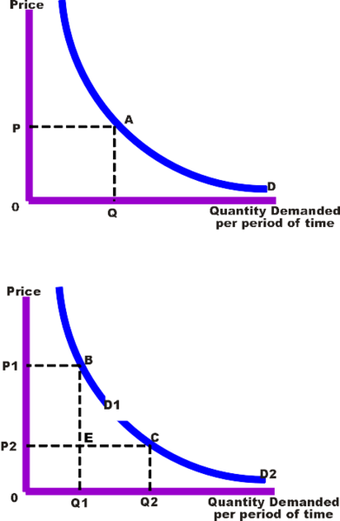
Sales Revenue
These graphs shows the difference in sales revenue with and without price discrimination. The intent of price discrimination is for the seller to make the most profit possible.
Price Discrimination Criteria
Within commerce there are specific criteria that must be met in order for price discrimination to occur:
- The firm must have market power.
- The firm must be able to recognize differences in demand.
- The firm must have the ability to prevent arbitration, or resale of the product.
Types of Price Discrimination
In commerce there are three types of price discrimination that exist. The exact price discrimination method that is used depends on the factors within the particular market.
- First degree price discrimination: the monopoly seller of a good or service must know the absolute maximum price that every consumer is willing to pay and can charge each customer that exact amount. This allows the seller to obtain the highest revenue possible.
- Second degree price discrimination: the price of a good or service varies according to the quantity demanded. Larger quantities are available at a lower price (higher discounts are given to consumers who buy a good in bulk quantities).
- Third degree price discrimination: the price varies according to consumer attributes such as age, sex, location, and economic status.
Examples of Price Discrimination
Price discrimination is a driving force in commerce. It is evident throughout markets and generates the highest revenue possible by shifting the price of a product based on the consumer’s willingness to pay, quantity demanded, and consumer attributes. Many examples of price discrimination are present throughout commerce including:
- Travel industry: airlines and other travel companies use price discrimination regularly in order to generate commerce. Prices vary according to seat selection, time of day, day of the week, time of year, and how close a purchase is made to the date of travel.
- Coupons: coupons are used in commerce to distinguish consumers by their reserve price. A manufacturer can charge a higher price for a product which most consumers will pay. Coupons attract sensitive consumers to the same product by offering a discount. By using price discrimination, the seller makes more revenue, even off of the price sensitive consumers.
- Premium pricing: uses price discrimination to price products higher than the marginal cost of production. Regular coffee is priced at $1 while premium coffee is $2.50. The marginal cost of production is only $0.90 and $1.25. The difference in price results in increased revenue because consumers are willing to pay more for the specific product.
- Gender based prices: uses price discrimination based on gender. For example, bars that have Ladies Nights are price discriminating based on gender.
- Retail incentives: uses price discrimination to offer special discounts to consumers in order to increase revenue. Incentives include rebates, bulk pricing, seasonal discounts, and frequent buyer discounts.
11.5.3: Examples of Price Discrimination
The purpose of price discrimination is to capture the market’s consumer surplus and generate the most revenue possible for a good.
Learning Objective
Give examples of price discrimination in common industries
Key Points
- Price discrimination occurs when identical goods or services are sold at different prices from the same provider.
- Industries that commonly use price discrimination include the travel industry, pharmaceutical industry, and textbook publishers.
- Examples of forms of price discrimination include coupons, age discounts, occupational discounts, retail incentives, gender based pricing, financial aid, and haggling.
Key Terms
- surplus
-
That which remains when use or need is satisfied, or when a limit is reached; excess; overplus.
- price discrimination
-
The practice of selling identical goods or services at different prices from the same provider.
- revenue
-
The total income received from a given source.
Price Discrimination
Price discrimination occurs when identical goods or services are sold at different prices from the same provider. There are three types of price discrimination:
- First degree – the seller must know the absolute maximum price that every consumer is willing to pay.
- Second degree – the price of the good or service varies according to quantity demanded.
- Third degree – the price of the good or service varies by attributes such as location, age, sex, and economic status.
The purpose of price discrimination is to capture the market’s consumer surplus. Price discrimination allows the seller to generate the most revenue possible for a good or service .

Price discrimination
These graphs show multiple market price discrimination. Instead of supplying one price and taking the profit (labelled “(old profit)”), the total market is broken down into two sub-markets, and these are priced separately to maximize profit. The graph shows how a seller wants to generate the most revenue possible for a good or service. The elasticity of a market influences the profit.
Examples of Price Discrimination
There are industries that conduct a substantial portion of their business using price discrimination:
- Travel industry: airlines and other travel companies use differentiated pricing often. Travel products and services are marketed to specific social segments. Airlines usually assign specific capacity to various booking classes. Also, prices fluctuate based on time of travel (time of day, day of the week, time of year). Prices fluctuate between companies as well as within each company.
- Pharmaceutical industry: price discrimination is common in the pharmaceutical industry. Drug-makers charge more for drugs in wealthier countries. For example, drug prices in the United States are some of the highest in the world. Europeans, on average, pay only 56% of what Americans pay for the same prescription drugs.
- Textbooks (physical ones, not your Boundless book! ): price discrimination is also prevalent within the publishing industry. Textbooks are much higher in the United States despite the fact that they are produced in the country. Copyright protection laws increase the price of textbooks. Also, textbooks are mandatory in the United States while schools in other countries see them as study aids.
Price discrimination is prevalent in varying degrees throughout most markets. Methods of price discrimination include:
- Coupons: coupons are used to distinguish consumers by their reserve price. Companies increase the price of a good and individuals who are not price sensitive will pay the higher price. Coupons allow price sensitive consumers to receive a discount. At the same time the seller is still making increased revenue.
- Age discounts: age discounts are a form of price discrimination where the price of a good or admission to an event is based on age. Age discounts are usually broken down by child, student, adult, and senior. In some cases, children under a certain age are given free admission or eat for free. Examples of places where age discounts are given include restaurants, movies, and other forms of entertainment.
- Occupational discounts: price discrimination is present when individuals receive certain discounts based on their occupation. An example is when active military members receive discounts.
- Retail incentives: this includes rebates, discount coupons, bulk and quantity pricing, seasonal discounts, and frequent buyer discounts.
- Gender based prices: in certain markets prices are set based on gender. For example, a Ladies Night at a bar is a form of price discrimination.
11.6: Monopoly in Public Policy
11.6.1: Social Impacts of Monopoly
A monopoly can diminish consumer choice, reduce incentives to innovate, and control supply to enforce inequitable prices in a society.
Learning Objective
Outline the effect of a monopoly on producer, consumer, and total surplus
Key Points
- In a perfectly competitive market, the antithesis of a monopoly, demand is completely elastic and the production quantity and price point align perfectly with marginal costs and actual costs.
- Perfect competition is a theoretical competitive framework. However, markets will naturally deviate to varying degrees (in order to capture profitable returns). As such, the perfect competition model is most useful in identifying and measuring deviations or departures from the competitive ideal.
- The accumulation of power and leverage on behalf of the suppliers largely revolves around the fact that monopolies can ultimately control supply in its entirety for a specified product or service.
- A monopoly with total control over the supply can charge any price that the consumer is willing to pay, and therefore can generate excessive margins while doing very little to improve their product/service or relevant processes.
Key Term
- price discrimination
-
The practice of selling identical goods or services at different prices from the same provider.
The Value of Competition
To understand why trends towards consolidation are so dangerous it is useful to frame why competition is of such critical value to equitable markets, particular from a consumer perspective. In a perfectly competitive market, the antithesis of a monopoly, demand is completely elastic and the production quantity and price point align perfectly with marginal costs and actual costs . This allows for revenues, costs, price, and quantity to achieve a balance where the consumer is provided with the optimal amount of a good at the most equitable price.
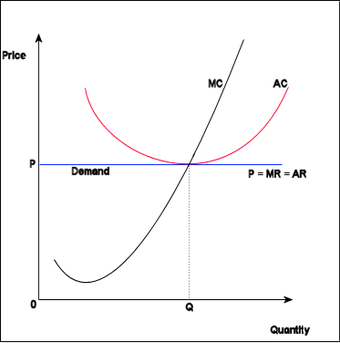
Perfect Competition Economics
This is a graphical illustration of economics within the context of a perfectly competitive market (theoretically). Note that the overall returns derived, costs incurred, quantity produced, and price point all align perfectly to generate an equitable market position. While this is an idealistic representation of markets, it is useful as a frame of reference to identify departures from ideal competitive circumstances.
However, perfect competition is more of a theoretical competitive framework because markets will naturally deviate to varying degrees (in order to capture profitable returns). As such, the perfect competition model is most useful in identifying and measuring deviations or departures from the competitive ideal. The farther an industry or market moves from a perfectly competitive model the more value is potentially migrating from the consumers to the suppliers. In order to ensure that suppliers do not take on too much power (such as the case of monopolies and oligopolies), government regulations and antitrust laws are a necessary component of the economic perspective.
Societal Risks of Monopolies
The accumulation of power and leverage on behalf of the suppliers largely revolves around the fact that monopolies can ultimately control supply in its entirety for a specified product or service. Through utilizing this control strategically, a profit-maximizing monopoly could create the following societal risks:
- Price Discrimination:This concept is often strongly emphasized as a potential economic risk of monopolies and the economic justification is easily illustrated. Picture a supply and demand chart, where supply and demand intersect to generate a fair price point and overall quantity provided. Now assume one company has the entire supply under it’s control, and can discriminate prices along the demand curve to capture higher prices than the available supply should allow. This allows monopolies to charge customers with a higher willingness to pay a higher price, while still charging consumers with a lower willingness to pay the standard prices. This is unfair to consumers, who will be forced to pay whatever is asked as a result of no alternative options.
- Reduced Efficiency: A less direct societal risk of monopolies is the fact that competition is closely linked to incentives. As a result, no competition will provide the monopoly very little reason to improve internal inefficiencies or cut costs. A competitive market will see constant strives to reduce costs in order to capture higher market share and provide goods at lower prices, while monopolies do not have this incentive.
- Reduced Innovation: A monopoly will also have limited motivation to innovate, as there is little value in differentiation in a thoroughly controlled market (for the only incumbent). As a result there is reduced improvements that could substantially improve the ability of the firm to fulfill the needs of the consumer.
- Deadweight Loss: A monopoly will choose to produce less and charge more than would occur in a perfectly competitive market. As a result, a monopoly causes deadweight loss, an inefficient economic outcome.
In summarizing these various societal drawbacks, monopolies pose the risk of reducing consumer choice and consumer power to incentivize companies to innovate and reduce costs, as there is limited prospective returns on investment. A monopoly with total control over the supply can charge any price that the consumer is willing to pay, and therefore can generate excessive margins while doing very little to improve their product/service or relevant processes.
11.6.2: Antitrust Laws
Antitrust laws ensure that competitive environments are preserved in order to maintain an efficient and equitable capitalistic system.
Learning Objective
Discuss antitrust laws aimed to improve competition and prevent monopolies from becoming more powerful
Key Points
- The concept of antitrust largely revolves around governmental restrictions that limit incumbents in any given industry from consolidating too much power.
- Organizations such as the World Trade Organization (WTO) attempt to garner international support for the establishment of global standards in competitive markets in conjunction with the internal competitive laws which govern each nation individually.
- In the U.S., antitrust policy finds its roots in 1890 with the Sherman Antitrust Act, and saw substantial expansion in 1914 via the Clayton Antitrust Act and the Federal Trade Commission Act.
- As capitalistic markets evolve they show some tendency towards consolidation, and this consolidation puts consumers at risk of hugely powerful corporate suppliers. Antitrust policy is designed to intervene on behalf of the consumer.
- As capitalistic markets evolve they show some tendency towards consolidation, and this consolidation puts consumers at risk of hugely powerful corporate suppliers. Antitrust policy is designed to intervene on behalf of the consumer.
Key Terms
- Antitrust
-
A law opposed to or against the establishment or existence of trusts (monopolies), usually referring to legislation.
- monopoly
-
A situation, by legal privilege or other agreement, in which solely one party (company, cartel etc. ) exclusively provides a particular product or service, dominating that market and generally exerting powerful control over it.
- consolidation
-
The combination of multiple businesses.
Example
- There are a wide range of real-life examples of monopolies, though few more famous than Microsoft. Microsoft, through the effective strategic design and sale of their operating platform, attained a monopolistic hold on the computer industry. While 2001 marks the date Microsoft officially began dismantling their competitive monopoly on the market, the trial itself began in 1998 and the governmental investigations began as early as 1991. This process, though long and arduous, was enabled by the Sherman Act and Federal Trade Commission Act and substantially improved the competitive nature of the computer industry.
Antitrust laws perform the critical task of ensuring that competitive environments are preserved in order to maintain an efficient and equitable capitalistic system for firms to operate in. The concept of antitrust largely revolves around governmental restrictions that limit incumbents in any given industry from consolidating too much power.
The worst case scenario of consolidation results in a monopoly, which is when one company or organization becomes the sole supplier of a given product or service. In such a situation it is relatively easy for that provider to erect barriers to entry for new entrants and dictate price points through manipulating the supply. The adverse effects of these manipulations can be seen in , which underlines the economic threat monopolies pose the end consumer. Antitrust law is in place to ensure such circumstances do not arise, or when they do that they are regulated appropriate to minimize adverse societal effects.

Monopolistic Effects on Price
This graph illustrates the way in which monopolistic incumbents can control economic factors, ultimately creating surpluses or shortages to garner advantage.
Regulating Competition
The regulation of competitive markets has roots as far back as the Roman Empire, resulting in increasingly complex models as capitalism has evolved over time. Indeed, due to the increasingly international focus for many large corporations, antitrust laws and other competitive regulations must function not only at the country level but on a global level. Organizations such as the World Trade Organization (WTO) attempt to garner international support for the establishment of global standards in competitive markets in conjunction with the internal competitive laws which govern each nation individually. While these antitrust laws differ from nation to nation, they can loosely be summarized in three components:
- Actively ensuring that no agreements in place are counter to a competitive market. This revolves largely around avoiding cartels, or collaboration between the big players which would allow for market manipulation.
- Regulating against strategic actions that may result in diminishing the competitive elements of a market. This is usually targeted at dominate players in an industry, who may have a tendency to price gauge or other manipulations.
- Overseeing mergers, acquisitions, joint ventures and other strategic alliances to avoid consolidation that may be damaging to free markets.
Relevant Statutes
European Union (EU) – In the EU, competition law began in 1951 with the European Coal and Steel Community (ECSC), which included France, Italy, Belgium and the Netherlands. The purpose of this was to reduce the ability for one country/region to gain a monopoly on critical natural resources. Shortly after, in 1957, the European Economic Community (ECC) was established as a part of the Treaty of Rome. This document enacted provisions to eliminate anti-competitive agreements. This was more recently updated via the Treaty of Lisbon, which further addresses mergers and acquisitions and bans price fixing and collusion.
United States (U.S.) – In the U.S., antitrust policy finds its roots in 1890 with the Sherman Antitrust Act. While the basic premise was the same as modern day competitive law, it was fairly rudimentary in scale and scope. The Sherman Act dealt with avoiding or limiting the power of trusts, or essentially the creation of price-controlling cartels. This act was expanded upon in 1914, with two more competitive laws: The Clayton Antitrust Act and the Federal Trade Commission Act. Both of these acts sought to organize a governmental body equipped to protect consumers from unfair competitive practices.
11.6.3: Regulation of Natural Monopoly
Natural monopolies are conducive to industries where the largest supplier derives cost advantages and must be regulated to minimize risks.
Learning Objective
Discuss the reasons for government regulation of monopolies
Key Points
- A natural monopoly is defined by an incumbent in an industry where the largest supplier can theoretically create the lowest production prices, generally through economies of scale or economies of scope.
- Natural monopolistic conditions are therefore at high risk of creating actual monopolies, and society benefits from regulating these situations to even the playing field.
- Regulating industries to minimize monopolization and maintain competitive equality can be pursued through average cost pricing, price ceilings, rate of return regulations, taxes and subsidies.
- While the concept of a monopoly is generally perceived as a threat to free markets, there are specific circumstances where natural monopolies are either pragmatically useful (cost effective) or virtually unavoidable.
Key Terms
- economies of scale
-
The characteristics of a production process in which an increase in the scale of the firm causes a decrease in the long run average cost of each unit.
- subsidy
-
Government assistance to a business or economic sector.
A monopoly is a business or organization that maintains exclusivity of the supply of a particular product or service, and can evolve naturally or be designed specifically based on the nature of a particular market or industry. Monopolies on the whole are governed under antitrust laws, both on a national level in most countries and on an international level via institutions such as the World Trade Organization (WTO).
The evolution of a monopoly is a critical component in recognizing which industries are at high risk of monopolization, and how these risks may be realized operationally. A natural monopoly is defined by an incumbent in an industry where the largest supplier can theoretically create the lowest production prices, generally through economies of scale or economies of scope . In this type of circumstance, the industry naturally lends itself to providing advantages for the single largest provider at the cost of allowing for competitive forces. Natural monopolistic conditions are therefore at high risk of creating actual monopolies, and society benefits from regulating these situations to even the playing field.
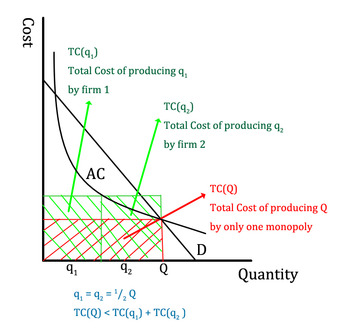
Price Advantage for Natural Monopolies
While monopolies are generally poor economic constructs for creating value, natural monopolies are predicated on the fact that a single supplier can achieve the greatest economies of scale (cost advantages). This graph demonstrates this concept.
Regulating Natural Monopolies
The consolidation of an industry into one sole supplier can represent a substantial threat to free markets and their consumers, as price can be easily manipulated through a thorough control of the supply. As a result, monopolies are generally viewed as illegal entities. Regulating industries to minimize monopolization and maintain competitive equality can be pursued in a number of ways:
- Average cost pricing: As the name implies, this regulatory approach is defined as enforcing a price point for a given product or service that matches the overall costs incurred by the company producing or providing. This reduces the pricing flexibility of a company and ensures that the monopoly cannot capture margins above and beyond what is reasonable.
- Price ceiling:Another way a natural monopoly may be regulated is through the enforcement of a maximum potential price being charged. A price ceiling is a regulatory strategy of stating a specific product or service cannot be sold for above a certain price.
- Rate of return regulations: This is quite similar to average cost pricing, but deviates via allowing a model that can create consistent returns for the company involved. The percentage net profit brought in a by company must be below a government specified percentage to insure compliance with this regulatory approach (i.e. 5%).
- Tax or subsidy:The last way a governmental body can alleviate a natural monopoly is through higher taxes on larger players or subsidies for smaller players. In short, the government can provide financial support via subsidies to new entrants to ensure the competitive environment is more equitable.
As with most regulatory approaches, none of these are perfect solutions and consolidation within industries conducive to a natural monopoly will continue to arise. Antitrust laws and the careful control of mergers, acquisitions, joint ventures, and other strategic alliances are critical in the regulation of natural monopolies. In extreme circumstances it is also a viable option for governments to break up monopolies through the legal processes.
When A Monopoly Works
While the concept of a monopoly is generally perceived as a threat to free markets, there are specific circumstances where natural monopolies are either pragmatically useful (cost effective) or virtually unavoidable. In these circumstances the regulatory approaches above (price ceilings, average cost pricing, etc.) are even more critical to ensuring consumers are protected. AT&T is a classic example of a government-backed monopoly in the middle of the 20th century, as the fixed investment of land lines for phones at that time was substantial. It was not practical to foster competition as a result, and the government recognized the necessity for a monopoly (until 1984, when AT&T was divested).
Chapter 10: Competitive Markets
10.1: Perfect Competition
10.1.1: Definition of Perfect Competition
Perfect competition is a market structure that leads to the Pareto-efficient allocation of economic resources.
Learning Objective
Describe degrees of competition in different market structures
Key Points
- The major types of market structure include monopoly, monopolistic competition, oligopoly, and perfect competition.
- Perfect competition is an industry structure in which there are many firms producing homogeneous products. None of the firms are large enough to influence the industry.
- The characteristics of a perfectly competitive market include insignificant contributions from the producers, homogenous products, perfect information about products, no transaction costs, and no long-term economic profits.
- In practice, very few industries can be described as perfectly competitive, though agriculture comes close.
Key Terms
- oligopoly
-
An economic condition in which a small number of sellers exert control over the market of a commodity.
- Monopolistic competition
-
A market structure in which there is a large number of firms, each having a small proportion of the market share and slightly differentiated products.
- monopoly
-
A situation, by legal privilege or other agreement, in which solely one party (company, cartel etc. ) exclusively provides a particular product or service, dominating that market and generally exerting powerful control over it.
Market structure is determined by the number and size distribution of firms in a market, entry conditions, and the extent of product differentiation. The major types of market structure include the following:
- Monopoly: An industry structure where a single firm produces a product for which there are no close substitutes. Monopolists are price makers. Barriers to entry and exit exist, and, in order to ensure profits, a monopoly will attempt to maintain them.
- Monopolistic competition: A market structure in which there is a large number of firms, each having a small portion of the market share and slightly differentiated products. There are close substitutes for the product of any given firm, so competitors have slight control over price. There are relatively insignificant barriers to entry or exit, and success invites new competitors into the industry.
- Oligopoly: An industry structure in which there are a few firms producing products that range from slightly differentiated to highly differentiated. Each firm is large enough to influence the industry. Barriers to entry exist.
- Perfect competition: An industry structure in which there are many firms, none large enough to influence the industry, producing homogeneous products. Firms are price takers. There are no barriers to entry. Agriculture comes close to being perfectly competitive.
Perfect competition leads to the Pareto-efficient allocation of economic resources. Because of this it serves as a natural benchmark against which to contrast other market structures. However, in practice, very few industries can be described as perfectly competitive. Nevertheless, it is used because it provides important insights.
A perfectly competitive market has several important characteristics:
- All producers contribute insignificantly to the market. Their own production levels do not change the supply curve.
- All producers are price takers. They cannot influence the market. If a firm tries to raise its price consumers would buy from a competitor with a lower price instead.
- Products are homogeneous. The characteristics of a good or service do not vary between suppliers.
- Producers enter and exit the market freely.
- Both buyers and sellers have perfect information about the price, utility, quality, and production methods of products.
- There are no transaction costs. Buyers and sellers do not incur costs in making an exchange of goods in a perfectly competitive market.
- Producers earn zero economic profits in the long run.
10.1.2: Conditions of Perfect Competition
A firm in a perfectly competitive market may generate a profit in the short-run, but in the long-run it will have economic profits of zero.
Learning Objective
Calculate total revenue, average revenue, and marginal revenue for a firm in a perfectly competitive market
Key Points
- A perfectly competitive market is characterized by many buyers and sellers, undifferentiated products, no transaction costs, no barriers to entry and exit, and perfect information about the price of a good.
- The total revenue for a firm in a perfectly competitive market is the product of price and quantity (TR = P * Q). The average revenue is calculated by dividing total revenue by quantity. Marginal revenue is calculated by dividing the change in total revenue by change in quantity.
- A firm in a competitive market tries to maximize profits. In the short-run, it is possible for a firm’s economic profits to be positive, negative, or zero. Economic profits will be zero in the long-run.
- In the short-run, if a firm has a negative economic profit, it should continue to operate if its price exceeds its average variable cost. It should shut down if its price is below its average variable cost.
Key Term
- economic profit
-
The difference between the total revenue received by the firm from its sales and the total opportunity costs of all the resources used by the firm.
The concept of perfect competition applies when there are many producers and consumers in the market and no single company can influence the pricing. A perfectly competitive market has the following characteristics:
- There are many buyers and sellers in the market.
- Each company makes a similar product.
- Buyers and sellers have access to perfect information about price.
- There are no transaction costs.
- There are no barriers to entry into or exit from the market.
All goods in a perfectly competitive market are considered perfect substitutes, and the demand curve is perfectly elastic for each of the small, individual firms that participate in the market. These firms are price takers–if one firm tries to raise its price, there would be no demand for that firm’s product. Consumers would buy from another firm at a lower price instead.
Firm Revenues
A firm in a competitive market wants to maximize profits just like any other firm. The profit is the difference between a firm’s total revenue and its total cost. For a firm operating in a perfectly competitive market, the revenue is calculated as follows:
- Total Revenue = Price * Quantity
- AR (Average Revenue) = Total Revenue / Quantity
- MR (Marginal Revenue) = Change in Total Revenue / Change in Quantity
The average revenue (AR) is the amount of revenue a firm receives for each unit of output. The marginal revenue (MR) is the change in total revenue from an additional unit of output sold. For all firms in a competitive market, both AR and MR will be equal to the price.
Profit Maximization
In order to maximize profits in a perfectly competitive market, firms set marginal revenue equal to marginal cost (MR=MC). MR is the slope of the revenue curve, which is also equal to the demand curve (D) and price (P). In the short-term, it is possible for economic profits to be positive, zero, or negative . When price is greater than average total cost, the firm is making a profit. When price is less than average total cost, the firm is making a loss in the market.

Perfect Competition in the Short Run
In the short run, it is possible for an individual firm to make an economic profit. This scenario is shown in this diagram, as the price or average revenue, denoted by P, is above the average cost denoted by C .
Over the long-run, if firms in a perfectly competitive market are earning positive economic profits, more firms will enter the market, which will shift the supply curve to the right. As the supply curve shifts to the right, the equilibrium price will go down. As the price goes down, economic profits will decrease until they become zero.
When price is less than average total cost, firms are making a loss. Over the long-run, if firms in a perfectly competitive market are earning negative economic profits, more firms will leave the market, which will shift the supply curve left. As the supply curve shifts left, the price will go up. As the price goes up, economic profits will increase until they become zero.
In sum, in the long-run, companies that are engaged in a perfectly competitive market earn zero economic profits . The long-run equilibrium point for a perfectly competitive market occurs where the demand curve (price) intersects the marginal cost (MC) curve and the minimum point of the average cost (AC) curve.

Perfect Competition in the Long Run
In the long-run, economic profit cannot be sustained. The arrival of new firms in the market causes the demand curve of each individual firm to shift downward, bringing down the price, the average revenue and marginal revenue curve. In the long-run, the firm will make zero economic profit. Its horizontal demand curve will touch its average total cost curve at its lowest point.
10.1.3: The Demand Curve in Perfect Competition
A perfectly competitive firm faces a demand curve is a horizontal line equal to the equilibrium price of the entire market.
Learning Objective
Describe the demand for goods in perfectly competitive markets
Key Points
- In a perfectly competitive market individual firms are price takers. The price is determined by the intersection of the market supply and demand curves.
- The demand curve for an individual firm is different from a market demand curve. The market demand curve slopes downward, while the firm’s demand curve is a horizontal line.
- The firm’s horizontal demand curve indicates a price elasticity of demand that is perfectly elastic.
Key Term
- Perfectly elastic
-
Describes a situation when any increase in the price, no matter how small, will cause demand for a good to drop to zero.
In a perfectly competitive market the market demand curve is a downward sloping line, reflecting the fact that as the price of an ordinary good increases, the quantity demanded of that good decreases. Price is determined by the intersection of market demand and market supply; individual firms do not have any influence on the market price in perfect competition. Once the market price has been determined by market supply and demand forces, individual firms become price takers. Individual firms are forced to charge the equilibrium price of the market or consumers will purchase the product from the numerous other firms in the market charging a lower price (keep in mind the key conditions of perfect competition). The demand curve for an individual firm is thus equal to the equilibrium price of the market .
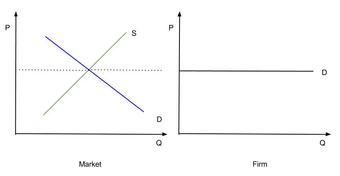
Demand Curve for a Firm in a Perfectly Competitive Market
The demand curve for an individual firm is equal to the equilibrium price of the market. The market demand curve is downward-sloping.
The demand curve for a firm in a perfectly competitive market varies significantly from that of the entire market.The market demand curve slopes downward, while the perfectly competitive firm’s demand curve is a horizontal line equal to the equilibrium price of the entire market. The horizontal demand curve indicates that the elasticity of demand for the good is perfectly elastic. This means that if any individual firm charged a price slightly above market price, it would not sell any products.
A strategy often used to increase market share is to offer a firm’s product at a lower price than the competitors. In a perfectly competitive market, firms cannot decrease their product price without making a negative profit. Instead, assuming that the firm is a profit-maximizer, it will sell its goods at the market price.
10.2: Production Decisions in Perfect Competition
10.2.1: Relationship Between Output and Revenue
Output is the amount of a good produced; revenue is the amount of income made from sales minus all business expenses.
Learning Objective
Describe the relationship between output and revenue
Key Points
- In economics, output is defined as the quantity of goods or services produce in a certain period of time by a firm, industry, or country. Output can be consumed or used for further production.
- Revenue, also known as turnover, is the income that a company receives from normal business activities, usually from the sale of goods and services. Companies can also receive revenue from interest, royalties, and other fees.
- The performance of a company is determined by how its asset inflows (revenues) compare with its asset outflows (expenses). Revenue is a direct indication of earning quality.
Key Terms
- revenue
-
The total income received from a given source.
- output
-
Production; quantity produced, created, or completed.
Output
In economics, output is defined as the quantity of goods or services produced in a certain period of time by a firm, industry, or country. Output can be consumed or used for further production. Output is important on a business and national scale because it is output, not large sums of money, that makes a company or country wealthy.
There are many factors that influence the level of output including changes in labor, capital, and the efficiency of the factors of production. Anything that causes one of the factors to increase or decrease will change the output in the same manner.
Revenue
Revenue, also known as turnover, is the income that a company receives from normal business activities, usually from the sale of goods and services. Revenue is the money that is made as a result of output, or amount of goods produced. Companies can also receive revenue from interest, royalties, and other fees.
Revenue can refer to general business income, but it can also refer to the amount of money made during a specific time period. When companies produce a certain quantity of a good (output), the revenue is the amount of income made from sales during a set time period.
Businesses analyze revenue in their financial statements. The performance of a company is determined by how its asset inflows (revenues) compare with its asset outflows (expenses). Revenue is an important financial indiator, though it is important to note that companies are profit maximizers, not revenue maximizers.
Importance of Output and Revenue
In order for a company or firm to be successful, it must focus on both the output and revenue. The quantity of goods produced must meet public demand, but the company must also be able to sell those goods in order to generate revenue. The production of goods carries a cost, so companies want to find a level of output that maximizes profit, not revenue .

Output and Revenue
Krispy Kreme’s output is donuts. It generates revenue by selling its output. It is however, a profit maximizer, not an output or revenue maximizer.
10.2.2: Marginal Cost Profit Maximization Strategy
In order to maximize profit, the firm should set marginal revenue (MR) equal to the marginal cost (MC).
Learning Objective
Calculate marginal costs and marginal revenues
Key Points
- Marginal cost is the increase in total cost from producing one additional unit.
- The marginal revenue is the increase in revenue from the sale of one additional unit.
- One way to determine how to generate the largest profit is to use the marginal revenue-marginal cost perspective. This strategy is based on the fact that the total profit reaches its maximum point where marginal revenue equals marginal profit.
Key Terms
- marginal cost
-
The increase in cost that accompanies a unit increase in output; the partial derivative of the cost function with respect to output. Additional cost associated with producing one more unit of output.
- marginal revenue
-
The additional profit that will be generated by increasing product sales by one unit.
Marginal Cost
Marginal cost is the change in the total cost that occurs when the quantity produced is increased by one unit . It is the cost of producing one more unit of a good. When more goods are produced, the marginal cost includes all additional costs required to produce the next unit. For example, if producing one more car requires the building of an additional factory, the marginal cost of producing the additional car includes all of the costs associated with building the new factory.

Marginal cost curve
This graph shows a typical marginal cost (MC) curve with marginal revenue (MR) overlaid.
Marginal cost is the change in total cost divided by the change in output.
An example of marginal cost is evident when the cost of making one pair of shoes is $30. The cost of making two pairs of shoes is $40. Therefore the marginal cost of the second shoe is $40 -$30=$10.
Marginal Revenue
Marginal revenue is the additional revenue that will be generated by increasing product sales by one unit. In a perfectly competitive market, the price of the product stays the same when another unit is produced. Marginal revenue is calculated by dividing the change in total revenue by the change in output quantity.
For example, if the price of a good in a perfectly competitive market is $20, the marginal revenue of selling one additional unit is $20.
Marginal Cost-Marginal Revenue Perspective
Profit maximization is the short run or long run process by which a firm determines the price and output level that will result in the largest profit. Firms will produce up until the point that marginal cost equals marginal revenue. This strategy is based on the fact that the total profit reaches its maximum point where marginal revenue equals marginal profit . This is the case because the firm will continue to produce until marginal profit is equal to zero, and marginal profit equals the marginal revenue (MR) minus the marginal cost (MC).

Marginal profit maximization
This graph shows profit maximization using the marginal cost perspective.
Another way of thinking about the logic is of producing up until the point of MR=MC is that if MR>MC, the firm should make more units: it is earning a profit on each. If MR<MC, then the firm should produce less: it is making a loss on each additional product it sells.
10.2.3: Shut Down Case
A firm will implement a production shutdown if the revenue from the sale of goods produced cannot cover the variable costs of production.
Learning Objective
Apply shutdown conditions to determine a firm’s production status
Key Points
- Economic shutdown occurs within a firm when the marginal revenue is below average variable cost at the profit-maximizing output.
- When a shutdown is required the firm failed to achieve a primary goal of production by not operating at the level of output where marginal revenue equals marginal cost.
- If the revenue the firm is making is greater than the variable cost (R>VC) then the firm is covering it’s variable costs and there is additional revenue to partially or entirely cover the fixed costs.
- If the variable cost is greater than the revenue being made (VC>R) then the firm is not even covering production costs and it should be shutdown.
- The decision to shutdown production is usually temporary. If the market conditions improve, due to prices increasing or production costs falling, then the firm can resume production.
- When a shutdown last for an extended period of time, a firm has to decide whether to continue to business or leave the industry.
Key Terms
- marginal cost
-
The increase in cost that accompanies a unit increase in output; the partial derivative of the cost function with respect to output. Additional cost associated with producing one more unit of output.
- marginal revenue
-
The additional profit that will be generated by increasing product sales by one unit.
- variable cost
-
A cost that changes with the change in volume of activity of an organization.
Economic Shutdown
A firm will choose to implement a production shutdown when the revenue received from the sale of the goods or services produced cannot cover the variable costs of production. In this situation, a firm will lose more money when it produces goods than if it does not produce goods at all. Producing a lower output would only add to the financial losses, so a complete shutdown is required. If a firm decreased production it would still acquire variable costs not covered by revenue as well as fixed costs (costs inevitably incurred). By stopping production the firm only loses the fixed costs .

Shutdown Condition
Firms will produce as long as marginal revenue (MR) is greater than average total cost (ATC), even if it is less than the variable, or marginal cost (MC)
Economic shutdown occurs within a firm when the marginal revenue is below average variable cost at the profit-maximizing output. The goal of a firm is to maximize profits and minimize losses. When a shutdown is required the firm failed to achieve a primary goal of production by not operating at the level of output where marginal revenue equals marginal cost.
The Shutdown Rule
In the short run, a firm that is operating at a loss (where the revenue is less that the total cost or the price is less than the unit cost) must decide to operate or temporarily shutdown. The shutdown rule states that “in the short run a firm should continue to operate if price exceeds average variable costs. “
When determining whether to shutdown a firm has to compare the total revenue to the total variable costs. If the revenue the firm is making is greater than the variable cost (R>VC) then the firm is covering it’s variable costs and there is additional revenue to partially or entirely cover the fixed costs. One the other hand, if the variable cost is greater than the revenue being made (VC>R) then the firm is not even covering production costs and it should be shutdown immediately.
Implications of a Shutdown
The decision to shutdown production is usually temporary. It does not automatically mean that a firm is going out of business. If the market conditions improve, due to prices increasing or production costs falling, then the firm can resume production. Shutdowns are short run decisions. When a firm shuts down it still retains capital assets, but cannot leave the industry or avoid paying its fixed costs.
A firm cannot incur losses indefinitely which impacts long run decisions. When a shutdown last for an extended period of time, a firm has to decide whether to continue to business or leave the industry. The decision to exit is made over a period of time. A firm that exits an industry does not earn any revenue, but is also does not incur fixed or variable costs.
10.2.4: The Supply Curve in Perfect Competition
The total revenue-total cost perspective and the marginal revenue-marginal cost perspective are used to find profit maximizing quantities.
Learning Objective
Use cost curves to find profit-maximizing quantities
Key Points
- In a free market economy, firms use cost curves to find the optimal point of production (minimizing cost).
- Profit maximization is the process that a firm uses to determine the price and output level that returns the greatest profit when producing a good or service.
- The total revenue-total cost perspective recognizes that profit is equal to the total revenue (TR) minus the total cost (TC).
- The marginal revenue-marginal cost perspective relies on the understanding that for each unit sold, the marginal profit equals the marginal revenue (MR) minus the marginal cost (MC).
Key Terms
- marginal revenue
-
The additional profit that will be generated by increasing product sales by one unit.
- Total Revenue
-
The profit from each item multiplied by the number of items sold.
Cost Curve
In economics, a cost curve is a graph that shows the costs of production as a function of total quantity produced. In a free market economy, firms use cost curves to find the optimal point of production (minimizing cost). By locating the optimal point of production, firms can decide what output quantities are needed. The various types of cost curves include total, average, marginal curves. Some of the cost curves analyze the short run, while others focus on the long run.
Profit Maximization
Profit maximization is the short run or long run process that a firm uses to determine the price and output level that returns the greatest profit when producing a good or service.
Graphing Profit Maximization
There are two ways in which cost curves can be used to find profit maximizing quantities: the total revenue-total cost perspective and the marginal revenue-marginal cost perspective.
The total revenue-total cost perspective recognizes that profit is equal to the total revenue (TR) minus the total cost (TC). When a table of costs and revenues is available, a firm can plot the data onto a profit curve. The profit maximizing output is the one at which the profit reaches its maximum .

Total cost curve
This graph depicts profit maximization on a total cost curve.
The marginal revenue-marginal cost perspective relies on the understanding that for each unit sold, the marginal profit equals the marginal revenue (MR) minus the marginal cost (MC). If the marginal revenue is greater than the marginal cost, then the marginal profit is positive and a greater quantity of the good should be produced. Likewise, if the marginal revenue is less than the marginal cost, the marginal profit is negative and a lesser quantity of the good should be produced .

Marginal cost curve
This graph shows profit maximization using a marginal cost curve.
Profit maximization is directly impacts the supply and demand of a product. Supply curves are used to show an estimation of variables within a market economy, one of which is the general price level of the product.
10.2.5: Short Run Firm Production Decision
The short run is the conceptual time period where at least one factor of production is fixed in amount while other factors are variable.
Learning Objective
Compare factors that lead to short-run shut downs or long-run exits
Key Points
- Fixed costs have no impact on a firm’s short run decisions. However, variable costs and revenues affect short run profits.
- When a firm is transitioning from short run to long run it will consider the current and future equilibrium for supply and demand.
- A firm will implement a production shutdown when the revenue coming in from the sale of goods cannot cover the variable costs of production.
- A short run shutdown is designed to be temporary. When a firm is shutdown for the short run, it still has to pay fixed costs and cannot leave the industry. However, a firm cannot incur losses indefinitely. Exiting an industry is a long term decision.
Key Terms
- variable cost
-
A cost that changes with the change in volume of activity of an organization.
- profit
-
Total income or cash flow minus expenditures. The money or other benefit a non-governmental organization or individual receives in exchange for products and services sold at an advertised price.
- shutdown
-
The action of stopping operations; a closing, of a computer, business, event, etc.
Short Run Profit
In an economic market all production in real time occurs in the short run. The short run is the conceptual time period where at least one factor of production is fixed in amount while other factors are variable in amount. Fixed costs have no impact on a firm’s short run decisions. However, variable costs and revenues affect short run profits. In the short run, a firm could potentially increase output by increasing the amount of the variable factors. An example of a variable factor being increased would be increasing labor through overtime.
In the short run, a firm that is maximizing its profits will:
- Increase production if the marginal cost is less than the marginal revenue.
- Decrease production if marginal cost is greater than marginal revenue.
- Continue producing if average variable cost is less than price per unit.
- Shut down if average variable cost is greater than price at each level of output.
Transition from Short Run to Long Run Profit
When a firm is transitioning from the short run to the long run it will consider the current and future equilibrium for supply and demand. The firm will also take adjustments into account that can disturb equilibrium such as the sales tax rate. The transition involves analyzing the current state of the market as well as revenue and combining the results with long run market projections.
Short Run Shutdown vs. Long Run Exit
The goal of a firm is to maximize profits by minimizing losses. In economics, a firm will implement a production shutdown when the revenue coming in from the sale of goods cannot cover the variable costs of production. The firm would experience higher loss if it kept producing goods than if it stopped production for a period of time. Revenue would not cover the variable costs associated with production. Instead, during a shutdown the firm is only paying the fixed costs.
A short run shutdown is designed to be temporary: it does not mean that the firm is going out of business. If market conditions improve, due to prices increasing or production costs falling, the firm can restart production. When a firm is shut down in the short run, it still has to pay fixed costs and cannot leave the industry. However, a firm cannot incur losses indefinitely. Exiting an industry is a long term decision. If market conditions do not improve a firm can exit the market. By exiting the industry, the firm earns no revenue but incurs no fixed or variable costs.
Short Run Supply Curve
In a perfectly competitive market, the short run supply curve is the marginal cost (MC) curve at and above the shutdown point. The portions of the marginal cost curve below the shutdown point are no part of the supply curve because the firm is not producing in that range. The short run supply curve is used to graph a firm’s short run economic state .

Short run supply curve
This graph shows a short run supply curve in a perfect competitive market. The short run supply curve is the marginal cost curve at and above the shutdown point. The portions of the marginal cost curve below the shutdown point are not part of the supply curve because the firm is not producing in that range.
10.3: Long-Run Outcomes
10.3.1: Long Run Supply Decisions
The long-run supply curve in a perfectly competitive market has three parts; a downward sloping curve, a flat portion, and an upwards sloping curve.
Learning Objective
Describe the long-run market supply curve of a perfectly competitive market
Key Points
- The long-run supply curves of a market is the sum of a series of that market’s short-run supply curves.
- Most supply curves are composed of three periods of production: a period of increasing returns to scale, constant returns to scale, and decreasing returns to scale.
- A long-run supply curve connects the points of constant returns to scales of a markets’ short-run supply curves.
Key Terms
- constant returns to scale
-
Changes in output resulting from a proportional change in all inputs (where all inputs increase by a constant factor). If output increases by that same proportional change then there are constant returns to scale (CRS).
- decreasing returns to scale
-
Changes in output resulting from a proportional change in all inputs (where all inputs increase by a constant factor). If output increases by less than the proportional change then there are decreasing returns to scale.
- increasing returns to scale
-
The characteristic of production in which output increases by more than the proportional increase in inputs.
The long-run supply curve of a market is the sum of a series of short-run supply curves in the market (). Prior to determining how the long-run supply curve looks, its important to understand short-run supply curves.
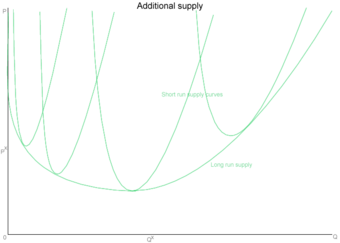
Long-run Supply Curve
As the chart demonstrates, a market’s long-run supply curve is the sum of a series of short-run supply curves in a given market.
Short-Run Supply Curves
While most people focus on the second half of a supply curve, which has a positive slope, that is not how the supply and pricing decision works in practice. As you can see from the chart, the first items that are produced start out with a very high price. This is because it is very expensive for a producer to manufacture one item. The producer has to incur fixed costs, such as learning the necessary skills to produce the item and purchasing new tools. These initial fixed costs make the cost of producing one good very expensive.
However, as more goods are produced, those initial fixed costs are spread out over more items. This decreases the price of per unit of each good produced for a period of time. As a result, in the early stages of production the supply curve is sloping downward as you can see in the chart. This period of supply is known as “increasing returns to scale,” because a proportional increase in resources yields a greater proportional increase in output.
At some point, the per unit share of fixed costs becomes less than the variable costs of producing one more item. Variable expenses include purchasing more raw materials to manufacture another item. When this occurs, the supply curve slopes upward. Thus, in the short-run, a market’s supply curve looks like an oddly shaped “u.” This period of supply is known as “decreasing returns to scale,” because a proportional increase in resources yields a smaller proportional increase in its amount in output. Between these two periods is the “constant returns to scale,” where a proportion increase in resources yields an equal proportional increase in the amount of output.
Long-Run Supply Curves
A market’s long-run supply curve is the sum of the market’s short-run supply curves taken at different points of time. As a result, a long-run supply curve for a market will look very similar to short-run supply curves for a market, but more stretched out; the long-term market curve will a wider “u.” A long-run supply curve connects the points of constant returns to scales of a markets’ short-run supply curves. ; the bottom of each short-term supply curve’s “u.” Consider the attached chart.
The first short-run supply curve reflects what happens when a firm enters into a new market for the first time. When it does, it should make an economic profit. In a perfectly competitive market, firms can freely enter and exit an industry. When other business notice that the first firm is making it profit, they will enter the market to capture some of that profit and because there is nothing preventing them from doing so. In the early stages of the market, where only one or a few firms are producing goods, the market experiences increasing returns to scale, similar to what an individual firm would experience.
As more firms enter the market and time passes, production yields less and less returns in comparison to the production. Eventually the market reaches a state of constant returns to scale. How long this period of constant returns is varies by industry. Agriculture has a longer period of constant returns while technology has shorter.
Eventually, production of goods in a market yields less of a return than the amount of goods that go into product, which causes the market to enter into a period of decreasing returns to scale and the market’s supply curve slopes upward.
10.3.2: Long Run Market Equilibrium
The long-run equilibrium of a perfectly competitive market occurs when marginal revenue equals marginal costs, which is also equal to average total costs.
Learning Objective
Describe the long-run market equilibrium
Key Points
- In a perfectly competitive market, demand is perfectly elastic. This means the demand curve is a horizontal line.
- Once equilibrium has been achieved, firms in a perfectly competitive market can’t achieve economic profit; it can only break even.
- A perfectly competitive market in equilibrium is productively and allocatively efficient.
Key Term
- long-run
-
The conceptual time period in which there are no fixed factors of production.
The long-run is the period of time where there are no fixed variables of production. As with any other economic equilibrium, it is defined by demand and supply.
Demand
In a perfect market, demand is perfectly elastic . The demand curve also represents marginal revenue, which is important to remember later when we calculate quantity supplied. That means regardless of how much is produced by the suppliers, the price will remain constant.
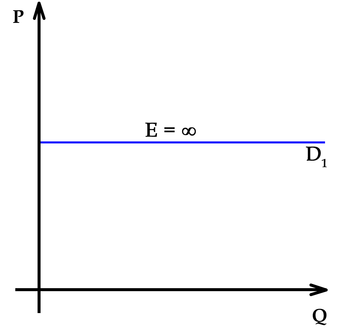
Perfectly Elastic Demand
In a perfectly competitive market, demand is perfectly elastic.
Supply
In a perfectly competitive market, it is assumed that all of the firms participating in production are trying to maximize their profits. So a firm will produce goods until the marginal costs of production equal the marginal revenues from sales. In a perfectly competitive market in the long-term, this is taken one step further. In a perfectly competitive market, long-run equilibrium will occur when the marginal costs of production equal the average costs of production which also equals marginal revenue from selling the goods. So the equilibrium will be set, graphically, at a three-way intersection between the demand, marginal cost and average total cost curves.
Repercussions of Equilibrium
A perfectly competitive market in equilibrium has several important characteristics.
- Firms can’t make economic profit; the best they can do is break even so that their revenues equals their costs.
- The market is productively and allocatively efficient. This means that not only is the market using all of its resources efficiently, it is using its resources in a way that maximizes the social welfare.
- Economic surplus is maximized, which means there is no deadweight loss. Attempting to improve the conditions of one group would harm the interests of the other.
10.3.3: Productive Efficiency
Productive efficiency occurs when production of a good is achieved at the lowest resource cost possible, given the level of production of other goods.
Learning Objective
Describe the efficiency of production in perfectly competitive markets
Key Points
- An equilibrium may be productively efficient without being allocatively efficient.
- Another way to define productive efficiency is that it occurs when the highest possible output of one good is produced, given the production level of the other good(s).
- Productive efficiency requires that all firms operate using best-practice technological and managerial processes.
- Productive efficiency requires that all firms operate using best-practice technological and managerial processes.
Key Term
- Productive Efficiency
-
An economic status that occurs when when the highest possible output of one good is produced, given the production level of the other good(s).
Productive efficiency occurs when the economy is getting maximum output from its resources . The concept is illustrated on a production possibility frontier (PPF) where all points on the curve are points of maximum productive efficiency (i.e., no more output can be achieved from the given inputs). An equilibrium may be productively efficient without being allocatively efficient. In other words, just because a market maximizes the output it generates, that doesn’t mean that social welfare is maximized.

Production Possibilities on Frontier Curve
This chart shows production possibilities for production of guns and butter. Points B, C, and D are productively efficient and point A is not. Point X is only possible if the means of production improve.
Production efficiency occurs when production of one good is achieved at the lowest resource (input) cost possible, given the level of production of the other good(s). Another way to define productive efficiency is that it occurs when the highest possible output of one good is produced, given the production level of the other good(s). In long-run equilibrium for perfectly competitive markets, productive efficiency occurs at the base of the average total cost curve, or where marginal cost equals average total cost. Productive efficiency requires that all firms operate using best-practice technological and managerial processes. By improving these processes, an economy or business can extend its production possibility frontier outward, so that efficient production yields more output.
Monopolistic companies may not be productively efficient because companies operating in a monopoly have less of an incentive to maximize output due to lack of competition. However, due to economies of scale, it may be possible for the profit-maximizing level of output of monopolistic companies to occur with a lower price to the consumer than perfectly competitive companies. So, consumers may pay less with a monopoly, but a monopolistic market would not achieve productive efficiency.
10.3.4: Allocative Efficiency
Free markets iterate towards higher levels of allocative efficiency, aligning the marginal cost of production with the marginal benefit for consumers.
Learning Objective
Explain resource allocation in terms of consumer and producer surplus and market equilibrium
Key Points
- Allocative efficiency occurs where a good or service’s marginal benefit is equal to its marginal cost. At this point the social surplus is maximized with no deadweight loss.
- Free markets that are perfectly competitive are generally allocatively efficient.
- Allocative efficiency is the main means to measure the degree markets and public policy improve or harm society or other specific subgroups.
- Under these basic premises, the goal of maximizing allocative efficiency can be defined according to some neutral principle where some allocations are objectively better than others.
Key Term
- Allocative efficiency
-
A state of the economy in which production represents consumer preferences; in particular, every good or service is produced up to the point where the last unit provides a marginal benefit to consumers equal to the marginal cost of producing.
Allocative efficiency is the degree to which the marginal benefits consumers receive from goods are as close as possible to the marginal costs of producing them. At the optimal level of allocative efficiency in a given market, the last unit’s marginal cost would be perfectly equal to the marginal benefit it provides consumers, resulting in no deadweight loss.
The amount of value generated in a market that efficient equals the social value of the produced output minus the value of resources used in production. Optimal efficiency is higher in free markets, though reality always has some limitations and imperfections to detract from completely perfect allocative efficiency. Markets are not efficient if it is subject to:

Final goods
When an economy has allocative efficiency, it produces goods and services that have the highest demand and that society finds most desirable. For example, for the U.S. to achieve an allocative efficient market, it would need to produce a lot of coffee.
- monopolies,
- monopsonies,
- externalities,
- public goods which construe market failure, or
- price controls which construe government failure in addition to taxation.
Allocative efficiency is the main means to measure the degree markets and public policy improve or harm society or other specific subgroups.
Although there are different standards of evaluation for the concept of allocative efficiency, the basic principle asserts that in any economic system, choices in resource allocation produce both “winners” and “losers” relative to the choice being evaluated. The principles of rational choice, individual maximization, utilitarianism, and market theory further suppose that the outcomes for winners and losers can be identified, compared, and measured.
Under these basic premises, the goal of maximizing allocative efficiency can be defined according to some neutral principle where some allocations are objectively better than others. For example, an economist might say that a change in policy increases allocative efficiency as long as those who benefit from the change (winners) gain more than the losers lose.
10.3.5: Entry and Exit of Firms
The absence of barriers of entry and exit is a necessary condition for a market to be perfectly competitive.
Learning Objective
Explain the entry and exit of firms in perfectly competitive markets.
Key Points
- Barriers to entry are obstacles that make it difficult to enter a given market. The term can refer to hindrances a firm faces in trying to enter a market or industry. Barriers can be obstacles an individual faces in trying to enter into a profession, such as education or licensing requirements.
- Because firms are able to freely enter and exit in response to potential profit, this means that in the long-run firms cannot make economic profit; they can only break even.
- Barriers to exit are obstacles in the path of a firm which wants to leave a given market or industrial sector.
Key Terms
- barriers to exit
-
Obstacles in the path of a firm that want to leave a market or industrial sector.
- Barriers to entry
-
Obstacles that make it difficult to enter a given market. The term can refer to hindrances a firm faces in trying to enter a market or industry, such as government regulation, or a large, established firm taking advantage of economies of scale.
Barriers to entry and exit are an important characteristics to consider when analyzing a market. In perfectly competitive markets, there are no barriers to entry or exit. This is a critical characteristic of perfectly competitive markets because firms are able to freely enter and exit in response to potential profit. Therefore, in the long-run firms cannot make economic profit but can only break even.
However, in most other types of markets barriers do exist. These types of barriers, defined below, prevent free entry to or exit from markets.
Barriers to Entry
Barriers to entry are obstacles that make it difficult to enter a given market. The term can refer to hindrances a firm faces in trying to enter a market or industry. Barriers can also be obstacles an individual faces in trying to gain entrance to a profession, such as education or licensing requirements.
Because barriers to entry protect incumbent firms and restrict competition in a market, they can distort prices. Monopolies are often aided by barriers to entry. Examples of barriers to entry include:
- Capital: need the capital to start up such as equipment, building, and raw materials.
- Customer loyalty: Large incumbent firms may have existing customers loyal to established products. The presence of established strong brands within a market can be a barrier to entry in this case.
- Economy of scale: The increase in efficiency of production as the number of goods being produced increases. Cost advantages can sometimes be quickly reversed by advances in technology.
- Intellectual property: Potential entrant requires access to equally efficient production technology as the combatant monopolist in order to freely enter a market. Patents give a firm the legal right to stop other firms producing a product for a given period of time, and so restrict entry into a market. Patents are intended to encourage invention and technological progress by guaranteeing proceeds as an incentive. Similarly, trademarks and service marks may represent a kind of entry barrier for a particular product or service if the market is dominated by one or a few well-known names .
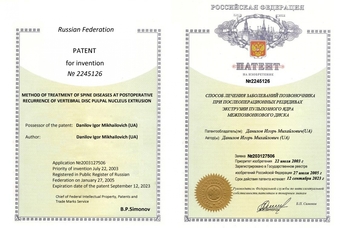
A patent is an example of an intangible asset with a limited life.
Patents are an example of intellectual property. If a firm does not own intellectual property relevant to the industry, that could prove to be a significant barrier to entry into that market.
Barriers to Exit
Barriers to exit are obstacles in the path of a firm which wants to leave a given market or industrial sector. These obstacles often cost the firm financially to leave the market and may prohibit it doing so. If the barriers of exit are significant; a firm may be forced to continue competing in a market, as the costs of leaving may be higher than those incurred if they continue competing in the market. The factors that may form a barrier to exit include:
- High investment in non-transferable fixed assets: This is particularly common for manufacturing companies that invest heavily in capital equipment which is specific to one task.
- High redundancy costs: If a company has a large number of employees, employees with high salaries, or contracts with employees which stipulate high redundancy payments, then the firm may face significant cost if it wishes to leave the market.
- Other closure costs: Contract contingencies with suppliers or buyers and any penalty costs incurred from cutting short tenancy agreements.
- Potential upturn:Firms may be influenced by the potential of an upturn in their market that may reverse their current financial situation.
